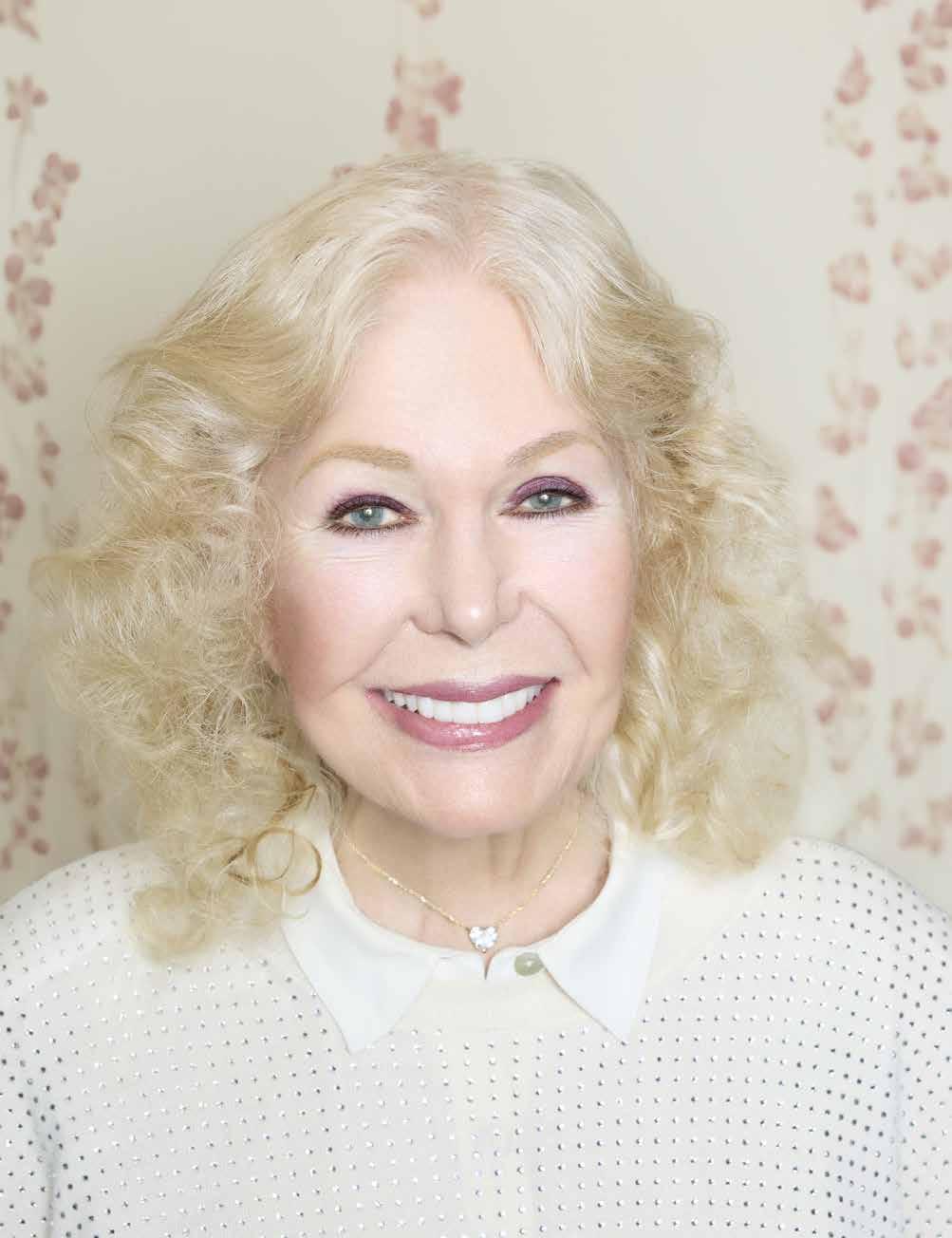

ELYSIAN
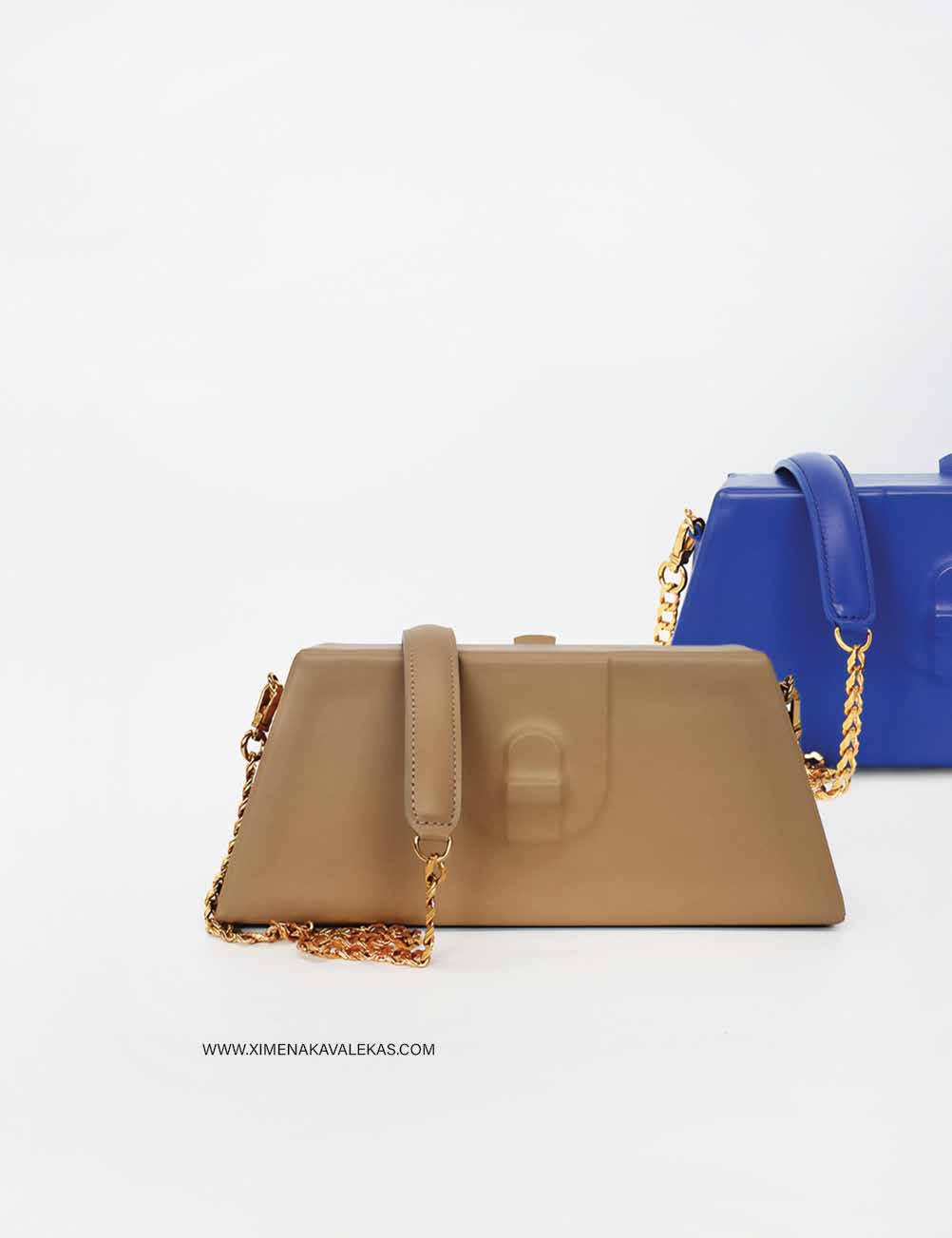
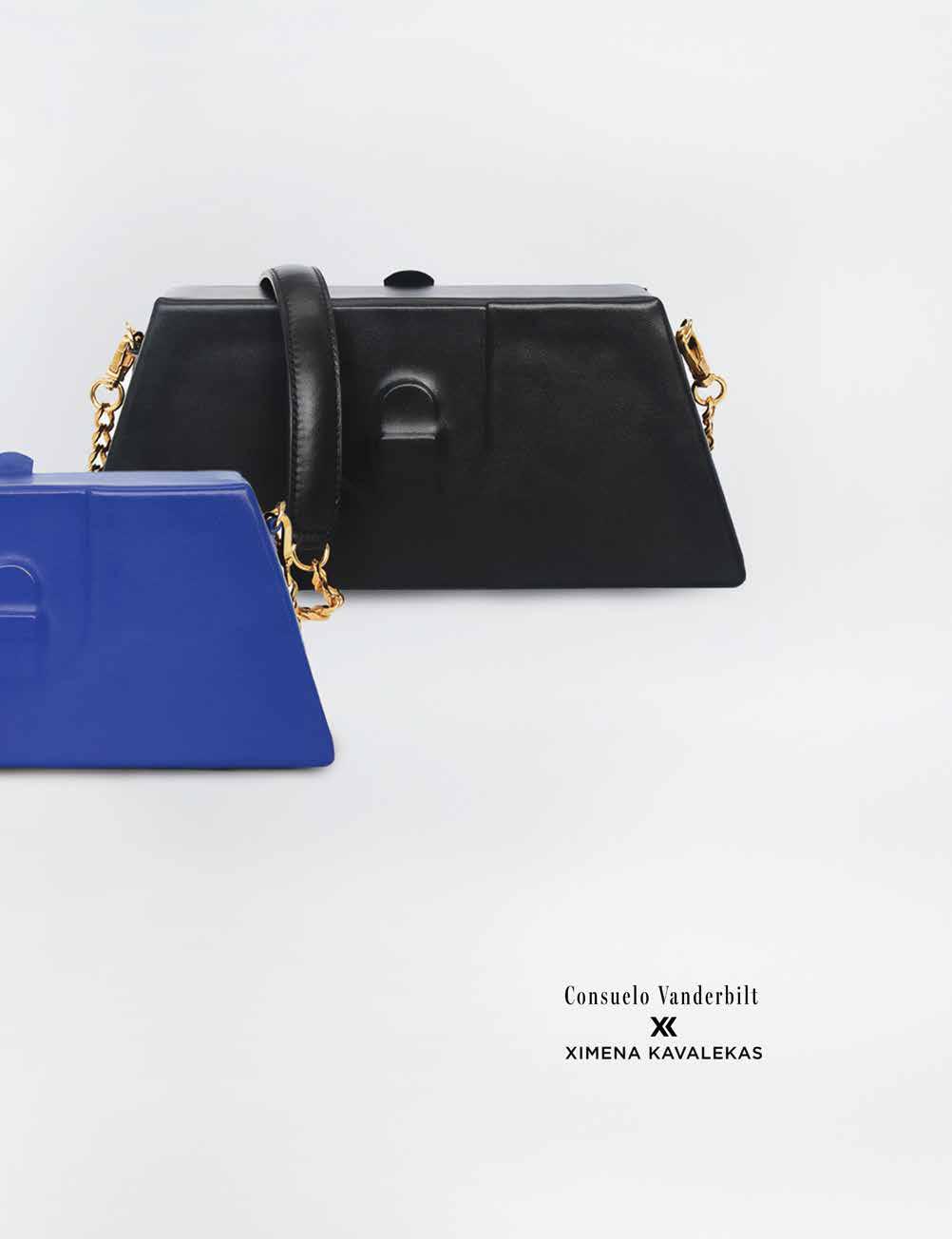

CYBER GIRL 2 BY ARTIST AND JEWELRY DESIGNER CLAIRE FLORENCE






danahareldesign.com

82 an Unfurgettable Occassion
la noyée
MODEL, ACTRESS & RECORDING ARTIST JANE BIRKIN. BY
SUZANNE JOHNSON
FASHION MEETS ANIMAL WELLFARE AT ELYSIAN’S CATWALK FURBABY 2025. BY SAMANTHA PAIGE
PHOTOGRAPH
VOLUME 11 • ISSUE 1 THE PET & PHILANTHROPY ISSUE / L’ÉDITION SUR LES
ANIMAUX DE COMPAGNIE ET LA PHILANTHROPIE
PRINTEMPS 2025
Eccentricities of a Cat Artist
OTHE REMARABLE LIFE OF LOUIS WAIN. BY MARCY DUBROFF

Women
Kelly Nichols page 160
Kimberly Word page 170
INTERVIEWS BY KAREN FLOYD
hollywood & icons
Fur-tastic Fame: The Secret Lives of Celebrity Pets - BY ELIZABETH BRADFORD
art & history
The Horse In Art - BY DOROTHEA PHILIPS
architecture & interiors
Birds & Animals on the Walls - BY CHRISTY NIELSON
pet & philanthropy
Adopt! Don’t Shop - BY JUNE MITCHELL
philanthropy
Tippi Hedren’s Shambala Preserve: A Fearless Connection with Wildness - BY TOBY MAXWELL
health & wellness
Elevating Pet Wellness: The Bill and Coo Journey - BY SONIA HENRY
In a world fraught with division and suffering, ELYSIAN stands steadfast in its mission to inspire hope, ignite progress, and bring the light of peace to all.
Actress & philanthropist Loretta Switt.

Some Things To Bark About - BY SINDIE FITZGERALD-RANKIN
Karen Floyd
Amber Edwards
Joey Iannetta
Eric Nodine
Michael Paniccia
Jason Spencer
Boone Peeler
Marcy Dubroff
Brenna Kehew Sculley
Ryan Stalvey
Anna Christian
Kimberli Scott Still
Don Bailey
Joy Smallwood
Becky Kerr
Garrick Lane
Elliot Derhay
Christiana Purves
Rita Allison
elysian is proud to feature our updated ios app, redesigned from the ground up to maximize your experience — download now in the app store to read and view exclusive elysian content, watch livestreams and participate in our special events production Nicola Doring
Sarah Smith
Michelle Young
Aidan Stanton
Elizabeth Bradford, Marcy Dubroff, Sonia Henry, Suzanne Johnson, Toby Maxwell, June Mitchell, Christy Nielson, Samantha Paige, Dorothea Philips, Sindie Fitzgerald-Rankin
Nancy Brady, Monya Havekost, Diane High, Hadley Inabinet
Norah Lawlor
Joe Giuffrida/Mega Mailers
Greg Wolfe
Carmel Fauci

breton

IPivot
I ALONE CANNOT CHANGE THE WORLD, BUT I CAN CAST A STONE ACROSS THE WATER TO CREATE MANY RIPPLES.”
—MOTHER TERESA
learned a long time ago that a small number of passionate people who coalesce around a greater purpose can make large impacts. I also believe that much like . . . ripples create waves, and waves create change . . . caring for our most vulnerable is humanity’s collective and shared responsibility.
While the story behind CatWalk FurBaby is too lengthy for this Publisher’s letter, there are two words that come to mind as to why it has endured the test of time: pivot and gratitude.
To grow and build, we chose to pivot. So . . . what do philanthropy, animals, competition, designers, models, and fashion have in common? WOMEN. Our first year resulted in an award-winning documentary, coffee table book, dedicated magazine, and runway show event exposure of 1B broadcast views.
Women are multi-dimensional and have complexity in their philanthropic breadth of interest. For that reason, ELYSIAN Impact saw no boundaries or obstacles in creating a dynamic experience for philanthropic causes in five verticals as opposed to just one. The sheer range of the charities represented on this year’s runway was breathtaking and included animals, children, environment, service, and women. From Washinton State to California, Florida, Texas, Tennessee, South Carolina, North Carolina, New York, and beyond, these charities touch so many aspects of our daily lives, whether that involves pairing an abandoned pet with a forever home, funding cancer research, or advocating for alternatives to detention for at-risk youth.
The first year’s focus was largely centered around fundraising, with the winning animal rescue benefiting financially from the competition. In year two, we again pivoted. We expanded our perspective on fundraising goals from dependency to selfreliance. The concept was simple, “to teach a man how to fish . . . and you feed him for a lifetime . . .” From the success of the award-winning documentary in the first year, the goal of the second year is to allow the second documentary to be used by all participating charities, allowing them to fundraise from “Everything CatWalk FurBaby” . . . from the second annual coffee table book sales to documentary private showings ticket sales…event sponsorships and more.
Finally, in one year, numbers doubled in both print and broadcast viewership, with just the event exposure growing from 1B to 2B broadcast views. Was this from increasing participants from 10 to 20 teams or the momentum from a second-year trajectory? No one really knows. What we do know is that these incredible results are largely because of you.
Gratitude
What a privilege it is to . . . work with the ELYSIAN Impact team which is impassioned about protecting and improving the lives of animals, children, the environment, service, and women. Executive Director of ELYSIAN Impact, Kimberli Scott Still’s steady hand and relentless perseverance doubled the participating charity numbers. Ryan Stalvey, our Creator-In-Chief, assembled content and oversaw writers Jason Spencer and Merci Dubroff for our quarterly publication and an award-winning coffee table book. Amber Edwards, our Chief of Marketing, built the brand literally, from inception to distribution of multiple millions, and Joey Iannetta, our IT partner and project manager, not to mention the actual producer of the show. Nicola Doring, Garrick Lane, Bobby Nicols, and Dutty Vanier filmed and edited for months. The result is shown in a private viewing held in New York City’s National Arts Club. I am grateful to every ELYSIAN teammate whose names are found on the masthead, making ripples . . .
The team was not complete without our Signature partners, DRC Ventures, Merci Dupre Clothiers, Bill & Coo, and The Root Brands. They worked tirelessly and contributed their time, treasure, and talent to benefit philanthropies throughout the world. Led by Dr. Christina Rahm, whose innovation and creativity of Merci Dupre Clothiers graced the runway, the audience was spellbound by her design elegance and environmentally sustainable creations.
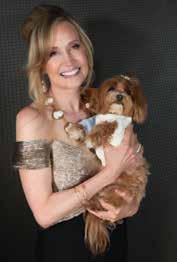
And finally, the enigmatic Fern Mallis, our emcee and founder of New York Fashion Week, who stole the show with her quick wit and charm. The team included sponsors Dr. Kimberly Word, BioLight, our 20 charity participants, and esteemed judges Consula Vanderbilt (socialite and humanitarian), MarieBelle (businesswoman and chocolatier), and Carol Alt (world’s first supermodel). May the generosity of these ripples (teammates) serve as examples to others.
With that in mind, I want to end this Publisher’s letter with another quote from St Mother Teresa of Calcutta, “We ourselves feel that what we are doing is just a drop in the ocean. But the ocean would be less because of that missing drop.”
Join ELYSIAN, ELYSIAN Impact, and the ELYSIAN Circle, as in our small ways, we collectively can change the world together.
With much love

Karen Floyd Publisher

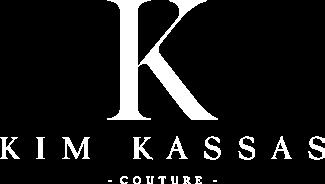
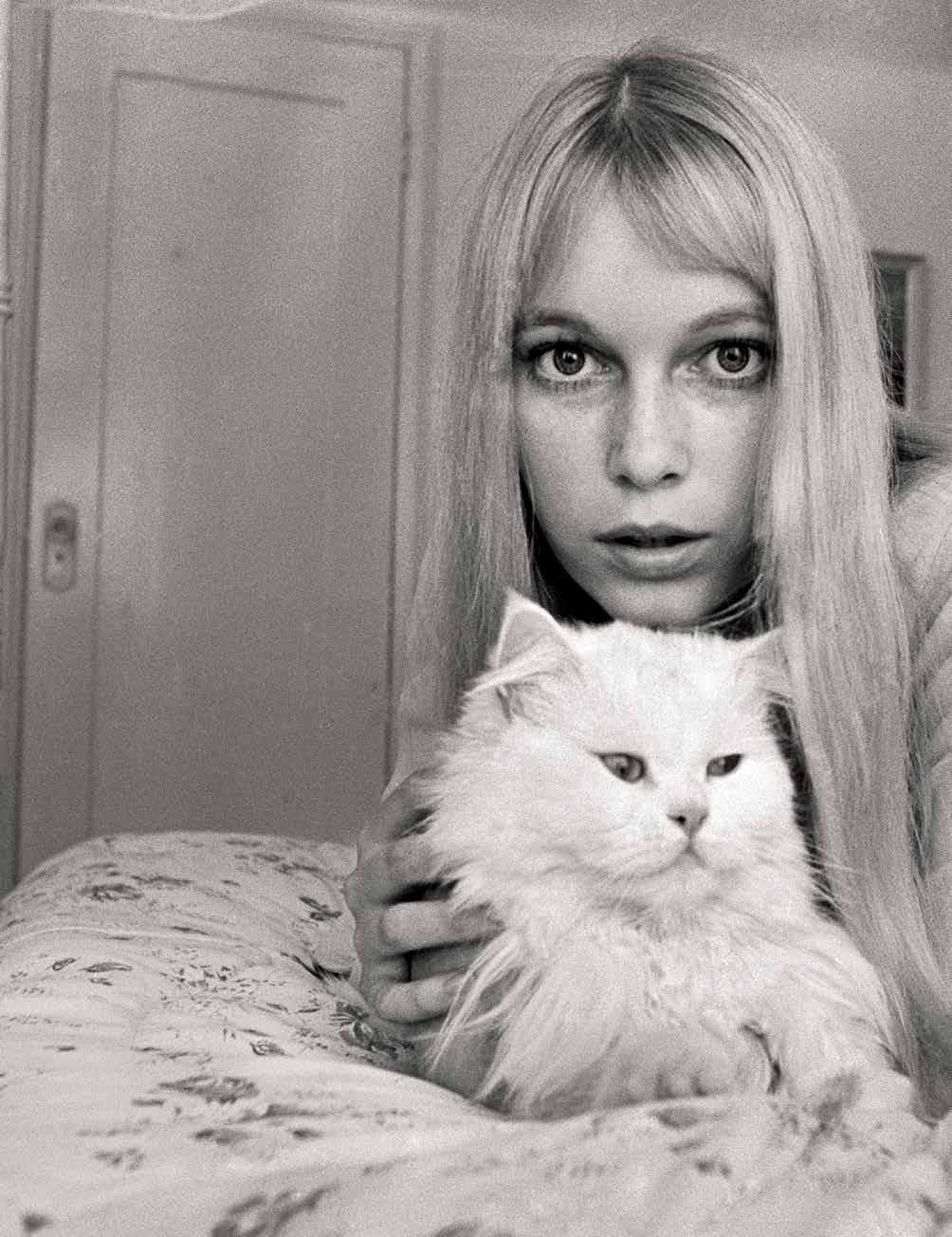
American actress Mia Farrow, photographed in1964 with her beloved cat, Malcolm. The cat was deaf and the two were inseparable throughout the young actress’s career, even appearing together in the Christmas episodes of the ABC tv series Peyton Place, episode #33 and #34.
PHOTOGRAPH BY HARRY BENSON/DAILY EXPRESS/HULTON ARCHIVE/GETTY IMAGES
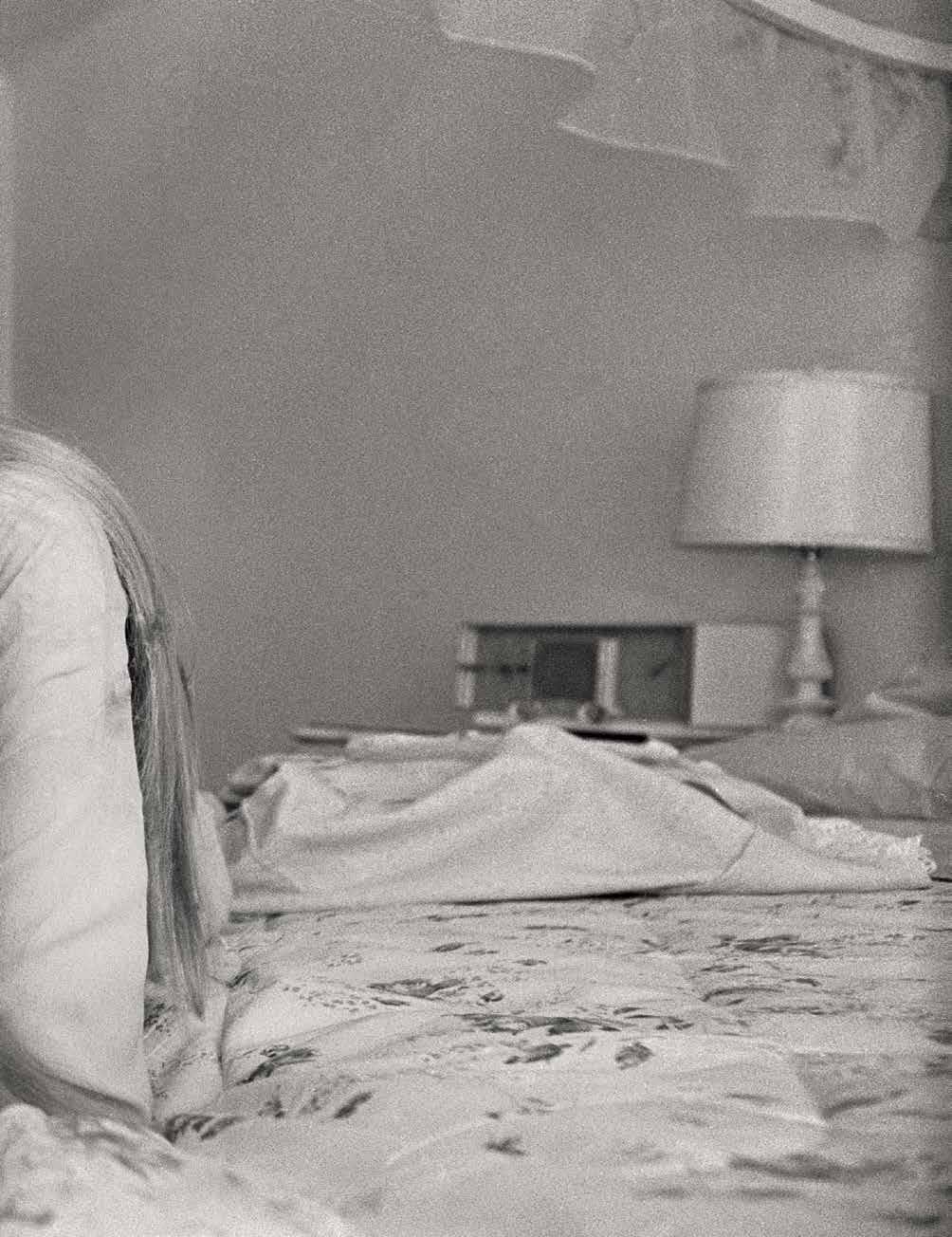
Furtastic fame: the secret lives of celebrity pets
BY ELIZABETH BRADFORD
the world of fame and glamour, it’s not just the soaring vocals, stunning roles, or impeccable red carpet appearances that capture our attention—many of music and Hollywood’s most famous actresses, models and songstresses also have an undeniable love for animals. From loyal dogs to exotic pets, the bond between these icons and their furry, sometimes feathered companions reveals a softer, more relatable side to the women we admire on the big screen, advertising campaigns, and concert arenas. Pets, after all, offer unconditional love, companionship, and comfort, something even the most famous stars need in their often hectic and public lives. The following is a snapshot of the special relationships between famous women celebrities and their pets. ■
Zsa Zsa Gabor poses for a portrait while feeding her pet sheep, “Laurelhighland Zsazsa,” at her home in Beverly Hills, California. The Valais Blacknose sheep was named after the Hungarian-born actress and socialite. The name “Zsazsa” is a Hungarian nickname for “Zhuzsanna,” which means “Susan.” The sheep’s sire, Balambér, was also Hungarian-bred, which was another reason for the name.
BY EARL LEAF/MICHAEL OCHS ARCHIVES/GETTY IMAGES
PHOTOGRAPH

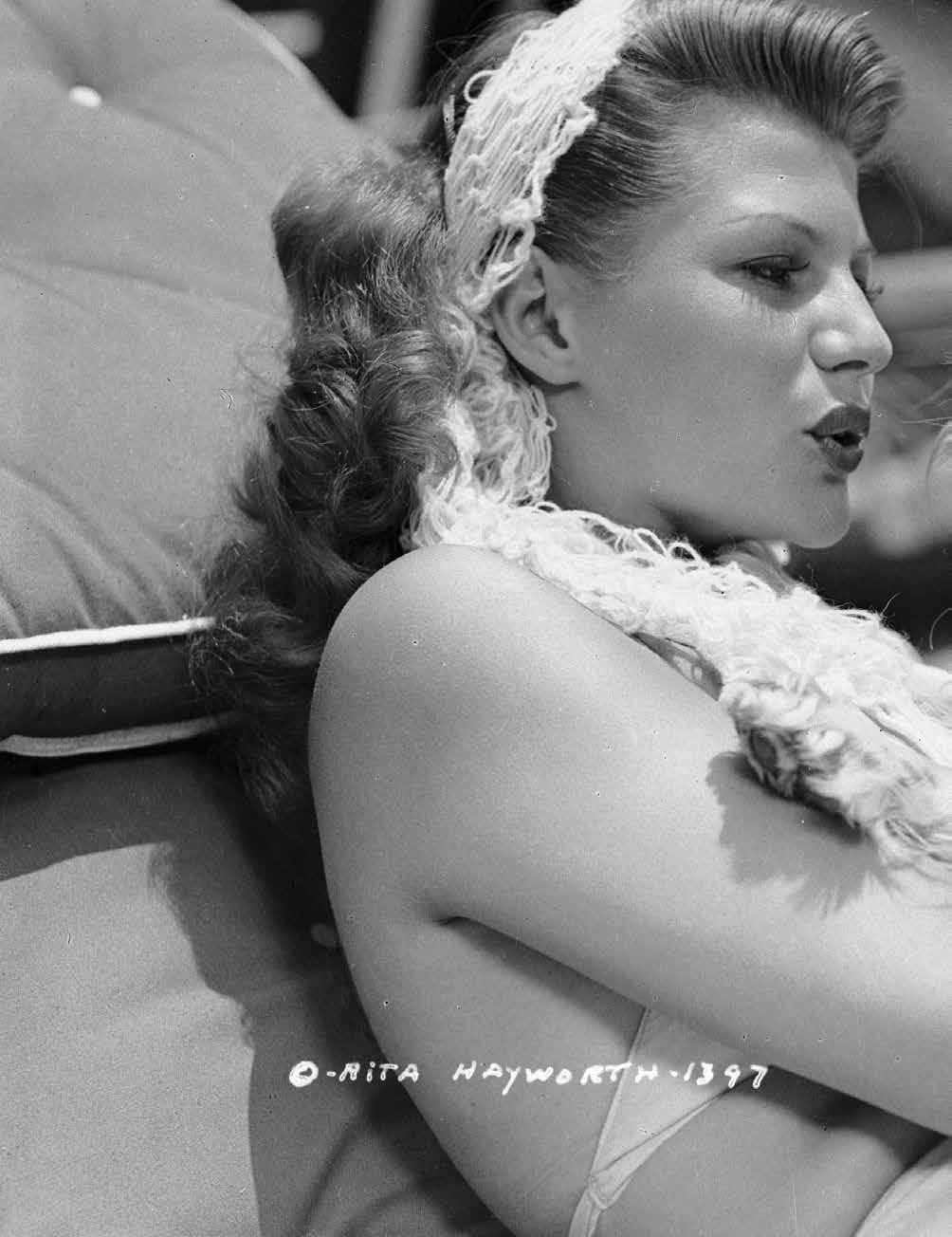

Rita Hayworth, poolside with her cocker spaniel, Pookles, 1946. PHOTOGRAPH VIA JOHN KOBAL FOUNDATION/GETTY IMAGES

Opposite: Billie Holiday, the legendary jazz singer, had a beloved pet bulldog named Mister. Known for her deep emotional connection to her dog, Holiday often spoke of Mister as a source of comfort during her tumultuous life. The dog was a constant companion, providing her with affection and companionship. Holiday, whose real name was Eleanora Fagan, was a dog lover who had many dogs throughout her life, including a beagle, a mutt, a poodle, a terrier, a Great Dane, and two Chihuahuas. However, many say that Mister was her canine soulmate.
American actress and singer Doris Day, sitting beside her son, Terry Melcher, and pet black poodle, circa 1950. A tremendous advocate for pet wellfare, she founded the Doris Day Pet Foundation, which focused on finding homes for the too many animals that were being destroyed simply because there weren’t enough good homes and advocating for spay/neuter. Her grassroots efforts resulted in Doris’ personally rescuing hundreds of animals over the years.
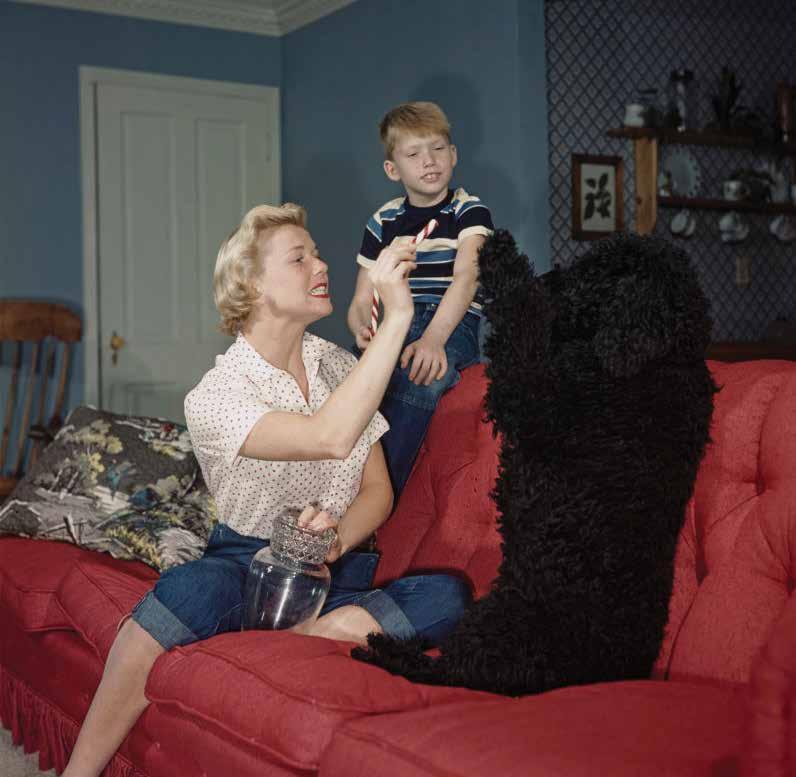
PHOTOGRAPH BY
PHOTOGRAPH BY PHOTO-FOX / ALAMY STOCK PHOTO
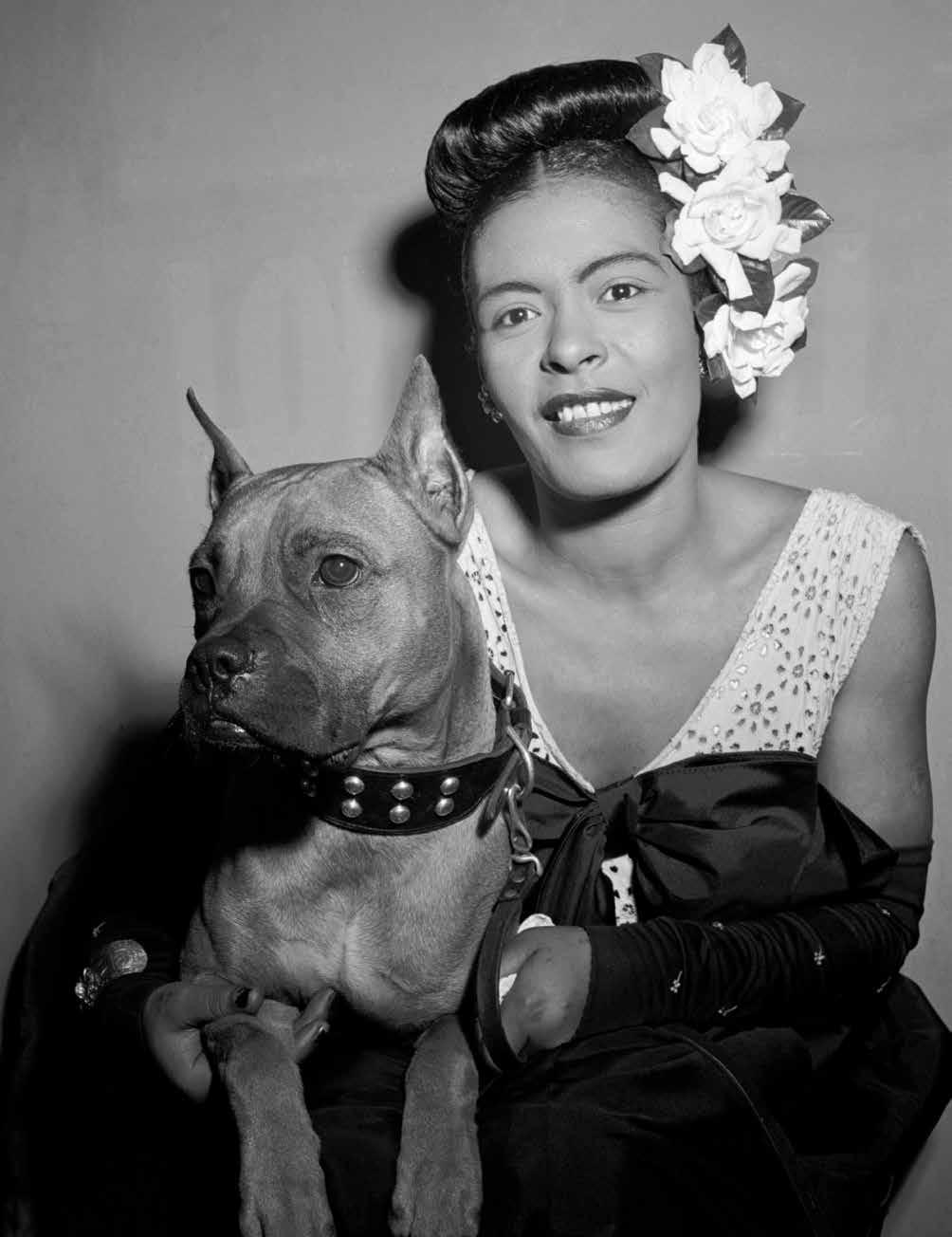
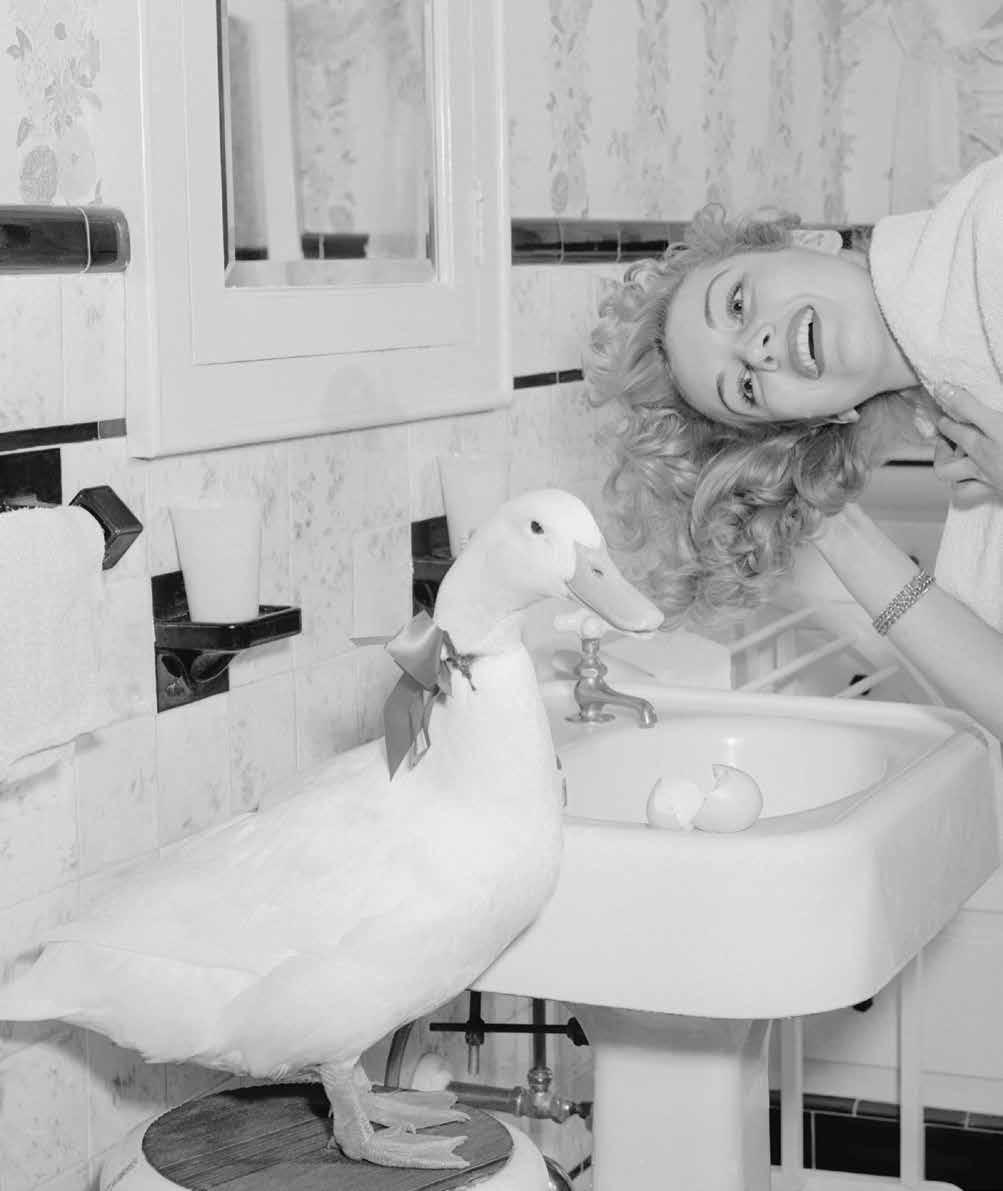
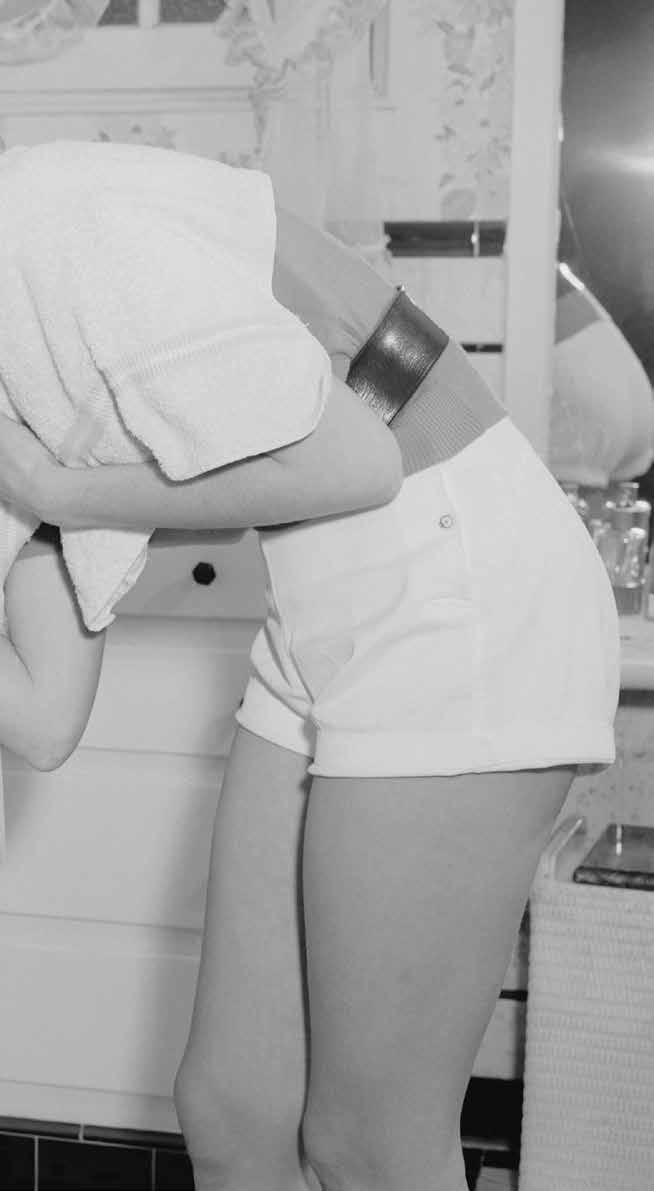
• printemps 2025 • l’édition sur les animaux de compagnie et la philanthropie • readelysian.com
Eggsposing a Coiffure Secret. Hollywood, California: They are calling Kathleen Hughes, Universal International actress, the “ducky blonde” since she revealed the secret of her luxuriant, shiny tresses. A daily duck egg shampoo, says Katie does the trick. The egg is provided by her pet duck, who lays one egg every day as a labor of love for Katie. The duck is looking on at the egg shampoo ritual here in her first personal appearance for the camera.
PHOTOGRAPH COURTESY BETTMANN / CONTRIBUTOR / GETTY IMAGES
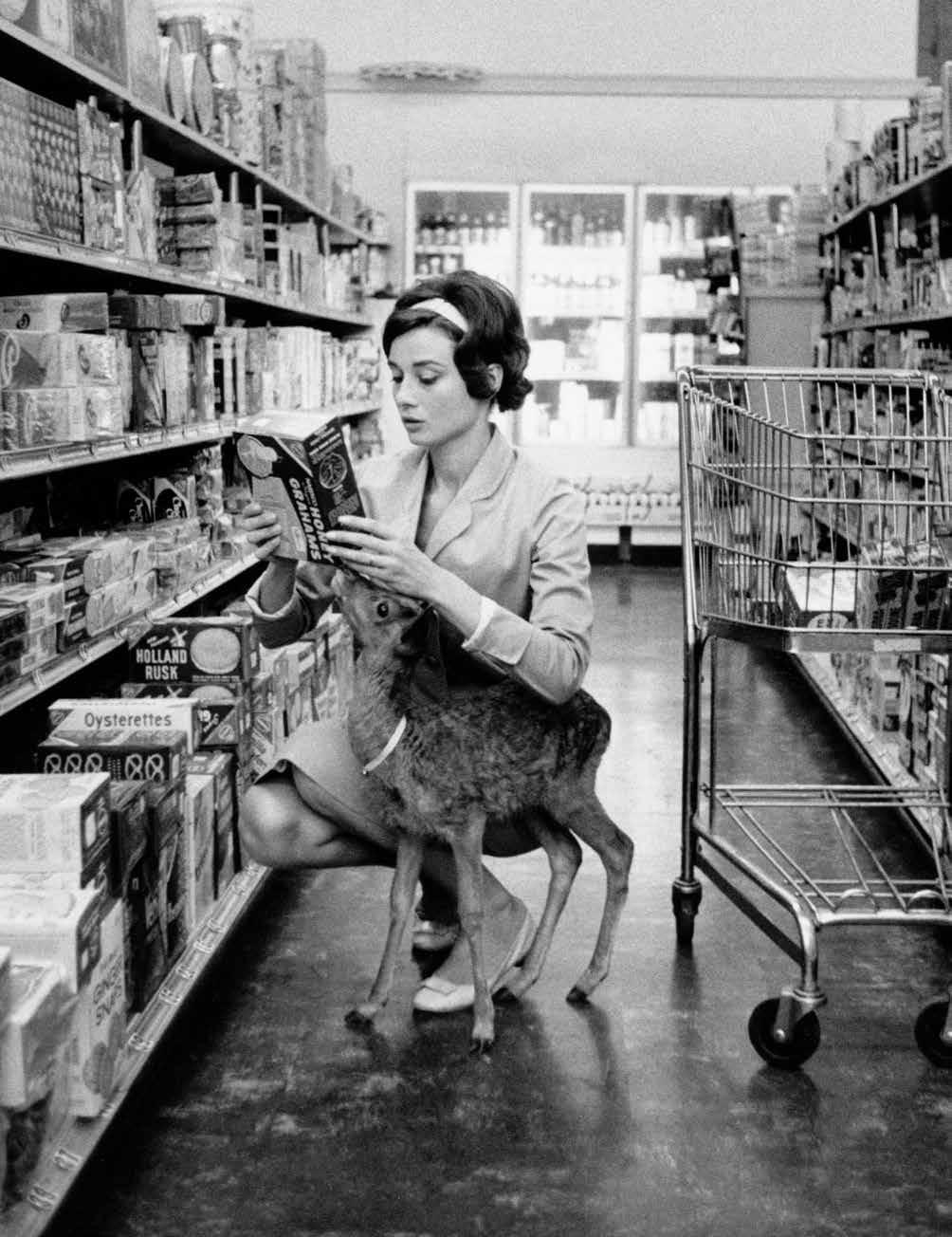
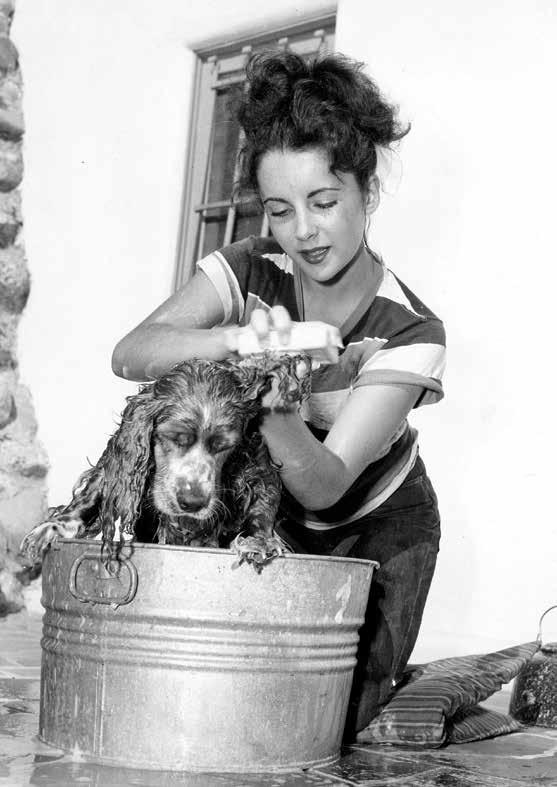
Audrey Hepburn, one of Hollywood’s most beloved and iconic actresses, is remembered not only for her timeless beauty, grace, and remarkable acting talent but also for her deep sense of compassion and kindness. While she may be most famously associated with roles in films like Breakfast at Tiffany’s and Roman Holiday, Hepburn’s love for animals, particularly a pet deer named Pippin, also called Ip, is a lesser-known but equally heartwarming chapter of her life. She acquired the fawn while filming the 1959 movie Green Mansions, a film directed by her then-husband Mel Ferrer. Her character in the film had a special bond with a baby fawn, so she took the fawn home with her to Los Angeles. Pippin, a delicate and graceful creature, became a constant companion for Hepburn even during her time in Italy. The pet deer was treated as a cherished family member and would often be seen wandering freely on her estate. Hepburn’s affection for Pippin went beyond merely owning an exotic pet—she developed a genuine, deep bond with him. In interviews, she often described Pippin as a calming presence, one that brought her immense peace and comfort, particularly when the demands of her public life felt overwhelming.
PHOTOGRAPH CORTESY
Seventeen-year old Elizabeth Taylor washing her Cocker Spaniel, Amy.
PHOTOGRAPH BY EDWARD ROTH / ALAMY STOCK PHOTO

Jayne Mansfield was a dog lover., and usually would have them along with her at various promotional and press events. When Jayne died in the terrible car crash on June 29, 1967, two of her beloved chihuahuas, Precious Jewel and Emerald, died with her.
PHOTOGRAPH BY


Marilyn Monroe with her Basset Hound Hugo in 1957 at her home in Amagansett, New York. She acquired him while married to her third husband, playwright Arthur Miller. Monroe was a big animal lover and owned many dogs throughout her life, some of her other dogs included Tippy, Ruffles, Muggsie, Josepha, and Maf. Each dog was a completely different breed and she loved them dearly, the actress is quoted,“sometimes even more than people!”
PHOTOGRAPH BY SAM SHAW/© SHAW FAMILY ARCHIVES/GETTY
French entertainer and civil rights campaigner, Josephine Baker, had a pet cheetah named Chiquita. Adorned with a diamond collar, Chiquita was also a co-star in Baker’s performances.
PHOTOGRAPH BY PICTORIAL
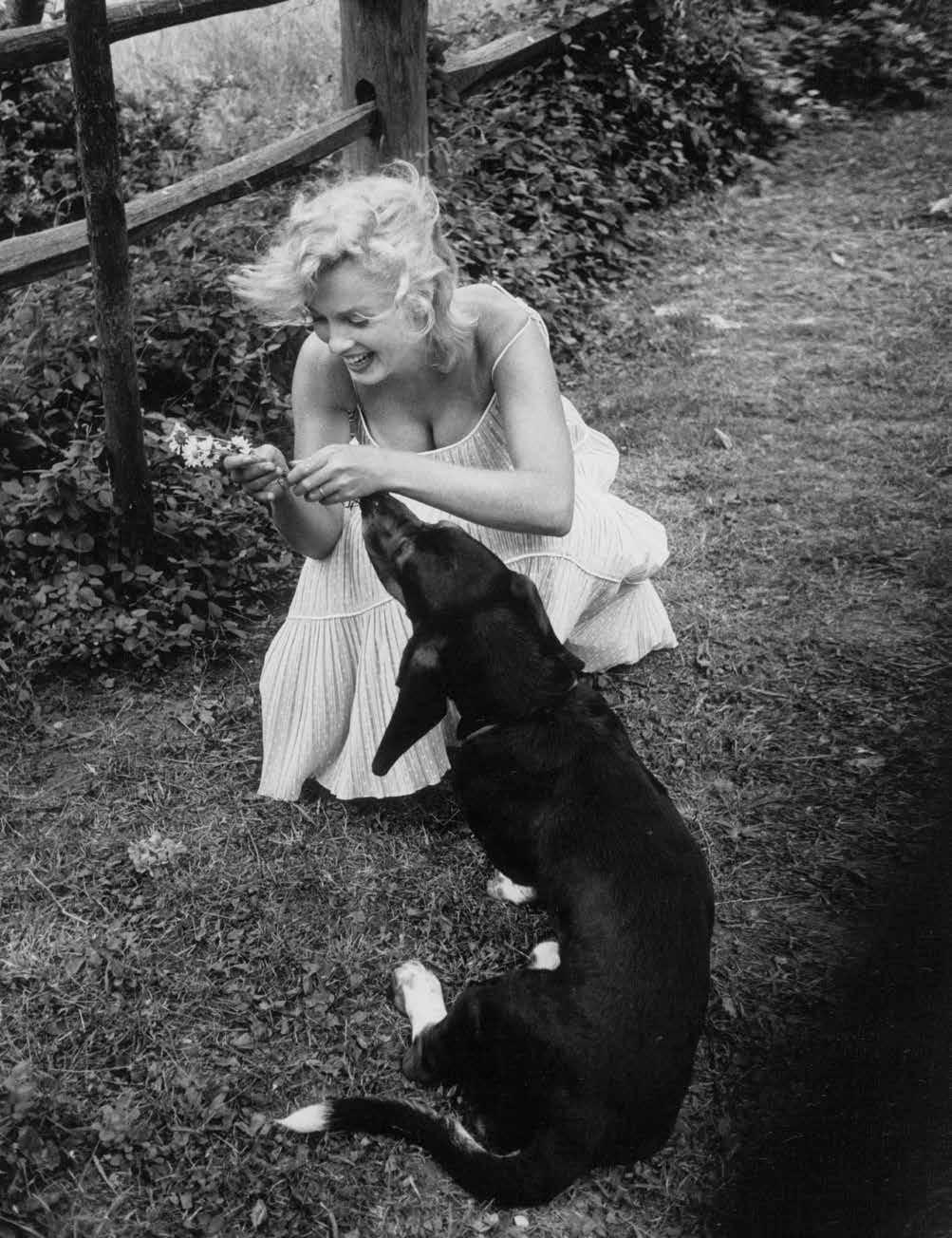
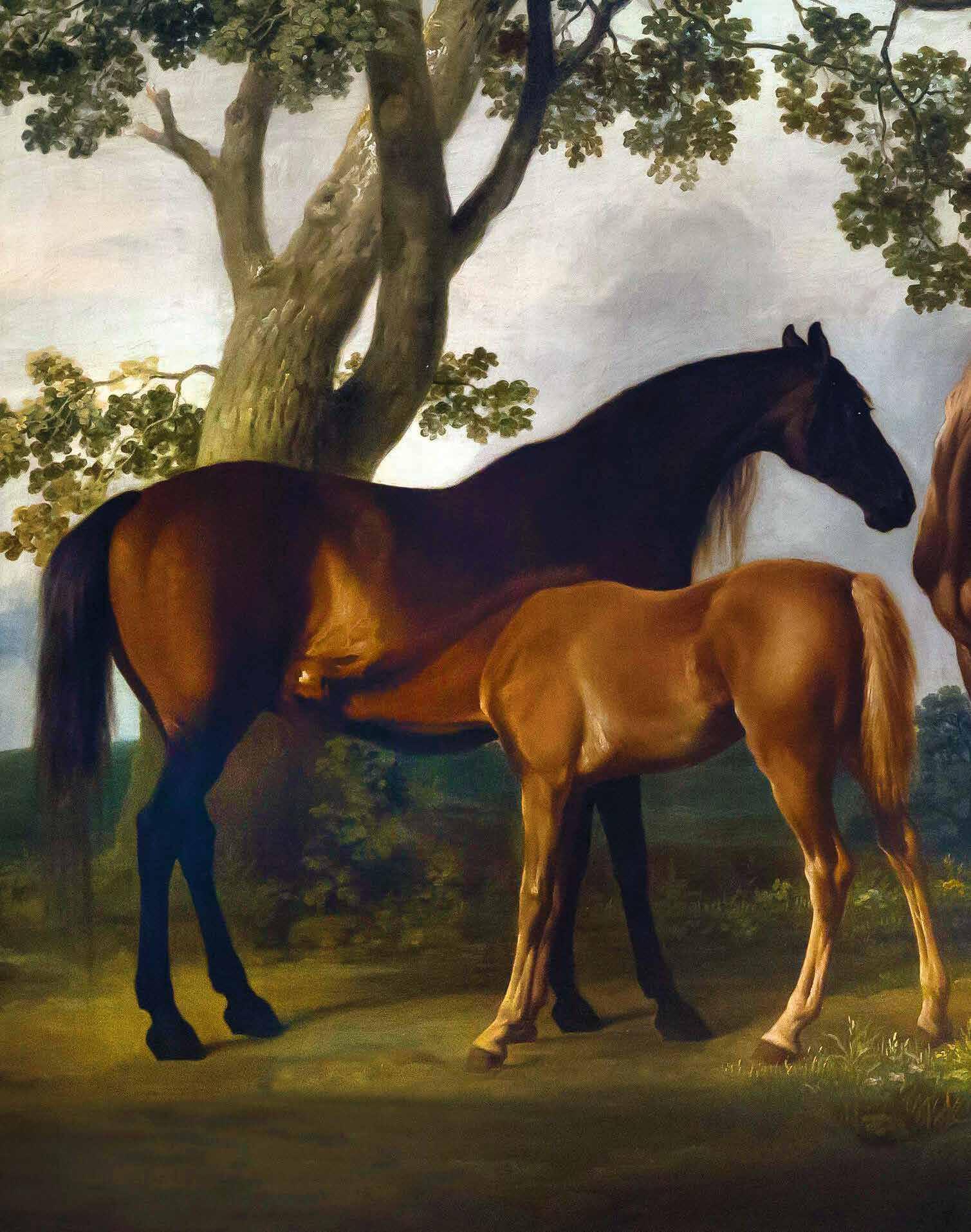
Mares and Foals in a River Landscape, by George Stubbs, circa 1763-8. George Stubbs ARA was an English painter, best known for his paintings of horses. PHOTOGRAPH
art&history
horse in Art
BY DOROTHEA PHILIPS

sur les animaux de compagnie et la philanthropie
ew creatures have been as integral to human civilization as the horse. Their grace, strength, and intelligence have shaped societies and inspired countless works of art. The horse occupies a singular position in human history, embodying the intertwining of utility and beauty. With its sleek physique and dynamic presence, this majestic animal has left an indelible mark on art, culture, and war, symbolizing power, freedom, and a deep bond with humanity.
The Role of the Horse in Art History
Horses have been a recurring motif in art, from the earliest cave paintings to contemporary works. These animals symbolize more than just physical beauty; they have come to represent nobility, speed, and the interplay between humanity and the natural world. The earliest known depictions of horses date back to the Paleolithic era, as seen in the Lascaux Caves of France. These ancient vivid portrayals of horses running and grazing are a testament to their importance in prehistoric life and their aesthetic allure, inspiring early humans to capture their essence on walls lit by firelight.
Throughout history, the horse’s image has continued to evolve in art. Ancient civilizations like the Greeks, Romans, and Chinese frequently used equine imagery to signify power and divinity. In ancient Greece, the horse-drawn chariot was a common artistic motif often associated with gods like Apollo. The famous Parthenon frieze depicts horsemen in elegant procession, showcasing the significance of horses in Greek rituals and their aesthetic appreciation of equine form.
The Renaissance renewed the focus on horses in art, emphasizing anatomical accuracy and grandeur. Leonardo da Vinci’s unfinished Gran Cavallo (a monumental bronze horse) exemplifies the Renaissance’s fascination with capturing the animal’s physical perfection. Meanwhile, artists like Albrecht Dürer and Peter Paul Rubens painted horses with dramatic intensity, showcasing their movement, musculature, and interaction with humans.
Famous Equine Artists
Several artists have specialized in equestrian subjects, creating works that captivate art enthusiasts. One of the most prominent names is George Stubbs, an 18th-century British painter known as the “father of equine art.” His meticulous studies of horses, such as Whistlejacket, demonstrate his technical precision and ability to convey the horse’s personality and majesty. Stubbs’s works go beyond mere
The Horsewoman, Portrait of Giovanina and Amacilia Paccini, wards of Countess Samoilova, by Karl Pavlovich Bryullov, 1832. Bryullov, the Russian painter, is regarded as a key figure in transition from the Russian neoclassicism to romanticism.
• printemps 2025 • l’édition sur les animaux de compagnie et la philanthropie • readelysian.com


printemps 2025 • l’édition sur les animaux de compagnie et la philanthropie • readelysian.com

At the Races in the Countryside or Carriage at the Races is an 1869 oil painting by the French Impressionist painter Edgar Degas. Degas depicts both portrait and landscape in this scene of upper-class leisure, whereby three jockeys and horses sprint mid-race within the sparse Normandy landscape while the subject of this painting, an intimate scene of a family, is taking place in the foreground. This small but complex painting was among the artist’s contributions to the first Impressionist exhibition in 1874.

Study Of A Horse, by Leonardo da Vinci, circa 1490. Both the horse and the draughtsmanship are delicate and slightly nervous, a common trait of Leonardo’s earliest studies.
The White Horse (1898) by Paul Gauguin. Gauguin painted this famous picture during his second stay in Tahiti. The “white” horse (whose movement seems like the symbolic gesture of a pawing Pegasus out of Redon’s imaginative art), is painted in grayish-green hues, perhaps, because of the overhead light being filtered through the tropical leaves. Unlike the brown horse, the white horse is riderless, isolated in an otherwise active composition, this mystery and strangeness spreads, and suffuses the whole painting.
representation; they elevate the horse to a near-mythical status, reflecting its revered place in British culture. In the 19th century, French artist Édouard Manet captured the modern horse with innovative brushwork and composition. At the same time, his compatriot Edgar Degas explored equestrian themes through his dynamic depictions of racehorses and jockeys. These Impressionist interpretations often emphasized movement and the interplay of light, encapsulating the vivacity of the horse in action.
More recently, artists like Deborah Butterfield have used horses as subjects to explore abstract and contemporary themes. Butterfield’s sculptures, made from driftwood and metal, capture the essence of the horse’s form while challenging traditional notions of equine representation. Her work highlights the horse as a physical and symbolic entity, blending past and present in its timeless allure.
The Horse in War
The horse’s role in war cannot be overstated. Its speed, endurance, and strength were the cornerstone of military campaigns for centuries, giving armies a strategic advantage. The mounted warrior, or cavalryman, has been immortalized in countless artworks, from ancient bas-reliefs to grand oil paintings. These depictions often emphasize the horse’s courage and loyalty, qualities that have made it a revered companion in the chaos of battle.
During the Middle Ages, knights on horseback became iconic figures, their steeds often adorned with elaborate armor. This imagery is captured in masterpieces like the Battle of San Romano series by Paolo Uccello, where horse and rider interplay conveys the chaos and pageantry of medieval warfare.
Horses were not just tools of war but symbols of power and prestige. The equestrian portrait became a popular genre among European monarchs and leaders. Notable examples include Anthony van Dyck’s portrayal of Charles I on Horseback and Jacques-Louis David’s Napoleon Crossing the Alps. These works emphasize the horse as an extension of human dominance and ambition, its grandeur reflecting the stature of its rider.
readelysian.com


Night-Shining White is a monochrome ink-on-paper painting by the Chinese artist Han Gan. It is an example of Tang dynasty painting, created in the middle of the 8th century (circa 750). The work depicts a cavalry horse owned by the Emperor Xuanzong (reign 712–56) of the Tang dynasty, tethered to a post. It is considered one of the greatest equine portraits in Chinese painting.
• printemps 2025 • l’édition sur les animaux de compagnie et la philanthropie • readelysian.com
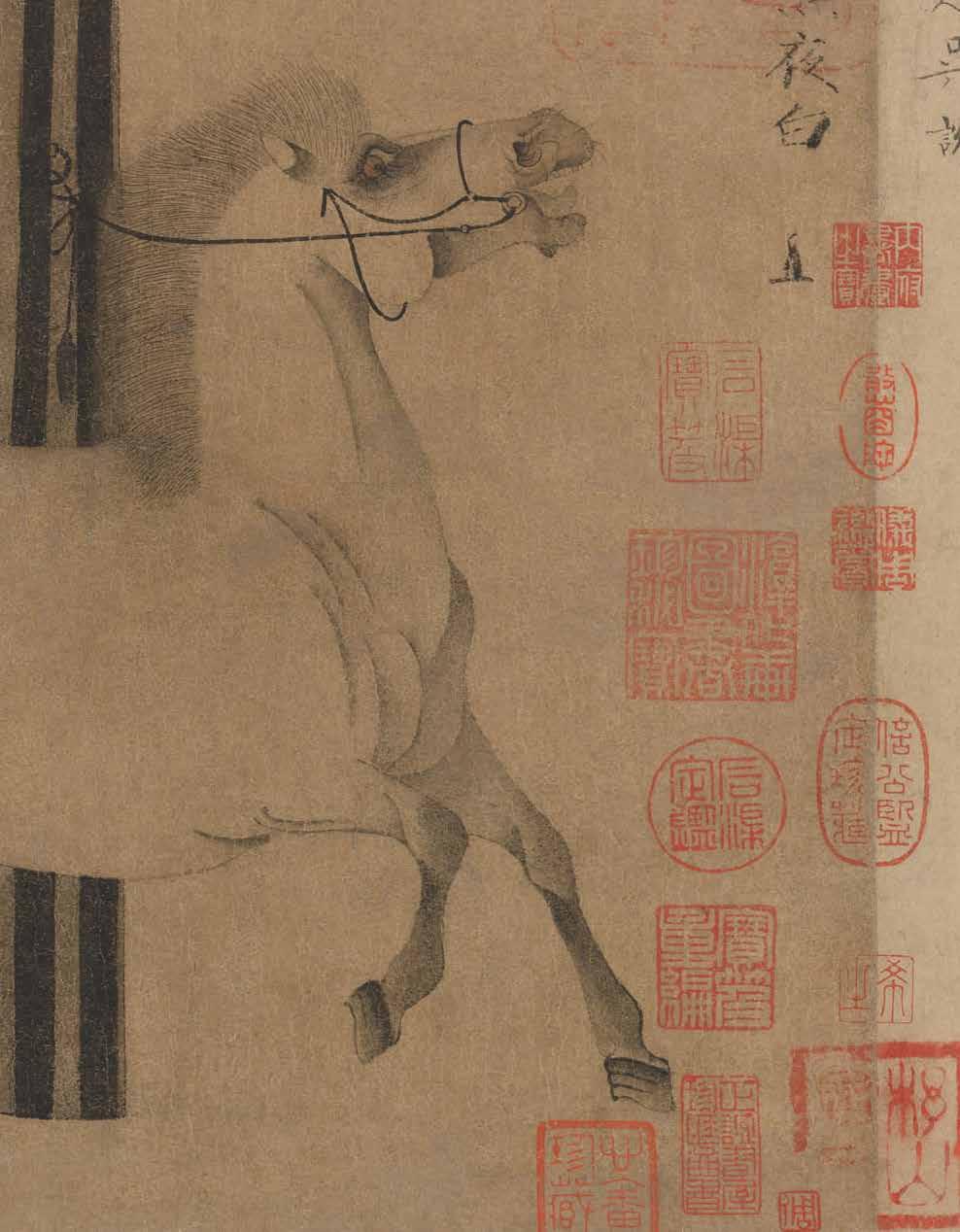
The artwork titled A Bullfight, created by esteemed artist Pablo Picasso in 1934, embodies the innovative approaches of Cubism and Surrealism. It is part of a series of paintings, drawings, and etchings produced by Picasso devoted to the subject of the bullfight, inspired by a trip to Barcelona. In A Bullfight, the tumultuous interaction between the matador and the bull is not just seen but felt, reflecting the dynamic and often brutal essence of the bullfight, of which, Picasso considered the rite of bullfighting as a parable of love and death.
La Femme au Cheval (Woman with a Horse, also known as L’Écuyère and Kvinde med hest) is a large oil painting created toward the end of 1911, early 1912, by the French artist Jean Metzinger (1883–1956). The work was exhibited in Paris at the Salon des Indépendants in 1912 and the Salon de la Section d’Or, 1912. The following year La Femme au Cheval was reproduced in The Cubist Painters, Aesthetic Meditations by Guillaume Apollinaire (1913).



The Horse in Culture & Mythology
Horses have also played a vital role in mythology and cultural symbolism. In Greek mythology, Pegasus, the winged horse, represents inspiration and the transcendence of earthly bounds. Similarly, the Norse god Odin’s eight-legged horse, Sleipnir, symbolizes speed and strength, capable of traversing the realms of gods and mortals. In literature, horses are often depicted as noble companions, reflecting their close bond with humanity. Anna Sewell’s Black Beauty is a poignant example, highlighting the horse’s role as both a laborer and a sentient, deserving of kindness and respect. This narrative raised awareness about horses’ mistreatment and underscored their emotional depth and individuality.
Beyond myth and literature, horses are integral to cultural practices worldwide. In India, the Marwari horse, with its distinctive inward-turning ears, is celebrated for its beauty and bravery, often featured in festivals and ceremonies. In the American West, the horse is an enduring symbol of freedom and frontier spirit, immortalized in the works of Frederic Remington and Charles M. Russell.


This Pre-Raphaelite portrayal of Lady Godiva and her well-known but apocryphal ride through Coventry, England, was painted by English artist John Collier, 1897. The painting, entitled Lady Godiva, was bequeathed by social reformer Thomas Hancock Nunn. When he died in 1937, the painting was offered to the Corporation of Hampstead. He specified in his will that should his bequest be refused by Hampstead, the painting was then to be offered to Coventry. The model in the painting is Mab (Mabel) Paul, an artist model and West End theatre actress who was also painted as herself by John Collier.
As a boy, Paulus Potter liked to wander around the countryside with a sketchbook, drawing farm animals, which became the primary subjects of his paintings. The Piebald Horse is a good example of how Paulus Potter painted portraits of animals. Before Potter, most artists portrayed animals as part of the background; he places them front and center and gives them personality. This horse may have been painted for its owner, probably a wealthy man who was very proud of his beautiful animal.
George Stubbs’s A lion Attacking A Horse can be interpreted as an allegory of intensely charged human interactions. Stubbs often painted domestic animals, but in expanding his practice in 1762 to depict wild animals, he became a leader in “sublime” themes in art. These confrontations between wild animals by Stubbs inspired later Romantic artists such as Eugène Delacroix and Théodore Géricault to depict similar scenes.
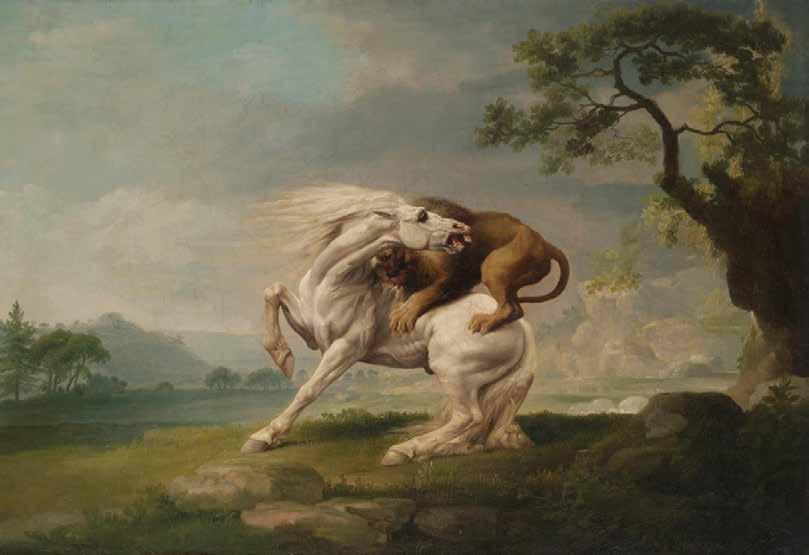
The Horse’s Beauty and Bond with Humanity
The beauty of the horse lies in its perfect harmony of power and grace. Its flowing mane, muscular frame, and fluid movement evoke a sense of awe that has inspired poets, artists, and dreamers for centuries. But beyond its physical attributes, the horse’s beauty is also found in its spirit—a blend of wild independence and gentle loyalty.
For many, the horse represents freedom. Its ability to run vast distances with unbridled energy has made it a symbol of escape and liberation. This imagery is powerfully captured in John Frederick Herring’s paintings of galloping horses, where the energy of the moment seems to leap off the canvas.
The bond between humans and horses is unique and built on mutual trust and respect. Unlike other domesticated animals, horses retain a sense of their wild origins, a reminder of nature’s untamed beauty. Yet, they willingly partner with humans in work, sport, or companionship. This relationship is beautifully depicted in Franz Marc’s The Large Blue Horses , where the vibrant colors and stylized forms reflect the deep emotional connection between human and animal.
The horse’s role in art, culture, and history is a testament to its enduring significance. As a symbol of power, beauty, and freedom, the horse captivates our imagination and inspires creativity. Its presence in art reminds us of the profound connections we share with the natural world, connections that transcend time and speak to the very essence of human experience. For those who adore animals and cherish artistic expression, the horse represents the ultimate muse—a living embodiment of strength, elegance, and the enduring spirit of life. ■
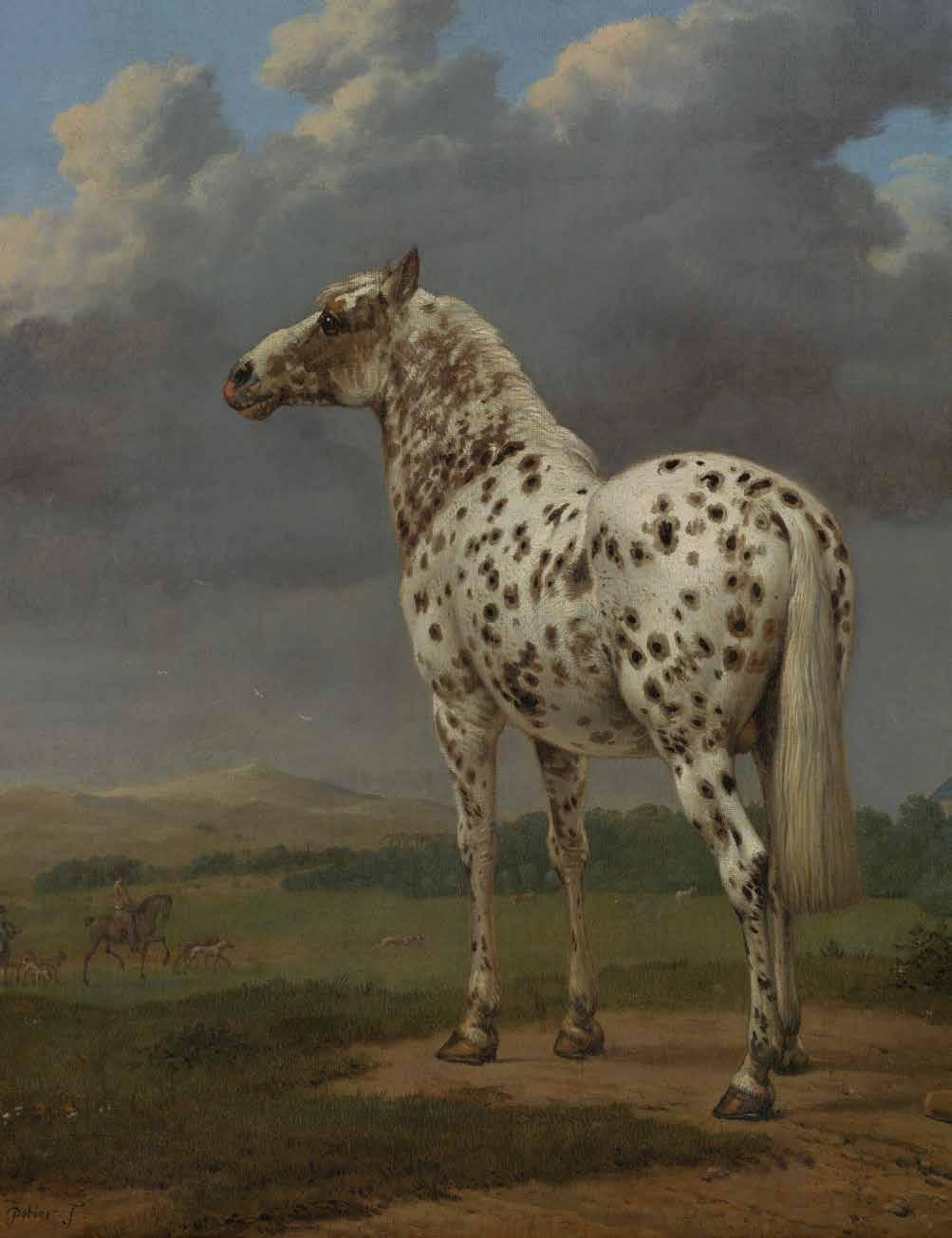

BIRDS & ANIMALS on the WALLS
BY CHRISTY NIELSON
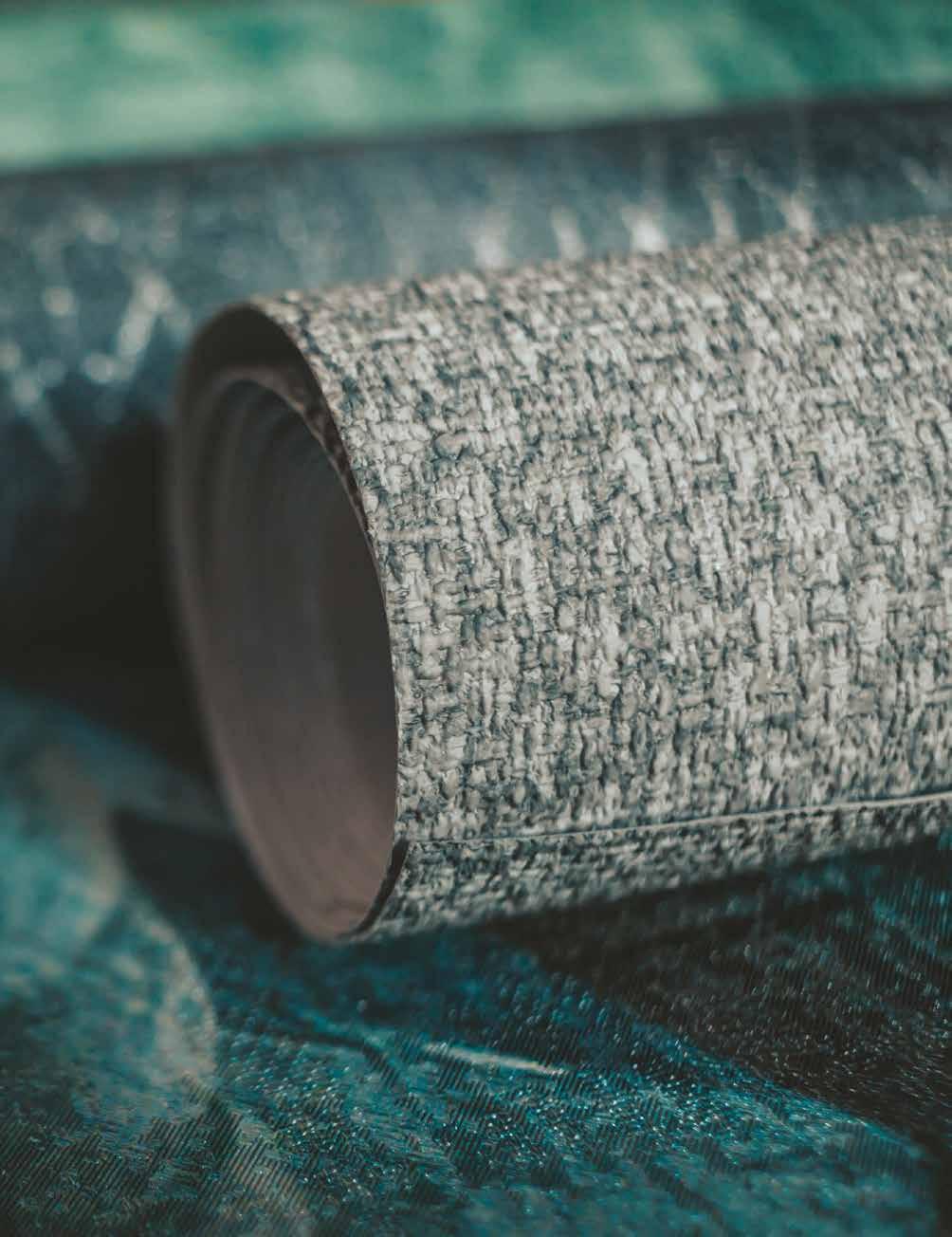
say wallpaper is having a moment would be an understatement. The on-trend design element—which for a time fell out of fashion as homeowners undertook the arduous process of ripping down dated wallpaper in favor of easier-to-manage and more minimalistic painted walls—has returned with a vengeance. Wallpaper has a long history dating back to the Qin Dynasty, the first imperial dynasty of China, when people pasted rice coverings to their walls.
Today’s wallcoverings have the unique ability to transform a room by adding depth, texture, and personality that paint alone might not achieve. Wallpaper can turn an otherwise mundane room into something memorable, captivating, and lively. It amplifies the voice of a design’s story. Whether speaking in the soft whisper of a subtle linen, the bold statement of a vivid geometric pattern, or something else in the in-between, wallpaper can really wow.
“Right now, there’s a strong move toward maximalism in wallpaper design—think bold patterns, intricate details, and unexpected textures,” says Arianne Bellizaire, CEO of Arianne Bellizaire Interiors. “People are craving designs that tell a story, whether it’s through hand-painted looks, metallic accents, or three-dimensional elements.”
Some brands like Zoffany, says Bellizaire, are masters at combining heritage with a modern sensibility.
“Christopher John Rogers’ collaboration with Farrow and Ball, for instance, delivers vibrant, dynamic patterns that feel fresh and fashion-forward,” she says. Bellizaire adds that Thibaut—the oldest wallcovering company in the U.S.—is another standout for its timeless yet trendconscious collections. “These brands succeed because they understand the art of balance—making designs that feel luxurious but still approachable,” she notes.
Lord Twig Wallpapers, Inc. offers wallcoverings that are restorations of the work of the famous English architect and designer Charles Francis Annesley (C.F.A.) Voysey (1857-1941). These Arts and Crafts patterns in traditional color palettes, as well as contemporary colorways in natural earthen tones, have charm and whimsy that imbue a room with a unique personality. “We concentrate on supplying craftsman homeowners with English Arts and Crafts designs; however, we are delighted that our wallpapers are also popular with contemporary homeowners and designers. Their style provides an


MY MOTTO IN LIFE IS ‘TAKE RISKS;’ YOU DON’T HAVE A VOICE IF YOU DON’T. YOU HAVE TO VENTURE OUTSIDE YOUR BOUNDARIES. THAT’S WHAT LIFE’S ALL ABOUT. RAWNESS AND REFINEMENT ARE NOT OPPOSITE ENDS OF A LUXURIOUS SPECTRUM... THEY ARE TWO COMPLEMENTARY FEATURES WITH WHICH TO POPULATE A LUXE ENVIRONMENT.”
—KELLY WEARSTLER KELLY WEARSTLER INTERIOR DESIGN / KWID
interesting juxtaposition with modern elements,” says Daniel Twig, owner of Lord Twig Wallpapers Inc.
Graham & Brown, a family-run business founded by two friends in the UK in 1946, is another iconic wallpaper manufacturer. The company’s Design of the Year 2025 is a pattern called Rivington Folly, which features “ancient trees drawing up through the landscape and enveloping the space.” The design is available in a range of hues from moody brown to mossy green, stately blue, and inky gray-black.
According to our experts, one of the main reasons wallpaper is trending is that people are really embracing color in design. “I would say that highly patterned, smaller-scale wallpaper is having a moment,” relates Sara Malek Barney, BANDD/DESIGN. She says Schumacher, as do Hygge & West, Lulie Wallace, and Work + Sea, always nails the latest trends.
Wallpaper is also being used in interesting and off-the-wall places. Hannah Goldberg of Hannah Charlotte Interiors says the practice of wallpapering ceilings is in vogue, be it in isolation or saturating an entire space in wallpaper. “It is a way to add extra impact, and it can be especially powerful in small or transitional spaces to draw the eye upward,” Goldberg points out.
She also notes that textured wallcoverings in natural materials like linen, silk, seagrass, and grasscloth, which have been well-liked for quite a while now, are still increasing in popularity and will continue to do so. “Natural materials add warmth, texture, and a subtle, quiet luxury,” she explains.
Darla Bankston May, founder of Bankston May Associates (BMA), says another big trend in wallpaper is to use it in unexpected design details, like shelving. “This trend involves applying wallpaper to corners, nooks, and other overlooked spaces to add a surprising pop of visual interest and personality,” Bankston May describes. “By incorporating wallpaper in these unseen areas, designers are able to lift and transform small, often forgotten spaces and infuse them with a fresh, creative energy.”
There are many factors to consider when selecting wallpaper: decisions that go beyond color to pattern, texture, and how these elements interact with the architecture, furnishings, lighting, and other finishes in a room. “Unlike paint, which is often a backdrop, wallpaper can become the focal point or create a subtle layer of sophistication,” Bellizaire says. She adds that striking the proper balance is key to success. “If the wallpaper is bold, let it shine by keeping furniture and décor more neutral.”
The size of your room will decide the print scale that is best to select. “A classic mistake is ignoring scale—a tiny powder room might feel claustrophobic with a large-scale pattern, while a spacious living room can beautifully showcase an expansive, dramatic print,” says Bankston May. “Always consider the room’s lighting, architectural features, and overall design narrative to ensure your wallpaper enhances rather than competes with the space’s inherent character.”
When incorporating wallpaper, look for patterns that echo the existing textures, like a subtle geometric wallpaper that mimics the angular lines of mid-century modern furnishings. “It’s like composing a visual symphony where each pattern must complement without overwhelming,” Bankston May describes. “Unlike paint, which provides a neutral ambiance, wallpaper introduces dynamic energy that interacts with furniture, textiles, and architectural details, so you’ll want to analyze scale, color intensity, and directional flow to ensure a cohesive aesthetic.”
Stairwell with geometric wallpapering by sought-after media personality Arianne Bellizaire, the CEO behind her full-service design firm, Arianne Bellizaire Interiors. PHOTOGRAPH
readelysian.com

printemps 2025 • l’édition sur les animaux de compagnie et la philanthropie • readelysian.com
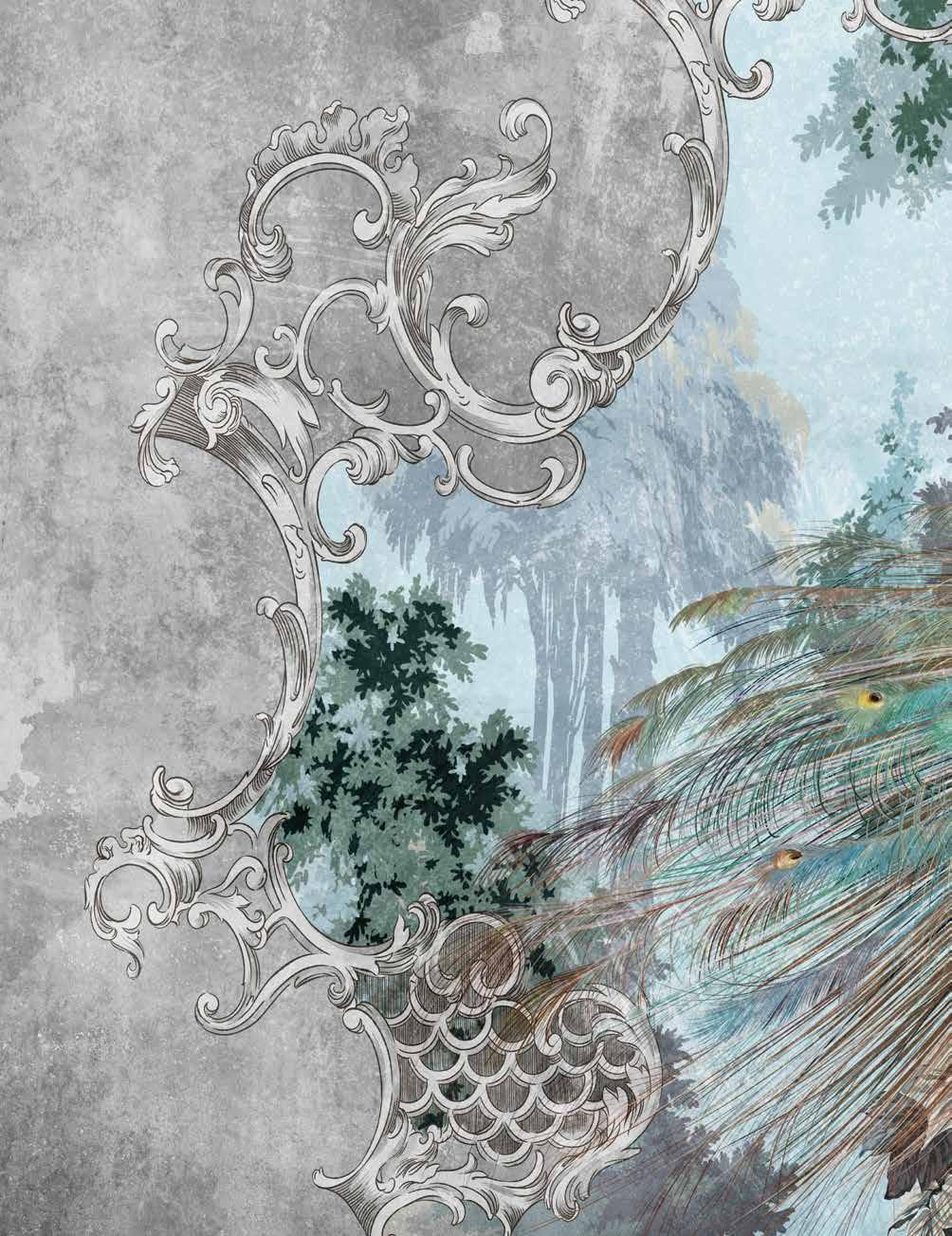
The correct pattern and color of wallpaper can act as an artistic canvas, telling a visual story that reflects personal style while simultaneously creating depth within a space, as with this hand-painted, peacockthemed, custom wallpaper. PHOTOGRAPH BY VIKTORIOUS_ART / SHUTTERSTOCK.COM

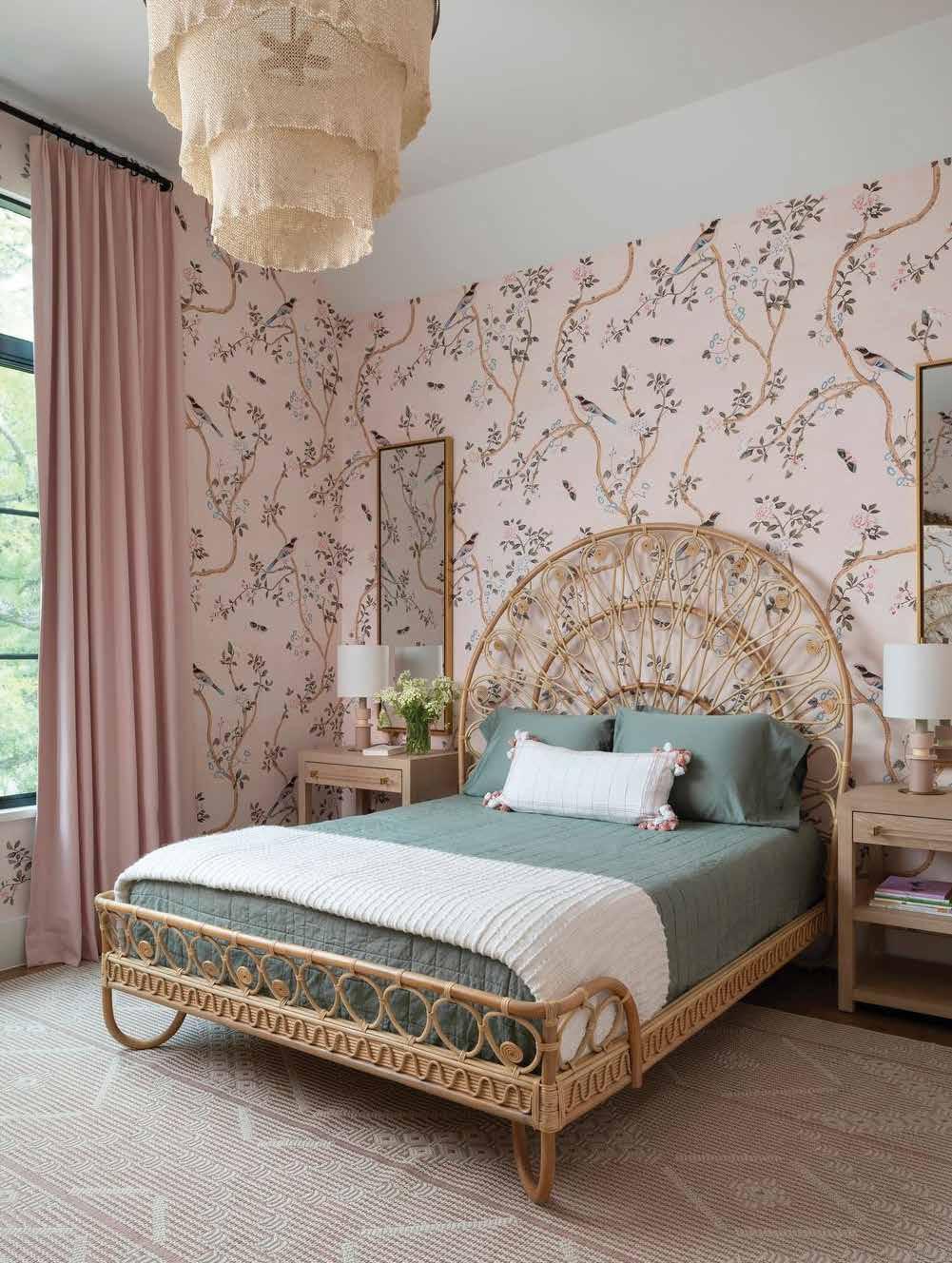

There are many factors to consider when selecting wallpaper: decisions that go beyond color to pattern, texture, and how these elements interact with the architecture, furnishings, lighting, and other finishes in a room.
Bankston May notes that it is also essential to avoid creating what she calls “visual chaos.” “Pairing a large, busy floral wallpaper with equally intricate upholstery can make a room feel overwhelmingly complex,” she explains. Instead, she recommends balancing dramatic wallpaper with solid, neutral finishings.
The function of the room is an important consideration, as well. “High-traffic spaces—or spaces with higher moisture such as bathrooms—require wallpapers that are more durable and easier to clean,” notes Goldberg.
The construction of your wall is something you cannot overlook when choosing a wallcovering. Certain wallpapers can hide flaws, while others only bring attention to unwanted textures or warping. “Grid-like patterns, for instance, can emphasize non-level floors and ceilings in historic homes; alternatively, textured wallcoverings such as grasscloth or seagrass can hide wall imperfections,” Goldberg shares.
Finally, maintenance and durability are other aspects to consider. “Vinyl options might be more practical for high-traffic areas, while silk or hand-painted options shine in more curated spaces,” Bellizaire notes. Goldberg has one final rule for wallpaper that might be surprising: never use wallpaper on just one accent wall. “To me, it looks as if you were dipping your toe in, too frightened to commit to the whole space, so it leaves a space more unfinished than either a whole room painted or a whole room with wallpaper.”
Our experts suggest that a mural on a single wall might be a better way to create a statement than wallpaper. “Wallpaper tends to have a repetitive pattern and is ideal for creating a consistent mood across a space. Murals, on the other hand, are more like artwork—designed to tell a singular story or create a focal point,” explains Bellizaire. “I choose murals when I want to make a one-of-a-kind impact, like on a ceiling or a statement wall, and wallpaper when I want to add rhythm and texture throughout a space.”
The correct pattern and color of wallpaper can act as an artistic canvas, telling a visual story that reflects personal style while simultaneously creating depth within a space. “By strategically selecting patterns, colors, and textures, designers can manipulate perception—making rooms feel larger, more intimate, more sophisticated, or more vibrant—ultimately transforming walls from mere structural elements into expressive design statements,” concludes Bankston May. ■
Opposite: A girl’s room featuring songbird-themed wallpaper motif by celebrated interior designer Sara Malek Barney, Founder + Principal Designer BANDD/DESIGN
PHOTOGRAPH BY ROMAN FENTON / SHUTTERSTOCK.COM


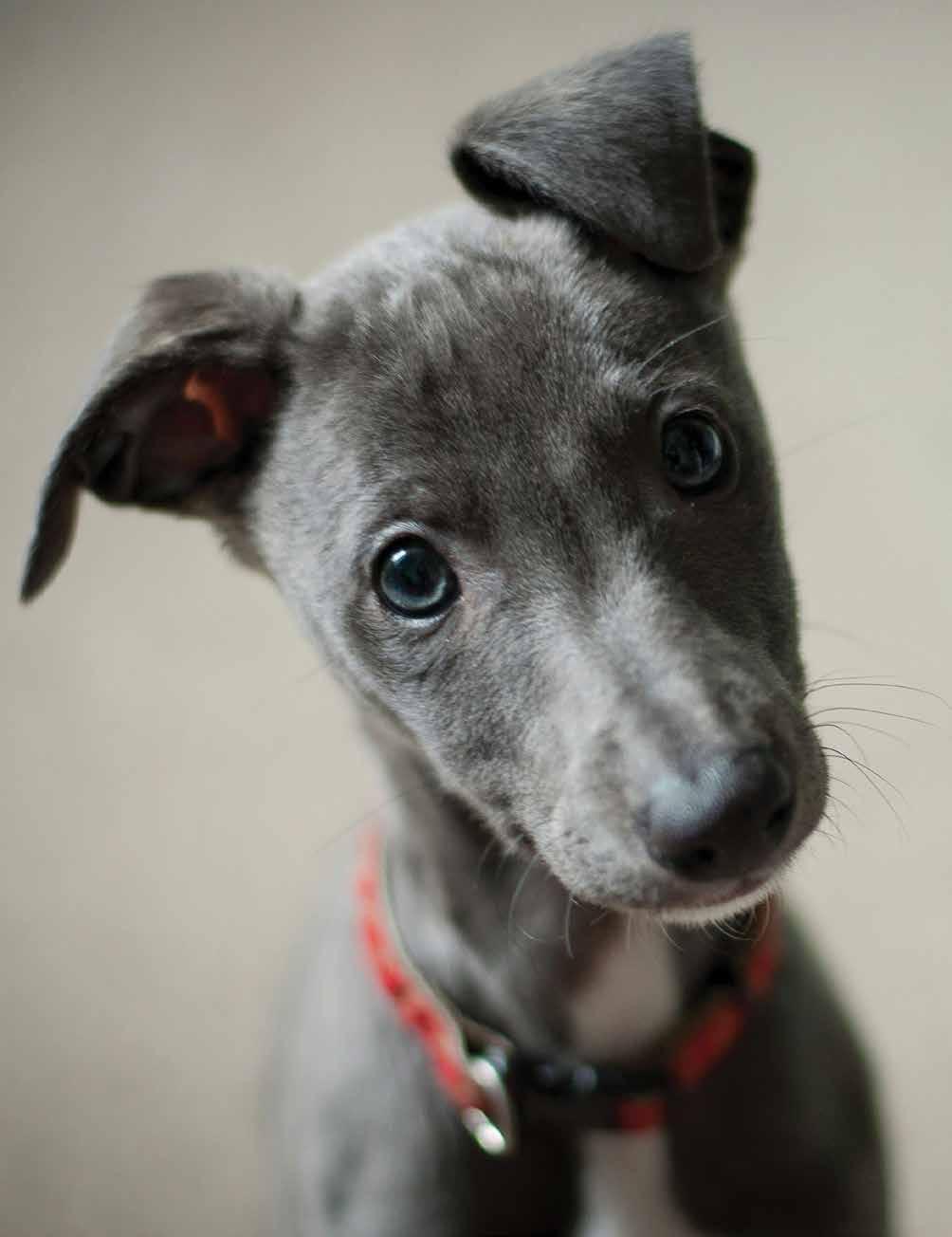

adopt! don't shop
BY JUNE MITCHELL
dopting a pet is a profoundly meaningful choice that enriches lives far beyond the companionship of a furry friend. It reflects a deep commitment to improving your own life, to addressing the pressing needs of countless animals in search of homes, and to supporting a more compassionate community. By adopting, you participate in a movement that saves lives, promotes ethical practices, and fosters deeper connections between humans and animals.
Choosing adoption over purchasing from pet stores or breeders tackles a significant issue: pet overpopulation. Each year in the United States, millions of adoptable animals are euthanized due to overcrowded shelters. Adopting saves a life and creates spaces for shelters to rescue more animals. Organizations like those featured by ELYSIAN are at the forefront of combating overpopulation, offering spay and neuter programs and facilitating adoptions that give every animal a second chance. These efforts are vital, as they address the root causes of overpopulation and ensure that fewer animals face unnecessary euthanasia.
readelysian.com
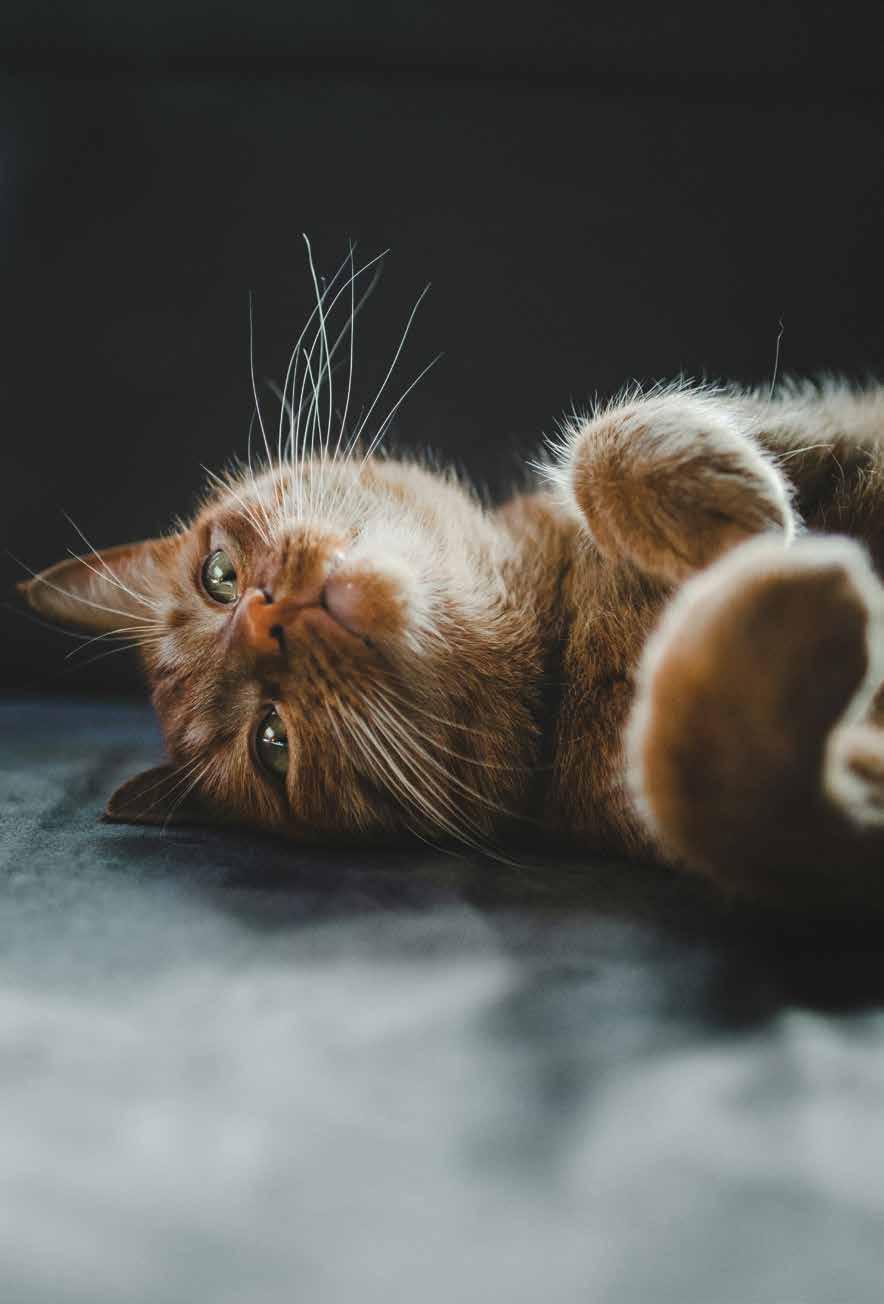

Adoption also promotes ethical practices. While some pet shops are linked to profit-driven puppy and kitten mills—where animals endure inhumane conditions and inadequate care—shelters focus on the wellbeing of their animals. Partnering with foster homes and veterinarians, shelters ensure pets are healthy, well-socialized, and ready for adoption. By adopting, you send a powerful message against exploiting animals for profit and advocate for their humane treatment. Each adoption is a vote against unethical breeding practices and a step toward a world where animal welfare takes precedence over financial gain.
Beyond its ethical significance, adoption offers practical benefits. It’s often more affordable than purchasing from breeders or pet stores, with shelter fees typically covering vaccinations, spaying or neutering, and microchipping—services that would otherwise incur significant costs. Adopting an older pet can also spare you the challenges of raising a puppy or kitten, providing a companion who is often house-trained and temperament-assessed. These advantages make adoption an accessible and rewarding option for families, singles, and seniors.
The emotional rewards of adoption are immeasurable. Shelter animals form profound bonds with their adopters, and research confirms the mental health benefits of pet ownership, including reduced stress, alleviation of depression, and fostering empathy. For animals who have faced hardship, a loving home transforms them into loyal, joyful companions, making the connection between pet and owner uniquely fulfilling. This mutual benefit—a sense of healing and love—is one of the most beautiful aspects of adopting a pet.
Despite the benefits, shelters remain overwhelmed. In the United States, while 3.1 million animals are adopted annually, just as many face euthanasia due to overcrowding and resource limitations. By adopting, you are saving a life and helping alleviate the strain on shelters. Each adoption reduces the burden on these organizations, allowing them to dedicate more resources to needy animals. This ripple effect shows how a single act of compassion can create broader positive change.
The COVID-19 pandemic underscored the value of pets in combating loneliness and isolation. The American Society for the Prevention of Cruelty to Animals reports that 23 million American households adopted pets during this time. As American Society for the Prevention of Cruelty to Animals President and CEO Matt Bershadker noted, these challenging times deepened our appreciation for the comfort and joy that pets bring. Studies have shown that human-animal interactions enhance trust, empathy, and social connection, reaffirming pets’ unique role in our lives. For many, the companionship of a pet during the pandemic was a lifeline, providing stability and love in uncertain times.
One of the often-overlooked benefits of adoption is the diversity of pets available. Shelters offer an incredible variety of animals, including those of different ages, sizes, breeds, and temperaments. This diversity allows adopters to find a companion perfectly suited to their lifestyle and preferences. Contrary to popular misconceptions, shelters often house purebred animals and even puppies. For those seeking specific breeds, breed-specific rescue organizations offer targeted adoption options. Whether you’re
looking for a playful kitten, a serene senior dog, or a particular breed, shelters provide a wide array of choices.
By adopting, you stand against unethical breeding practices, including those of puppy mills, which prioritize profit over animal welfare. Adoption diminishes the demand that sustains these facilities and supports humane practices centered on rehabilitation and rehoming. Shelters and rescue organizations work tirelessly to ensure their animals are healthy, well-adjusted, and ready to thrive in loving homes. Every adoption chips away at the harmful commercial breeding industry, creating a more compassionate future for animals.
Adopting a pet also contributes to sustainability. The high demand for commercially bred animals often involves significant resource use, from land and water to carbon emissions. Shelters operate on a model of rescue and reuse, reducing the environmental footprint of pet ownership. By supporting shelters through adoption, you make an eco-conscious choice that aligns with broader efforts to live sustainably and reduce waste.
Adopting can be an educational experience for families, teaching children responsibility, empathy, and the importance of caring for living beings. Growing up with a pet fosters compassion and respect for animals, lessons that extend to broader social empathy. Children who learn to care for animals often carry these values into adulthood, shaping them into compassionate and responsible people. Adopting a pet is not just about finding a companion—it’s about instilling values that will last a lifetime.
Adoption often connects individuals with a more extensive network of animal advocates. Many adopters participate in events, fundraisers, or volunteer efforts, strengthening community bonds and inspiring others to open their homes to shelter animals. These connections create a sense of shared purpose and belonging, enriching the adoption experience. The stories of adopted pets often serve as powerful catalysts for greater awareness and advocacy, encouraging more people to consider adoption and support animal welfare initiatives.
Aspublic awareness grows, societal attitudes toward animals are shifting. Campaigns, social media, and grassroots efforts highlight the resilience and love found in shelter pets. They remind us that every animal deserves a loving home, regardless of background. These narratives challenge outdated stereotypes about shelter animals, emphasizing their potential to bring joy, companionship, and unconditional love to their adopters.
The adoption journey is filled with joy and profound rewards, transforming the lives of the animals and their new families. Each adoption moves us closer to a world where every pet has a home. By adopting, you become a champion for compassion, a force for change, and a hero to a deserving animal. As more people recognize the value of adoption, the dream of a world without homeless animals becomes increasingly attainable.
Adopting pets is about more than gaining a companion—it’s about making a meaningful impact on the lives of animals and the community. Each adoption alleviates shelter overcrowding, promotes ethical practices, and fosters a culture of kindness and care. The ripple effect of one adoption can inspire others, creating a broader movement

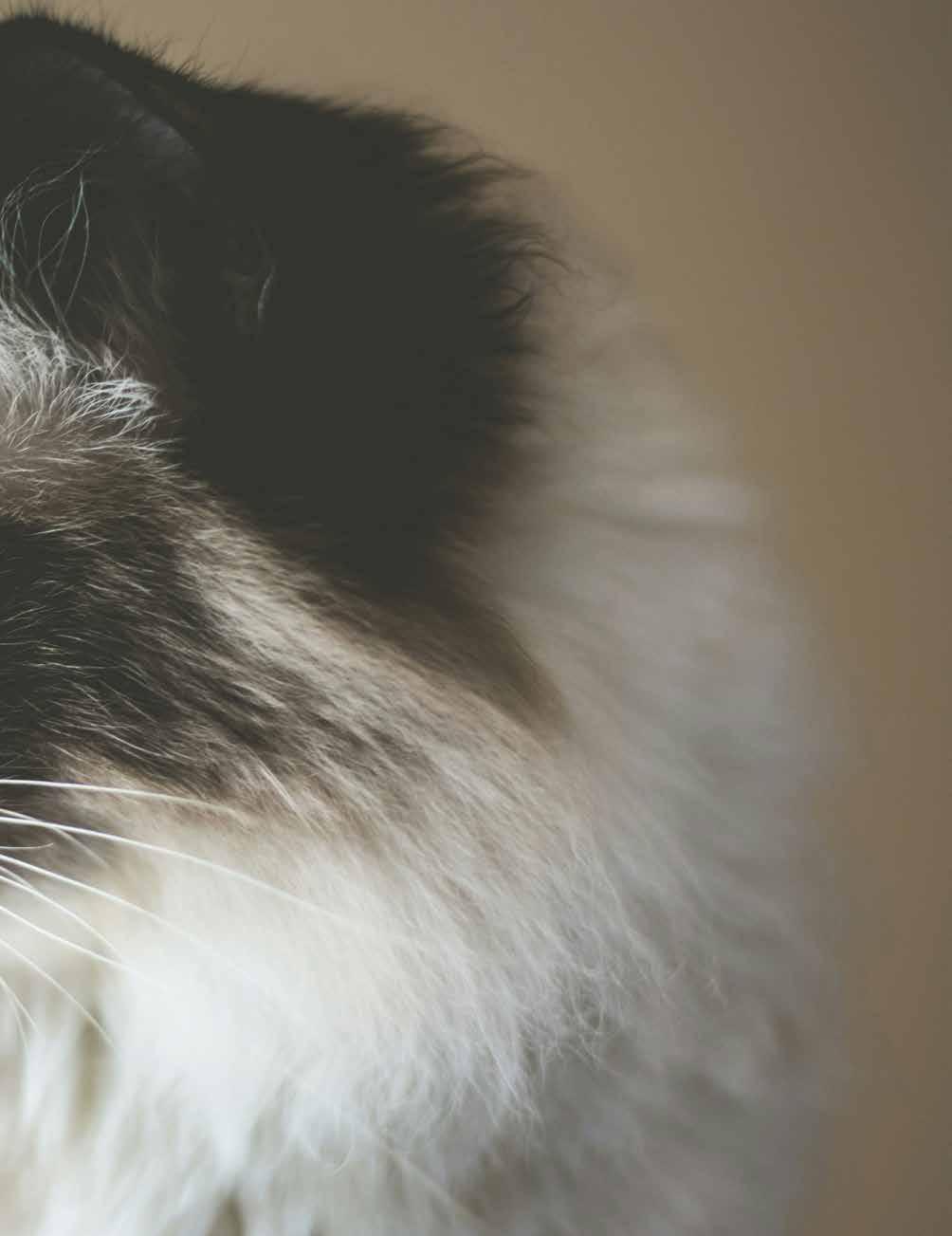
• printemps 2025 • l’édition sur les animaux de compagnie et la philanthropie • readelysian.com
PEOPLE ABANDON YOU IN THE WIND, A DOG FOLLOWS YOU THROUGH THE STORM.”
—ANONYMOUS
of compassion. As Best Friends Animal Sanctuary beautifully states, “Pets bring joy, love, and laughter to millions of people every day.”
By adopting, you embrace an opportunity to make a profound difference. Whether it’s the bond with a resilient shelter animal, the satisfaction of supporting a vital cause, or the joy of newfound companionship, the benefits of adoption are vast and far-reaching. Through adoption, we change the lives of animals and transform our own—bringing love, laughter, and purpose into our homes while making the world a kinder, more humane place. ■
Editor’s note: ELYSIAN’s 2024 CatWalk FurBaby, presented by Elysian Impact, took place at Sony Hall during New York Fashion Week, autumn 2024, blending fashion and philanthropy. Throughout the event, participants raised money in philanthropic support for their chosen animal welfare charities, highlighting the important work being done to protect and care for our furry companions. The goal was to not only create a spectacular fashion experience, but also to make a tangible impact on the lives of animals across the country. The following are shelters and charities that participated in ELYSIAN’s 2024 CatWalk FurBaby. ■
Companion Animal Alliance
Companion Animal Alliance was founded in 2010 by a group of passionate animal welfare advocates in Baton Rouge, Louisiana. Since its inception, Companion Animal Alliance has dramatically improved the local save rate for animals, increasing it from 20% in 2010 to 81% in 2023.
As the only open-intake animal shelter in East Baton Rouge Parish, Companion Animal Alliance cares for more than 9,000 animals annually, including cats, dogs, wildlife, livestock, and exotic pets. Its mission focuses on reducing shelter intake through owner resources, spay/neuter initiatives, humane animal care, finding forever homes, reuniting lost pets with their owners, and eliminating barriers to pet ownership. The
organization’s vision is to create a stronger, more compassionate Baton Rouge community for people and pets. /www.caabr.org
Animal Advocates of Barnwell County
Animal Advocates of Barnwell County, South Carolina, was founded to provide care and shelter for stray, abandoned, and abused cats and dogs. The nonprofit is made up of a diverse group of people with the same goal—to make a difference in the lives of the cats and dogs in their community by reducing the number of stray, starving, abused, and diseased animals, thus reducing the need for euthanasia.
Animal rescue can be deeply rewarding, but it often reveals heartbreaking cases of abuse and neglect. Since its founding in 2005, Animal Advocates of Barnwell County has been committed to improving the lives of dogs and cats in its community through:
• Assisting homeless, abandoned, abused, and neglected animals.
• Offering no-cost or low-cost spay and neuter services.
• Providing essential medical care, including heartworm treatments and orthopedic surgeries.
The organization was established after its founders learned that the local county shelter had a euthanasia rate as high as 98%. Determined to make a change, they created a facility to rescue these animals, giving them a haven. While fostering pets, Animal Advocates ensures they receive the medical attention they need before being adopted into loving, permanent homes.
Located in the rural South, where poverty is prevalent, Animal Advocates relies on resourcefulness to sustain its operations. To supplement grants and donations, the group runs the Pick of the Litter Shoppe, a thrift store that provides a steady source of income. /www.theanimaladvocates.org
Animal Ashram
Based in New York City, Animal Ashram is a nonprofit that embraces
readelysian.com


and promotes the oneness of all life, guided by the principle of ahimsa—the Buddhist ethic of respect for all living beings and nonviolence.
Animal Ashram holds a deep reverence for nature, animals, and humanity, advocating for the ethical treatment of all life forms. The organization believes animals should not be subjected to harm, exploitation, or abuse for food, experimentation, entertainment, fur, or skin. Its philosophy emphasizes that animals experience pain, fear, and emotions, and each deserves to be respected as a unique individual.
The organization’s mission focuses on raising funds for educational and public outreach programs, providing resources, and promoting awareness about the equality of all living beings. /www.animalashram.org
Operation Kindness
Operation Kindness is a trailblazer in Texas dedicated to providing animals with essential veterinary care, companionship, and most importantly, a loving home. Based in Carrollton, the organization operates a lifesaving animal shelter and offers a wide range of critical programs to support pets and people. These include adoptions, lifesaving medical care, affordable veterinary services, a pet food pantry, animal cruelty forensics, interstate transport, disaster response, and foster care for vulnerable animals.
The mission of Operation Kindness is to create a kinder world for pets and the people who love them by delivering lifesaving care, innovative programs, and vital community resources.
Their commitment extends beyond the shelter, as they actively mentor other animal welfare organizations, establish partnerships, and engage in collaborative initiatives to broaden their impact. These efforts enabled Operation Kindness to assist more than 30,000 animals in 2023. /www.operationkindness.org
NYC Second Chance Rescue
Founded in 2009, NYC Second Chance Rescue is dedicated to reducing euthanasia rates and alleviating the strain on an overburdened shelter system. Through education, community outreach, and compassionate care, the organization works to destigmatize misunderstood and discriminated breeds while fostering a culture of animal advocacy and compassion.
To date, NYC Second Chance Rescue has saved over 15,000 animals from euthanasia. An overwhelming 90% of the animals it rescues were once on the brink of being euthanized at municipal shelters.
Its focus is primarily on large-breed dogs and cats requiring critical lifesaving care—two groups that represent the majority of euthanasia cases in the United States. /nycsecondchancerescue.org
Spartanburg Humane Society
Located in Spartanburg, South Carolina, the Spartanburg Humane Society is a nonprofit dedicated to caring for lost and unwanted pets in its community. Its mission is to provide quality care and attention to these animals while working tirelessly to connect them with loving families.
The organization also offers low-cost vaccination and parasite prevention services, helping reduce financial barriers for pet owners in the area. Additionally, the Spartanburg Humane Society emphasizes community engagement through adoption events, collaborative service days with local businesses, and educational programs in local schools. / www.spartanburghumane.org
Rescue Dogs Rock NYC
Rescue Dogs Rock NYC is committed to raising awareness about the ongoing crisis of homeless animals in shelters and on the streets. Every day, countless animals are euthanized simply because they lack a home. Tragically, animals suffering from abuse, neglect, cruelty, or medical issues are often the first to be euthanized, as they require the most urgent and costly care.
The organization focuses on these vulnerable animals, providing them with routine, emergency, and specialized medical care, as well as rehabilitation. Rescue Dogs Rock NYC collaborates with trainers and behaviorists to help animals recover from trauma and prepare them for loving homes. /www.rescuedogsrocknyc.org
Gabrielle’s Angel Foundation for Cancer Research
Gabrielle’s Angel Foundation for Cancer Research was established in memory of Gabrielle Rich Aouad, a gifted actress and writer who tragically passed away from leukemia at the age of 27. The foundation supports early-career scientists conducting groundbreaking research to develop better treatments, prevention strategies, and cures for leukemia, lymphoma, and other blood cancers.
In addition to conventional research, the foundation funds music therapy and integrative or alternative medicine initiatives, enhancing patient care and well-being. To date, Gabrielle’s Angel Foundation has contributed over $43 million in research grants, continuing Gabrielle’s legacy of hope and progress. /gabriellesangels.org
Center for Family Services of Palm Beach County
The Center for Family Services of Palm Beach County is a nonprofit dedicated to strengthening individuals and families through mental health services and education.
Since its establishment in 1961, the center has continually expanded its services to address the evolving needs of the Palm Beach County community. It has served over one million clients with eight active programs, providing essential resources and support.
The center offers a range of services, including counseling for individuals, families, and parents of children under five. It also specializes in mental health programs for survivors of sexual abuse, physical abuse, domestic violence, and human trafficking, as well as children who have witnessed domestic violence. The center’s signature event, the Old Bags Luncheon, is now in its 26th year and has earned a reputation as one of the top five mustattend events of the Palm Beach social season. /ctrfam.org
Charleston Alternative to Detention
Charleston Alternative to Detention’s mission is to create and promote community-led alternatives to incarceration that unlock the potential of youth, enhance public health and safety, and improve economic opportunities in the greater Charleston, South Carolina, area. The organization also focuses on addressing racial disparities and reducing youth crime.
Research shows that alternatives to detention are effective in lowering recidivism and violence while decreasing associated financial, academic, and societal costs. /charlestonatd.org
Original Six Foundation
The Original Six Foundation is committed to breaking down barriers to education in rural South Carolina through initiatives focused on literacy, teacher-informed programming, and early learning. One in five students in these areas lives in poverty, and instructional spending often falls below the national average.
The foundation’s afterschool programs invest in students, teachers, and faculty, providing individualized attention that helps students dream big and succeed. Its mission is rooted in the belief that every child in South Carolina deserves equal access to educational opportunities, regardless of location or circumstances. /www.originalsixfoundation.org
Rahm Foundation
The Rahm Foundation strives to create a more equitable world by supporting humanity, animals, and the environment. Since 2007, the foundation has donated over $500,000 to mentorship programs, scholarships,
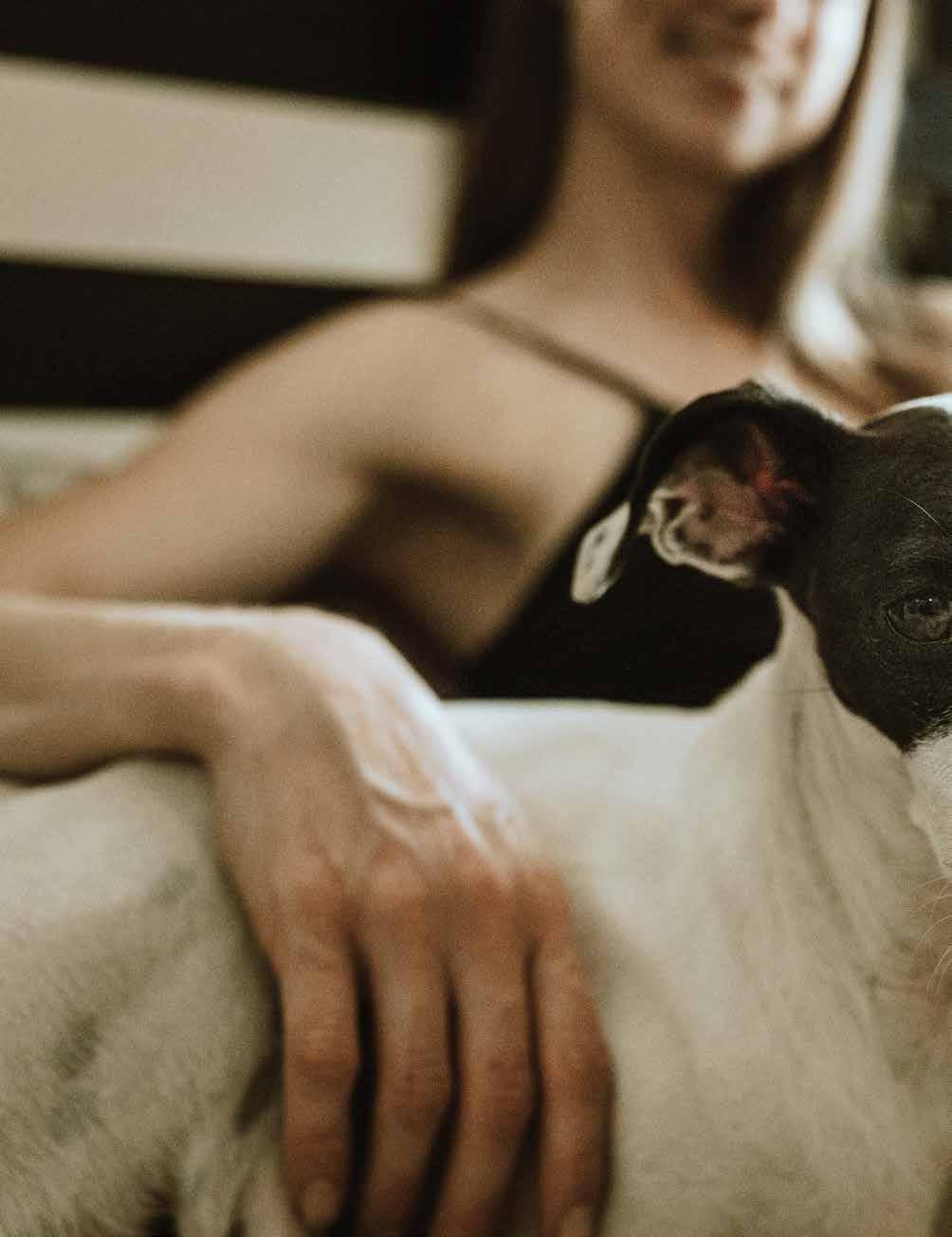

Each year in the United States, millions of adoptable animals are euthanized due to overcrowded shelters.
Adopting saves a life and creates spaces for shelters to rescue more animals. Organizations like those featured in ELYSIAN are at the forefront of combating overpopulation, offering spay and neuter programs and facilitating adoptions that give every animal a second chance. These efforts are vital, as they address the root causes of overpopulation and ensure that fewer animals face unnecessary euthanasia.
THE ONLY CREATURES THAT ARE EVOLVED ENOUGH TO CONVEY PURE LOVE ARE DOGS AND INFANTS.
—JOHNNY DEPP
and environmental initiatives, directly empowering over 30 mentees. What sets the Rahm Foundation apart is its global approach, combining environmental stewardship with a commitment to personal and societal growth. Its projects emphasize sustainability while fostering leadership and education. /www.therahmfoundation.com
Marley’s Mutts
Marley’s Mutts is transforming the landscape of animal welfare and social change. At the heart of its mission is the groundbreaking Pawsitive Change program, which connects incarcerated people with shelter dogs to create a mutually transformative cycle of rehabilitation and recovery. This program demonstrates the profound impact of helping others, fostering a therapeutic environment where the participants and the dogs can heal, grow, and rediscover purpose. /www.marleysmutts.org
Guns Garin Memorial Foundation
The Guns Garin Memorial Foundation was founded by the wife of an Air National Guard fighter pilot who passed away in 2020. The foundation’s mission is twofold: to support military families in times of need and to inspire the next generation to explore careers in aviation. Through financial assistance, the foundation helps service members with medical expenses, relocation, mental health counseling, bereavement, and more. It also fosters aviation education and offers scholarships to young men and women, encouraging them to pursue opportunities in this prestigious field. /gunsgarin.com
Honoring America’s Veterans
Honoring America’s Veterans, based in Scottsdale, Arizona, celebrates the sacrifice and service of veterans and their families through large-scale events that express deep gratitude and respect.
As the only nonprofit in Arizona uniting veteran service organizations, nonprofits, and corporations, Honoring America’s Veterans fosters a sense of community while paying tribute to the nation’s military heroes. /honoringamericasveterans.org
American Red Cross
The American Red Cross is a nonprofit dedicated to preventing and alleviating human suffering in emergencies by mobilizing volunteers and the generosity of donors. Every eight minutes, the Red Cross
responds to a disaster, providing shelter, food, relief supplies, health and mental health support, and financial assistance to those in need. /www.redcross.org
WLS Foundation
The WLS Foundation, short for When Life Sucks, resonates deeply with veterans and first responders in South Carolina’s Upstate. It provides direct support to those struggling with depression, anxiety, financial challenges, and marital problems—helping heroes navigate the battles they face long after returning home. /www.whenlifesucks.org
New York Women’s Foundation
The New York Women’s Foundation envisions an equitable and just future for women, girls, and gender-expansive individuals. Through investments in bold, community-led solutions, it addresses gender, economic, and racial justice. /www.nywf.org
Nebras Hayek Foundation
The Nebras Hayek Foundation transforms the lives of the homeless by providing shelter, education, job training, and essential resources to foster self-sufficiency and lasting change. /www.instagram.com/nebrashayek
Silent Tears
Founded in 2014, Silent Tears supports survivors of domestic violence, sexual assault, and child abuse in South Carolina. The organization funds legal bills, housing, medical expenses, and immediate needs for those impacted. /silenttearssc.org
Silverstein Dream Foundation
The Silverstein Dream Foundation is dedicated to transforming the healthcare system and redefining how diabetes is treated and prevented. Its mission includes providing innovative prevention programs, educating younger generations on new health protocols and protective practices, and funding groundbreaking research on curing type 1 diabetes.
The foundation believes in building a healthy, empowered, heartdriven community to challenge and change flawed systems. Through collective effort and mutual support, it aims to create miracles in healthcare. /www.silversteindreamfoundation.com
readelysian.com


Some Things to bark about
BY SINDIE FITZGERALD-RANKIN
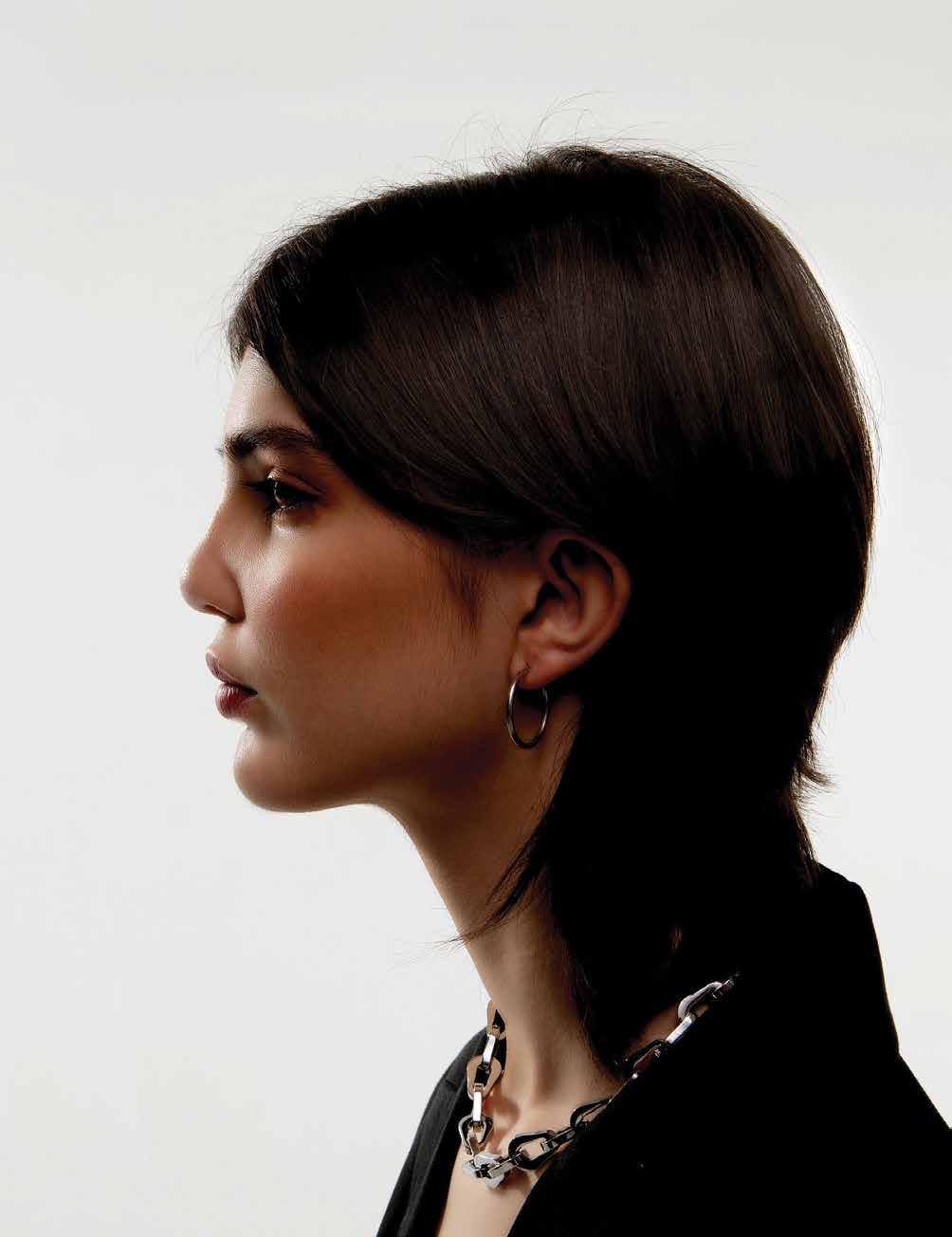


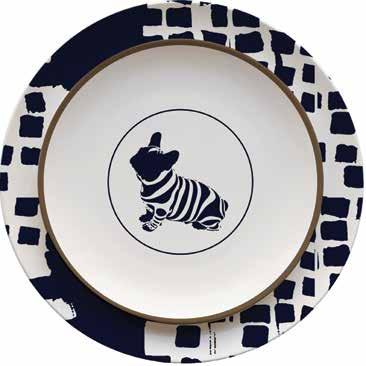
1. THE SIMONE LUXURY HARNESS BY PAGERIE - ($585) pagerie.com 2. DOG CHINA PLATE BY ARTIST & DESIGNER CLAIRE FLORENCE - ($10,000 FOR FULL SET) claireflorence. com.com 3. DOG PENDANT NECKLACE BY ARTIST & DESIGNER CLAIRE FLORENCE - ($10,000) claireflorence.com.com 4. GUCCI GG STAR EMBELLISHED METAL CAT-EYE SUNGLASSES - ($1,305) bergdorfgoodman.com 4. DOLCE & GOBABANA FEPÉ FRAGRANCE MIST FOR DOGS - ($99) dolcegabbana.com / nordstroms.com


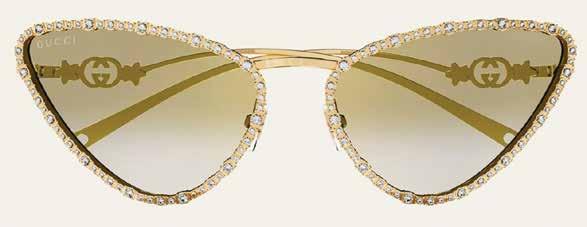
la noyée
by Suzanne Johnson
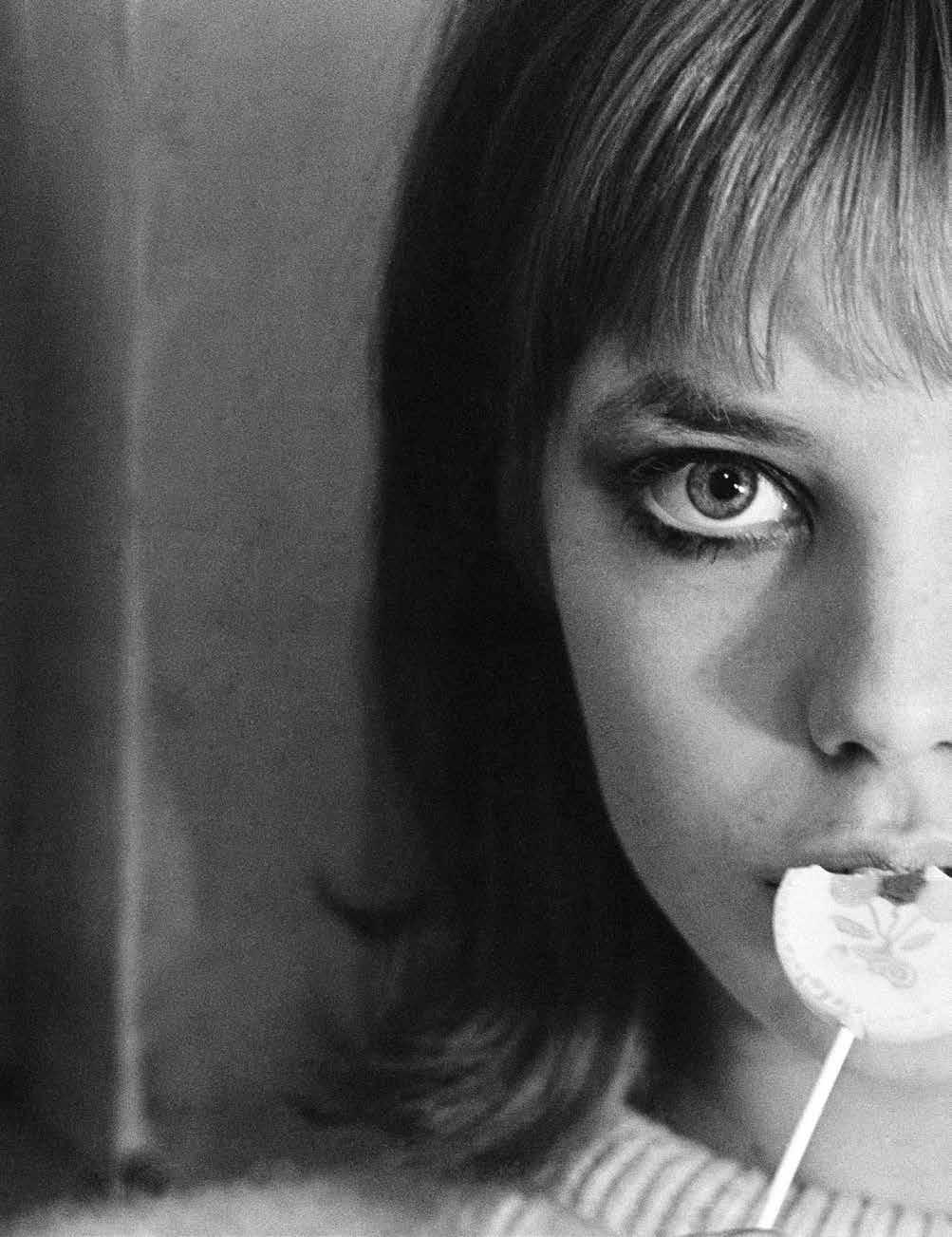
printemps 2025 • l’édition
Jane Birkin, English model and actress.
PHOTOGRAPH BY TRINITY MIRROR / MIRRORPIX / ALAMY STOCK PHOTO
l’édition sur les animaux de compagnie et la philanthropie •
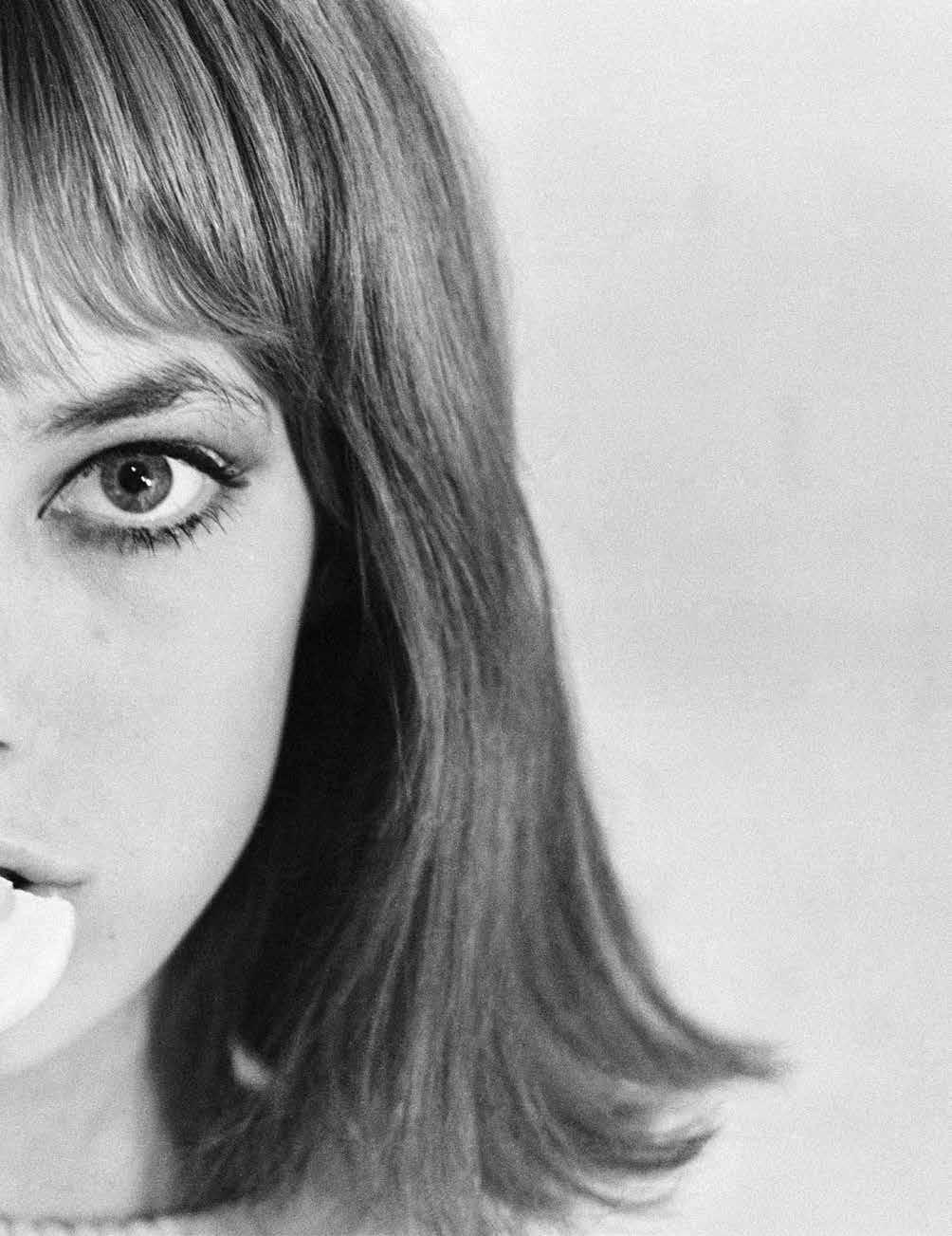
J
ane Birkin was a beloved British-born Parisian actress, singer, and fashion inspiration whose beauty, style, and celebrity captivated the curiosity and hearts of the French and beyond. While she was far less known in the United States (more recognized because of the eponymous luxury Hermes bag “the Birkin”), Jane Birkin is considered an entertainment and fashion icon amongst the most celebrated female icons in her adopted country, France, such as Catherine Deneuve and Brigitte Bardot, due to her impact on French culture.
Jane Birkin’s long and varied career in entertainment is said to have been enabled by her lineage, guided by her adventurousness, and empowered by her unconventional glamour. (Not the first actress to be critiqued this way.) Biographers to critics have also pointed to the succession of “happy accidents” that serendipitously skyrocketed Jane to stardom.
Happy accidents? Fate? It’s true; Jane had amazing stories, and the turn of events in her life could elicit a response like, “You gotta be kidding me?” Interviewed many times about her life, Jane humbly attributed her success to “being at the right place at the right time.” Another expression comes to mind when reading about Jane’s success: “You must be present to win.” Jane Birkin was. Present. Doe-eyed and beautiful, Jane put herself in “the right place at the right time” and accepted each invitation fate offered her with pluck, ability, and ambition. Fate would say she was the right person at the right time.
Another key factor in Jane Birkin’s success was timing. The 1960s was a golden age for Paris fashion, more youth-driven, and trend-conscience. It was a time of elegance with a carefree attitude, and the overlap of film, music, and politics set the tone. It was a time of sexual liberation and protest movements, appealing to some and offensive to others.
It is
believed the most significant contributor to Jane Birkin’s notoriety and success (in France primarily) was her collaboration with Serge Gainsbourg. Described as a “brilliant, tortured musician” (The New York Times), Serge Gainsbourg is still considered “France’s favorite bad boy” (RFI), and his multifaceted body of work is considered important and influential, most notably the lasting impact Gainsbourg has had on music and more broadly on culture. Gainsbourg and Birkin have been “likened” by some biographers to America’s Sonny and Cher, though consider Jane and Serge far more controversial. Like Sonny and Cher, Jane and Serge were significant influencers in popular culture (mostly in France) and had a successful artistic collaboration. Though they never married, the duo also had a daughter, the actress Charlotte Gainsbourg. Jane and Serge had a very passionate and very publicized love affair. It began in 1968 with Jane playing Serge’s muse and ended with Jane playing “the keeper of the Gainsbourg flame” years after Serge’s death and up until her own. Birkin continued to tour her/his music into her 70s. Jane had a concert scheduled in Paris on February 3, 2024, but she
Jane Mallory Birkin was a British-French actress, singer, style icon, and designer. She had a prolific career as an actress, mostly in French cinema.
BY
• l’édition sur les animaux de compagnie et la philanthropie
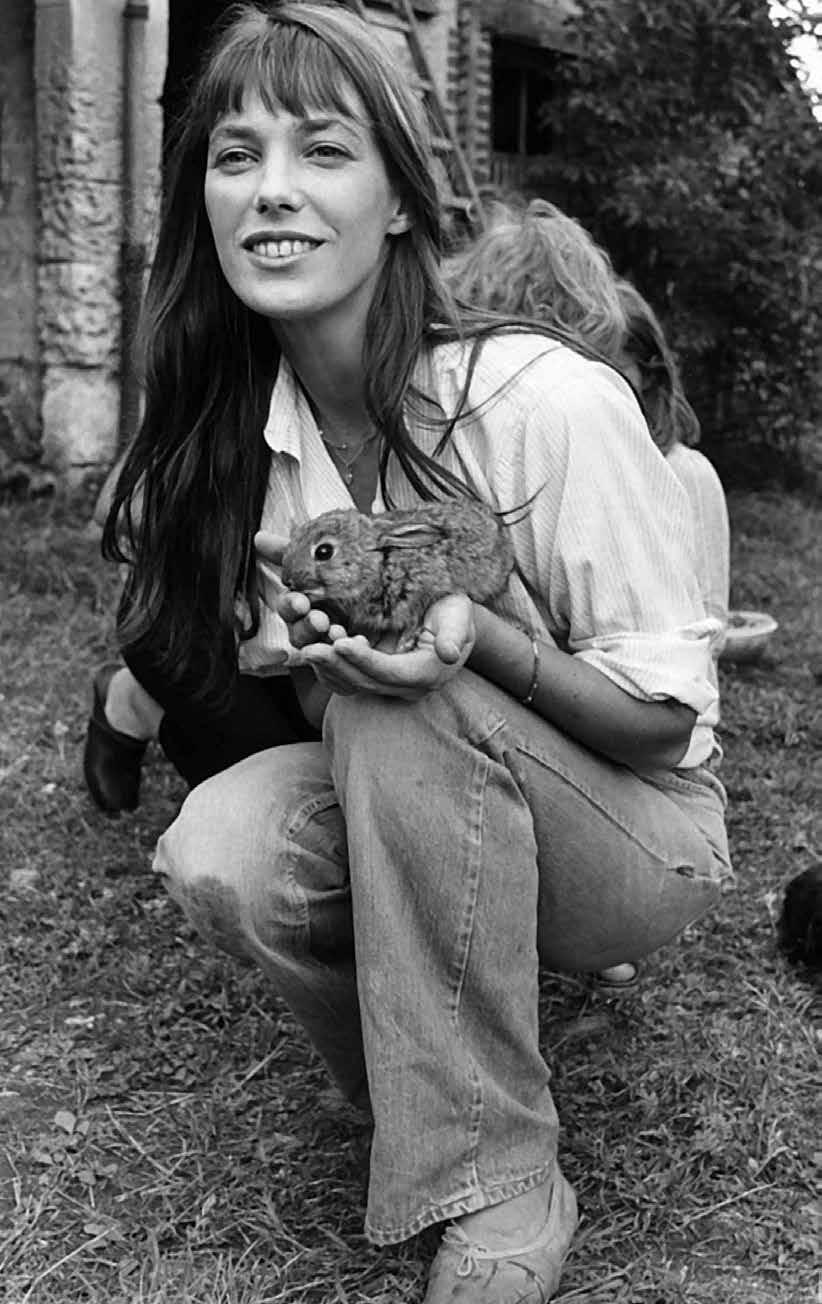
• printemps 2025 • l’édition sur les animaux de compagnie
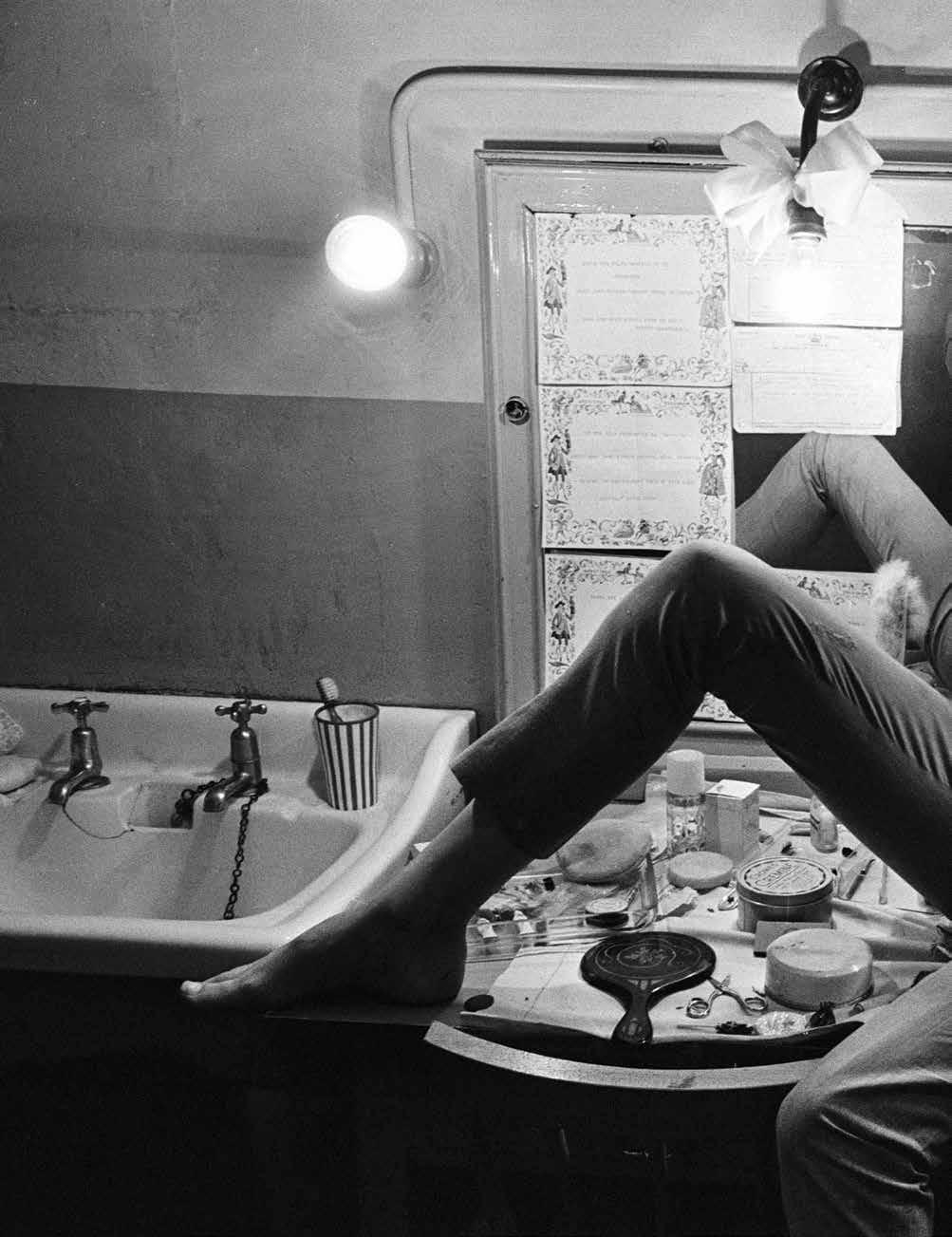

died unexpectedly on July 16, 2023. The concert became a tribute renamed “Jane Birkin by Friends.”
Jane Birkin died at 76 after a career that spanned five decades. There was an outpouring of tributes globally, especially in her adopted France. Amongst the many accolades in the French paper Le Monde, Anne Hidalgo, the mayor of Paris, named Jane Birkin “the most Parisian of Englishwomen,” and President Emmanuel Macron hailed Jane as a “French icon” who “embodied freedom and sang the most beautiful words of our language.” Jane, who made France her home for almost fifty-five years, became a French citizen and managed to charm the French with her accent that blended English and French, lovingly called “Birkin-ease,” further proving Jane Birkin’s rare mystique-knowing the French’s love of their language, she was the rare exception.
Jane Mallory Birkin was born in London, England, on December 14, 1946, to famous English actress Judy Campbell and Royal Navy Seal Lieutenant and World War II spy David Birkin. Jane’s mother, “so glamorous, I felt diluted,” Jane is quoted as having said, was considered a great beauty and widely known as the famous playwright and composer Noel Coward’s muse. Jane’s grandparents also had careers in theater; her grandfather was a playwright, and her grandmother was an actress. The Birkins lived in the artistic center of London and bought the oldest home on Old Church Street, steps down from the famous Chelsea Arts Club. Not surprisingly, Jane became a child actor, positioned by lineage and location to pursue acting as a career. Jane split her childhood between the cultured section of Chelsea and the serene landscapes of the Isle of Wight, though her childhood was far from idyllic.
It’s hard to imagine that the swinging Parisian “It Girl” that was young Jane Birkin, could self-describe herself as a shy, gap-toothed English girl who often felt out of place and had trouble fitting in at her boarding school. Frequently compared, with disappointment, to her beautiful and famous Mother, Jane recounted that she was teased by her classmates as being “half boy half girl” because of her slim figure and androgynous looks. It would be interesting to know what those budding socialites at Miss Ironside’s School For Girls in Kensington later thought of Jane’s stratospheric rise to stardom after she left school.
Atthe age of 16, Jane captivated audiences in her first big role as a deaf-mute opposite renowned lead actor Ralph Richardson; it was her first stage audition, and while Jane intended to audition for The Prime of Miss Jean Brodie she went to the wrong theater, auditioned anyway and landed the role. What a happy accident! (Buckle in.)
In 1965, Jane met John Barry, a British cinematic composer who became a five-time Academy Award winner. She was 17, John was 30, and already had two children. At 18, Jane and John were married in a secret wedding, and the dazzling couple was the talk of the swinging mid-60s, but John left Jane, the couple separated, and divorced in 1968 shortly after Jane’s first daughter Kate Barry was born. Birkin has described the marriage as “largely depressing, me often crying to the point where John asked me to sleep in separate rooms.” Yes, she was young, but his infidelity and neglect didn’t help.
At 21, Birkin returned to live with her family with her four-month-old daughter Kate and began auditioning for roles in television and film -some of which have been defined as some of Jane’s “most stylish.” (Vogue December 2023).
In 1968, she was cast as Penny Lane, playing the fantasy-like model in Wonderwall, a psychedelic film scored by George Harrison. In 1969, she was cast alongside Romy Schneider, considered one of the greatest screen actresses of all time, in the French thriller, La Piscine. Jane is quoted as saying Romy greatly influenced her style and fashion choices. Interestingly, in addition to being fashion trendsetters, both were child actresses, both were involved with celebrity French men with whom they remained close lifelong friends, and both lost an adult child later in life. Jane lost her eldest daughter, fashion photographer Kate Barry, in 2013.
Jane Birkin shopping in Paris, 1970.

• printemps 2025 • l’édition sur les animaux de compagnie et la philanthropie


Poster art for the trippy British film, Wonderwall, starring Jane Birkin, 1969. PHOTOGRAPH BY EVERETT COLLECTION, INC. / ALAMY STOCK PHOTO

printemps 2025 • l’édition sur les animaux de compagnie et la philanthropie •
ONE OF THE THINGS I’VE DISCOVERED, THANKS TO THE JAPANESE, IS THAT YOU SHOULD ENJOY YOURSELF. IN THE OLD DAYS, I USED TO THINK: ‘OH, NEVER BE SATISFIED, NEVER ADMIT TO BEING HAPPY.’ BUT THERE’S NO CURSE IN BEING HAPPY.”
Considered to be the greatest turning point in Jane Birkin’s career, Jane was cast in the lead role in the 1969 French romantic comedy Slogan, remarkably a role she got despite her not understanding what she was saying—she couldn’t read French. Or speak it very well. The film Slogan is celebrated “not just for its obvious satirical merits, but also for its catalytic influence on Jane Birkin and Serge Gainsbourg.” (Vogue, December 2023).
Jane was 21, and her co-star—musician, actor, and notorious bad boy Serge Gainsbourg—was 36. Serge and Jane would become one of the most iconic French artistic duos ever. Despite their initial disinterest, they fell deeply in love. Birkin and Gainsbourg were thrust into the spotlight “as much for their bohemian and hedonistic lifestyle as for their work.” (The Voice of Fashion).
Jane and Serge became “the most famous of French couples” remembered for their duet sensation, “Je t’aime . . . moi non plus”. The song translated in English, I love you, me neither, was written in 1967 by Gainsbourg for his thenlover Brigitte Bardot. Bardot and Gainsbourg recorded the song in Paris, but when news of the single reached Bardot’s then-husband, he angrily demanded the single be withdrawn. Bardot pleaded with Gainsbourg not to release the single. Serge offered the song to his new lover, Jane Birkin, and their duet became an unprecedented commercial success. Happy Accident.
Music critics attribute the duet’s groundbreaking success to the “controversial dialogue” between an older man and a young (innocent-sounding) woman, exchanging explicit lyrics punctuated by Jane’s whispering and moaning. The breathy exhortations of Jane and Serge—unorthodox and scandalous at the time—made the song a number-one hit in the UK, the first foreign language song to do so. The song was censored, banned in several countries, and condemned by the Vatican due to its sexual content. Birkin recounts that Gainsbourg called the pope “our greatest PR man.” Even the head of their record label was jailed for offending public morality. On accepting the offer to record the song with Serge, Jane said, “Of course, (I did it) just out of loving him and being scared stiff that he would be with some beautiful blonde—(Bardot). I had no ambition to be a singer.” This “happy accident “cemented Jane as a French sex symbol and, more significantly, as a singer and Serge Gainsbourg’s muse.
Jane spoke honestly about her desire to please her husbands and lovers. It is observed that Jane’s gutsy choices “to please” (or whatever the motivation) did impact her reputation and celebrity. For example, when Birkin’s husband, John Barry, learned that his wife would need to bare it all in Michelangelo Antonioni’s film, Blow Up, her first film role, Barry attempted to intimidate Jane with reverse psychology. “You don’t have the courage to take it all off,” Jane remembered Barry daring her, and her thought was, “Well, I’ll do it, and that will thrill him.” It did not, but this screen “debut” not only launched her career, but her nudity also helped establish the MPAA film rating system in the US. (I can’t even get into this).
At the 1969 premiere of Pierre Grimblat’s film Slogan, Jane Birkin grabbed headlines, not because of her acting skills but for confidently appearing on the arm of her co-star and lover Serge Gainsbourg wearing a long sleeve, see-through mini dress and carrying her eccentric basket purse. They lived a glitzy life as the most fashionable, party-going, and scandalous “IT” couple in Paris, but Jane and Serge had problems and did not keep their relationship drama hidden behind closed doors as many celebrity couples do. After thirteen years together, recording and performing, fighting and making up, often in public, Jane left Serge in 1980. Their daughter, Charlotte, was nine at the time. That same year, Jane entered into a relationship with French film director Jacques Doillon; they worked on several films together and had a daughter, singer/ actress Lou Doillon, in 1982, but the couple split in 1992.
you can’t talk about Jane Birkin’s career without Serge Gainsbourg. In Sylvie Simmons’ book Serge Gainsbourg: A Fistful of Gitanes, it reads, “Serge’s focus was to make Jane Birkin a hit-making French chanteuse. By releasing the overtly sexual single Je t’aime . . . moi non plus and their debut album together, Jane Birkin/ Serge Gainsbourg, in 1969, Jane lovingly recounted, “He wanted me to be a star,” and “That’s the reason my name was first in the title—that’s what he did to people he loved.” Many artists agree.
Jane Birkin and Serge Gainsbourg photographed in their Paris home in 1972.

2025 • l’édition sur les animaux de compagnie et la philanthropie •

Actress and recording star Jane Birkin and filmmaker Agnes Varda share an interest in the feminist documentary/docudrama, Jane B. for Agnès V., 1988. Varda mixes interviews with vignettes whereby Birkin performs her full repertoire. PHOTOGRAPH BY
Jane and Serge remained lifelong partners, collaborating artistically and as parents until he died in 1991. Jane, post-Serge, continued her career with solo albums, acting roles, and concerts. In all, Jane recorded over 20 albums, acted in over 65 films, and received many awards, including the César Award, the Canne Film Festival Trophy, the Legion of Honour, the Victoires de la Musique, the Ordre des Arts et des Lettres, and the London Critics Circle Film Award. Jane had a strong commitment to philanthropy and activism, reflected in her humanitarian work in Africa, for Women’s Rights, Cultural Preservation, Environmental and Animal Rights, AIDS/HIV Advocacy, and Refugee, Migrant, and LGBTQ rights.
One also
can’t talk about Jane Birkin without talking about Fashion and her impact on it. “Birkin’s style introduced something new to the fashion vocabulary, and her style is considered more relevant today than ever.” (The New York Times, Veranda, 2023).
Seemingly effortless, whether bohemian or chic, sexy or androgynous, Jane was a natural beauty (who I think anything looked great on), and her choices expressed her “innate vivacity and propensity for bending the rules.” Jane’s style evolved with confidence as she aged with grace and dignity.
Whether at a film premiere in Cannes or the farmers market in her bohemian left bank neighborhood, Jane stole focus—men ogled, women took note, and cameras flashed to capture her radiant smile and fashion choice, which usually included her legendary accessory—a Portuguese wicker basket.
In 1983, Jane placed her Portuguese wicker basket into an airplane overhead compartment, and all of its contents fell to the cabin’s floor. As the story goes, while crawling around picking up her things, she fumed to the man beside her that it was hard to find a good bag that could hold everything. This man turned out to be JeanLouis Dumas, Chairman, Chief Executive, and head designer at Hermes. The two brainstormed about the perfect bag, and Dumas created a bag, “the Birkin,” with permission to name it after her. This luxury Hermes bag remains one of the world’s most coveted status symbols. Happy Accident, indeed.
When Jane Birkin died in 2023, hundreds of articles were written about her Worldwide. Most provided an anthology of her films, songs, albums, plays, books, documentaries, and most importantly, her three daughters, but they didn’t always include “the Birkin” bag.
Speaking to renowned musician Stan Harrison about Jane Birkin, Stan felt strongly that I not include the Birkin bag in my article. “I never saw her with a Birkin Bag. It never came up.” He suggested I just add a footnote at the bottom of my article that read “. . . and she had a bag named after her.” Yes, we laughed at this idea, but I found it a meaningful observation from an artist who had been a part of Jane’s world and who both observed and was aware of Jane’s humility, talents, and character.
Another person who had been a part of Jane’s world, actress Charlotte Rampling, reinforced this point in her beautiful article, Jane Birkin Remembered. Charlotte doesn’t mention the Hermes luxury bag but instead writes about their parallel lives and Jane’s dedication to her career, causes, and children. Like Stan, she spoke of her friend’s character and humility: “Jane was very much a public figure in France, but she was always humble about it. She’d say she was lucky, that other people were leading with her dancing along behind. This wasn’t false modesty, either. When we chatted, you saw she really believed she’d been given this great gift of being part of a powerful, creative world.” ■
Jane Birkin performs at the Francofolies festival in Spa, Belgium, 2003.
printemps 2025 • l’édition sur les animaux de compagnie et la philanthropie •


• printemps 2025 • l’édition sur les animaux de compagnie
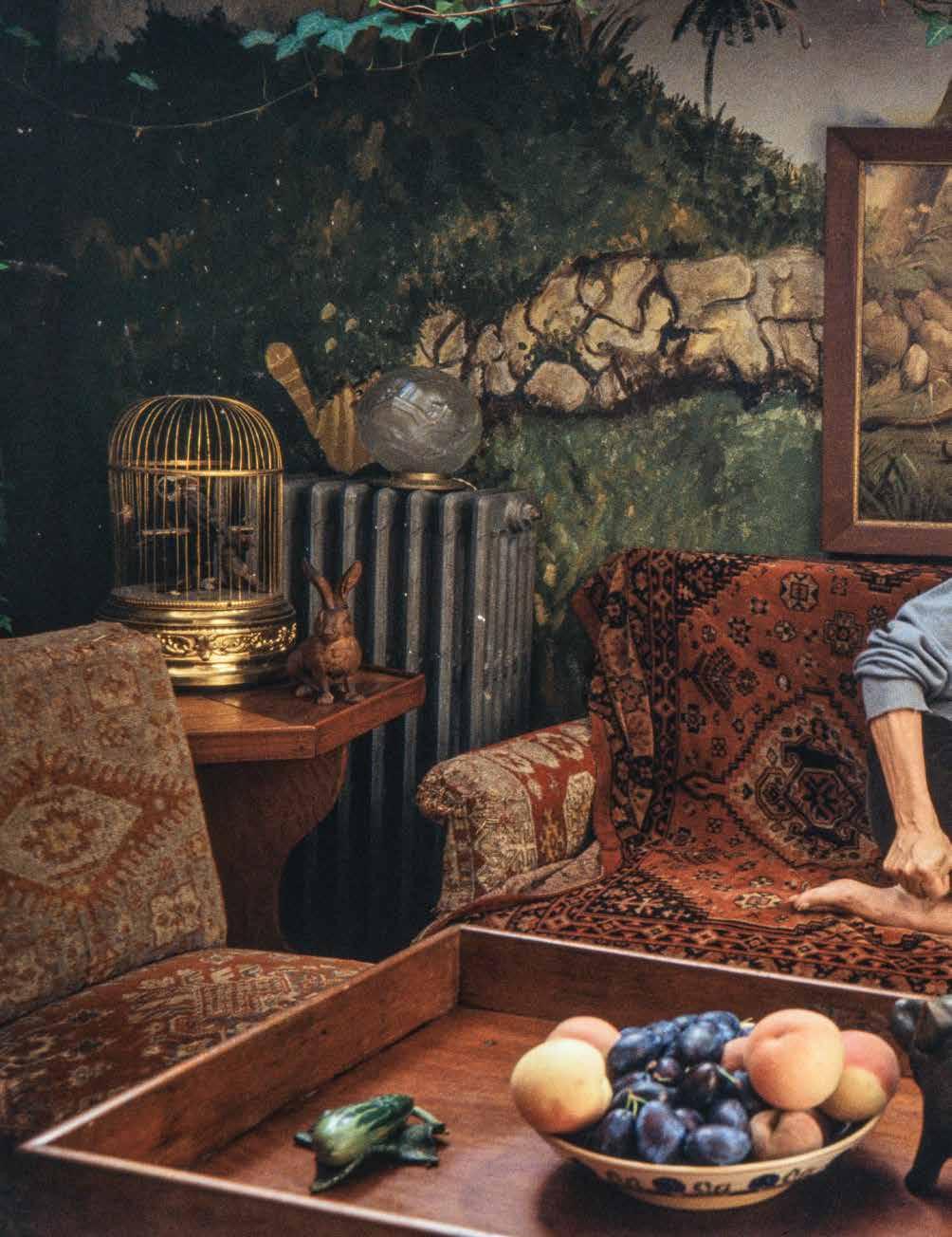
compagnie et la philanthropie • readelysian.com

Jane Mallory Birkin poses barefoot on a sofa covered with an oriental woven carpet, with her British Bulldog Dora by her side, in the salon of her former home in the Rue Jacob, Paris, 16th Arrondissement.
PHOTOGRAPH BY

Model Gia Skova and Daisy the Pomeranian represented Operation Kindness on the runway. The duo donned an exquisite design by D’Marsh Couture, created by Glenroy March, called “Evening Walk Under the Stars.” The ensemble evoked the charm of a cool spring evening in Paris, with the fragrance of fresh blooms and a radiant young woman strolling beneath the glow of streetlamps and shimmering stars. Nestled in a basket at her hip, a small dog peeked out from among a vibrant bouquet, completing the enchanting scene.
PHOTOGRAPH

an Unfurgettable Occassion
Following the success of the inaugural CatWalk FurBaby, the only fashion show that mixes models, dogs and charities returned bigger and better to New York Fashion Week in fall 2024. With twice the teams, ELYSIAN’s signature event once again proved its bark and its bite.”
by Samantha Paige
ust how fabulous was CatWalk FurBaby 2024?
Between the electrifying music, the dazzling ensembles, and the money raised for not one but three animal rescues, ELYSIAN’s second-annual signature event kicking off New York Fashion Week was an unparalleled success.
Models and pets strutted the runway in couture outfits that not only sparkled but symbolized meaningful causes, from animal welfare to women’s empowerment. ELSYIAN Founder and Publisher Karen Floyd said as she welcomed a packed Sony Hall, “Ripples create waves, and waves create change.”
Taking the baton from Floyd was the legendary Fern Mallis, founder of New York Fashion Week. Known as the “Godmother of Fashion,” Mallis reminded the audience of the legacy of New York as the fashion capital, emphasizing how fashion, much like philanthropy, can be a conduit for change.
CatWalk FurBaby doubled in size in its second year, growing from 10 charities represented in 2023 to 21 charities in 2024. “We had a lot of new faces, new connections and representation from across the nation . . . And on multiple occasions, the world!” ELYSIAN Impact Director Kimberli Scott said.
With the teams competing in five different ELYSIAN Impact categories—women, children, animals, service and the environment—the sheer range of the charities represented on the runway was breathtaking. Stretching from coast to coast, these charities touch so many aspects of our daily lives, whether that involves pairing an abandoned pet with a forever home, funding cancer research, or advocating for alternatives to detention for at-risk youth.
“I’m always grateful to meet so many like-minded individuals, all of whom are inspiring, have their own story to tell, printemps 2025 • l’édition

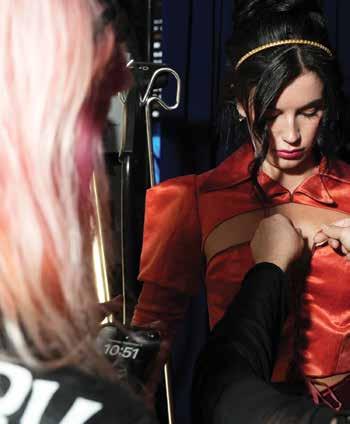
ELYSIAN CatWalk FurBaby 2024 esteemed panel of judges; super model Carol Alt, Maribel Lieberman: the founder of MarieBelle New York Chocolates and a dog mom, recording artist, designer, and philanthropist, Consuelo Vanderbilt. PHOTOGRAPH BY PMC / JARED SISKIN • Model Belle Scott backstage. PHOTOGRAPH BY PMC / JARED SISKIN • Opposie: ELYSIAN Founder and Publisher Karen Floyd reminded the crowd in Sony Hall of the broad impact that can stem from a single act of kindness. / PHOTOGRAPH BY DREAM
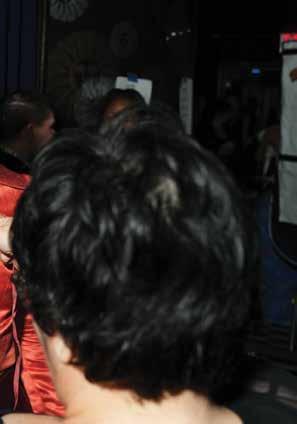

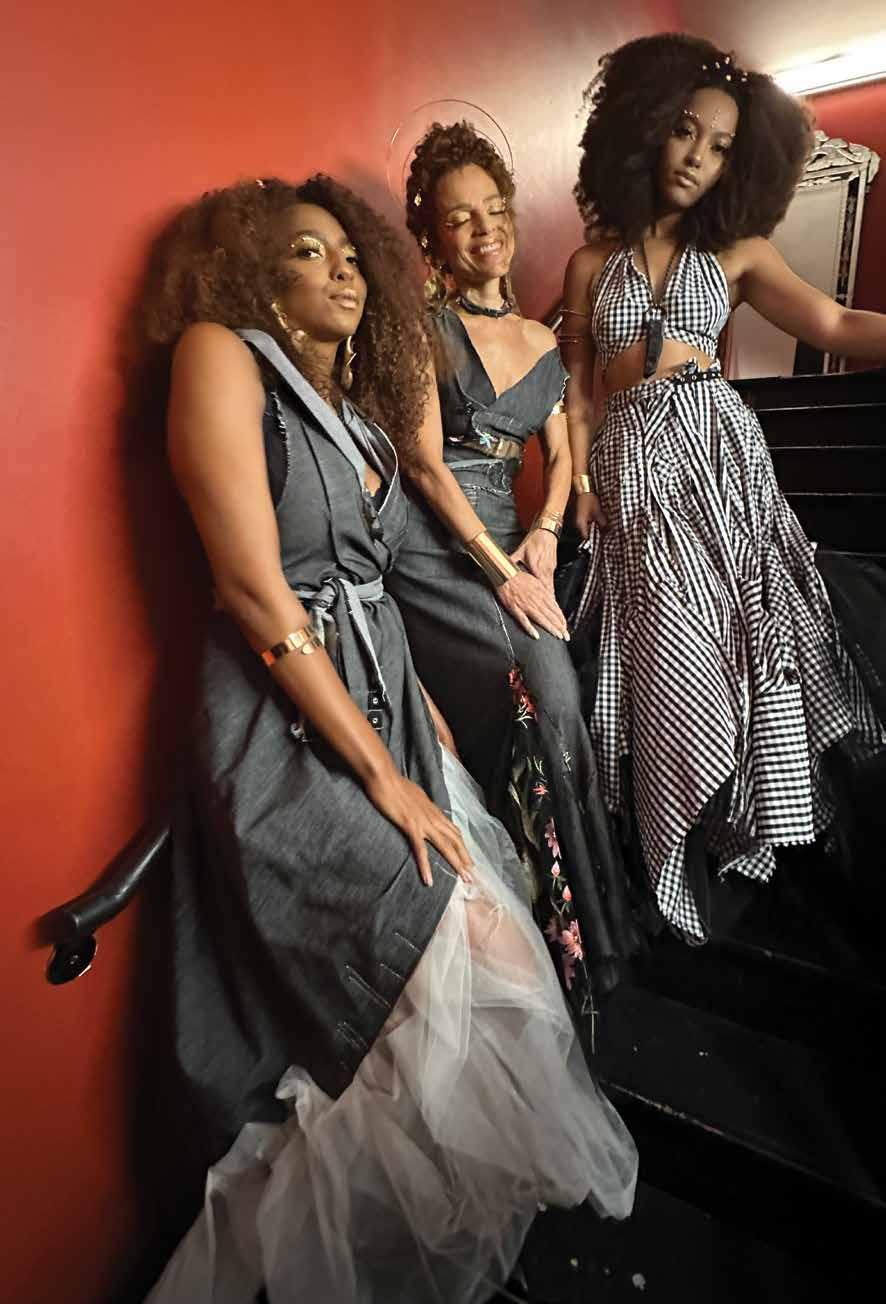
The Spartanburg Humane Society was represented by model Tatum Mogck, accompanied by Louie, a border collie mix. Tatum wore “Unleashed,” a striking ensemble designed by Christina Strayer and crafted from new and repurposed leashes. PHOTOGRAPH BY PMC / JARED SISKIN • Facing page: Models showcased Merci Dupre Clothier’s innovative Enviremware line in the second half of the show.


Model Rachel Donohue and Eunice, a cattle dog mix, represented Second Chance Rescue on the runway. Together, they showcased Nicole Miller and Pamela Johananoff’s Canine Cashmere concept, titled “Aim to Advocate.” PHOTOGRAPH BY PMC / JARED SISKIN
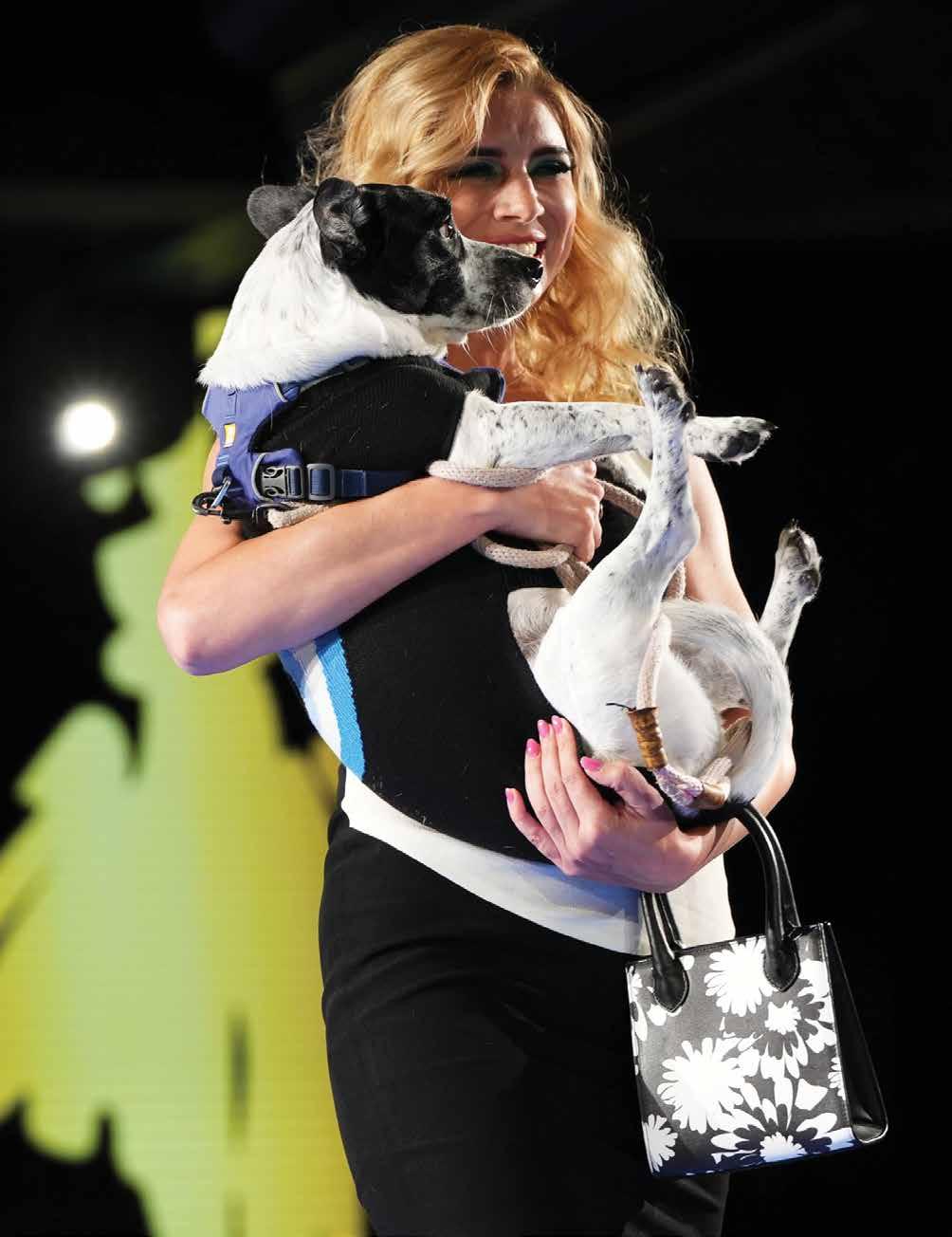
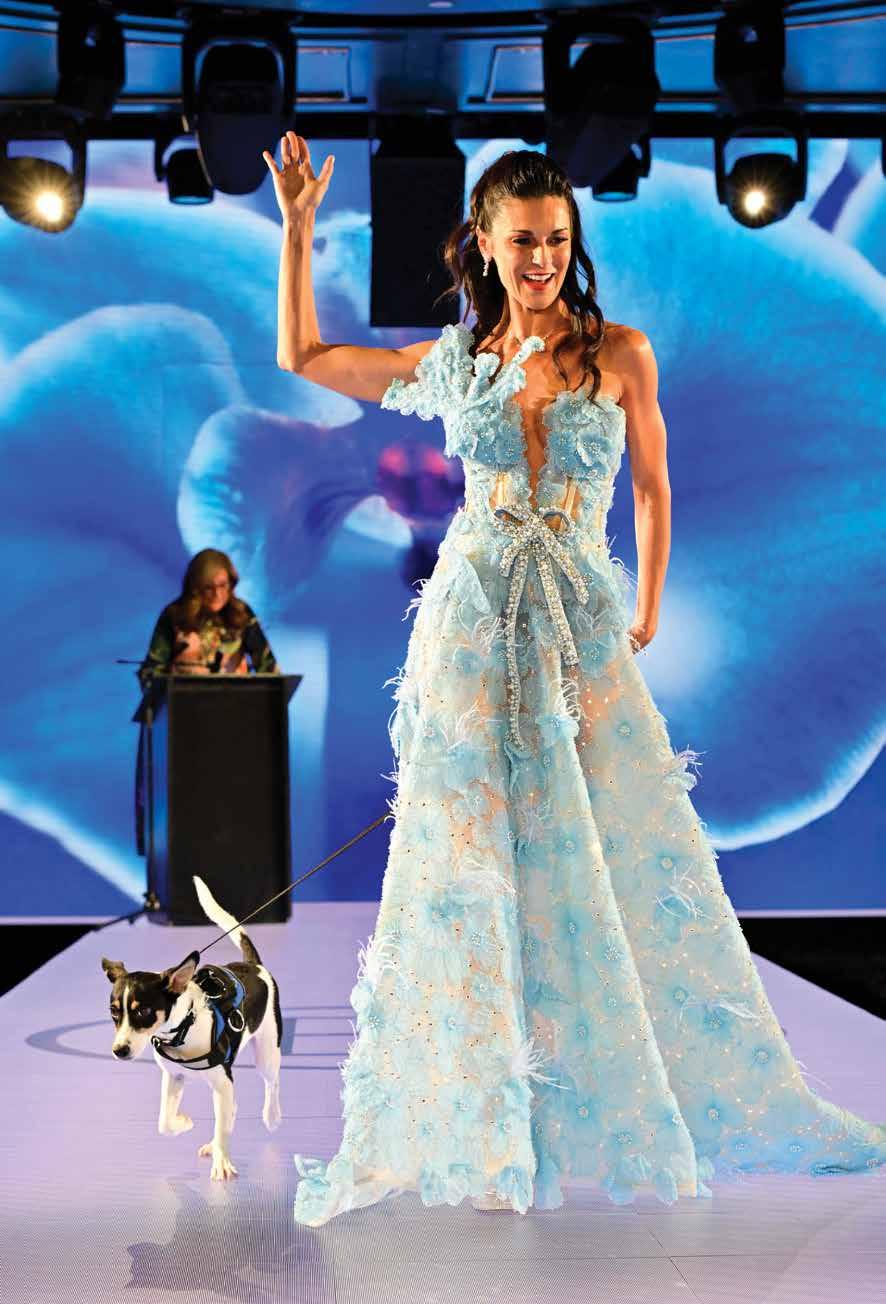
Animal Ashram was represented on the runway by model Jamie Logan and her dog, Donna Summer. Jamie wore a bespoke black faux fur couture gown by Anna Tagliabue’s Pelush concept, crafted with faux materials. PHOTOGRAPH BY PMC / JARED SISKIN • Opposite: Representing
Silverstein Dream Foundation, model Patricia Silverstein was accompanied by Percy, a Jack Russell mix. Patricia wore a stunning Ese Azenabor couture gown, “The Impossible Just Takes a Little Longer.” PHOTOGRAPH BY
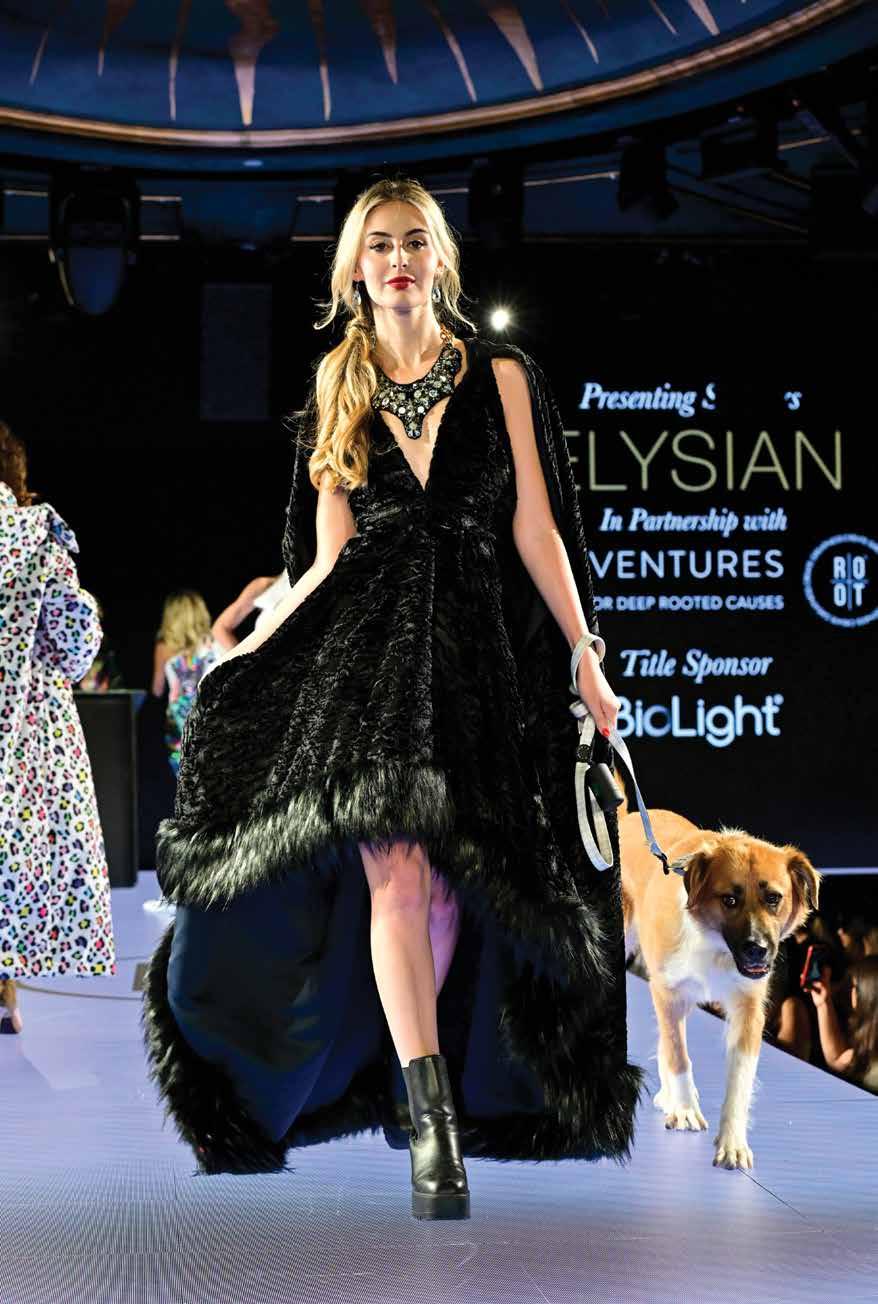

• printemps 2025 • l’édition sur les animaux de compagnie et la philanthropie • readelysian.com

and continue to push boundaries and make a difference in the world,” Scott said.
“CatWalk FurBaby not only uses our platforms to promote the missions of so many wonderful organizations, but it is also a celebration of their stories, their missions . . . all under one roof. The energy is infectious. To believe that anyone’s dream is possible—whether you are a model or designer, established or new to the industry—along with the opportunity for animals to be adopted, and for nonprofits to join and share their missions… It truly is a remarkable experience.”
In the end, three charities took home cash prizes:
• COMPANION ANIMAL ALLIANCE out of Baton Rouge, Louisiana, won the People’s Choice Award for raising the most funds for the event. They were represented on the runway by Jamie Glas Odom, the Queen of Sparkles, who was wearing her own design and was accompanied by Little Dog.
• The Publisher’s Pick went to Texas-based OPERATION KINDNESS, which was represented by model Gia Skova and Daisy the Pomeranian wearing D’Marsh Couture by Glenroy March.
• The Judge’s Award—selected by SoHo Muse founder Consuleo Vanderbilt Costin, supermodel Carol Alt, and chocolatier Maribel Lieberman—went to New York’s own SECOND CHANCE RESCUE, which saw model Rachel Donohue and pup Eunice showcasing Nicole Miller & Pamela Johananoff’s Canine Cashmere.
The idea behind CatWalk FurBaby is rooted in the essence of the ELYSIAN woman—women who are lifelong learners; who are leaders in their homes, communities and the business, political and nonprofit sectors; and who constantly try to better themselves and, through the power of their voice and their philanthropy, the world around them. Ripples making waves making change.
“If there was one runway show that felt warm, inclusive—and dare I say it, fun—it was ELYSIAN’s CatWalk FurBaby Fashion Show,” Nadja Sayej wrote in Forbes. “ . . . Each pet garnered ‘awws’ from the audience, and some got treats at the end of the runway, as they were photographed by a wall of over a hundred photographers packed into Sony Hall.”
In her opening, Floyd noted that ELYSIAN is “as complicated and complex as women,” because women are multifaceted—we are artists, entrepreneurs, scientists, thought-leaders, mothers, daughters . . . and peacemakers. We often juggle many of these roles at once.
And so the explosion of talent and energy on the runway this past fall was fitting and appropriate. From the opening live performance by DJ Chloe Jane, previewing her latest single Dance Floor Emergency, to the range of
Below/left-right: Jean Shafiroff and Rosita represented New York Women’s Foundation. Jean wore a gown by Ashley Plasse, the youngest designer at CatWalk FurBaby and a Fashion Institute of Technology student. • On the runway, Marley’s Mutts was represented by Melissa Brunson alongside Hannah. Melissa wore a beach-chic ensemble by Pitaya titled “Living Your Best Life, One Vacay at a Time.” The design radiated sun-kissed confidence, embodying Pitaya’s ethos of self-care, empowerment, and embracing unique beauty. • Opposite Page: Animal Advocates was represented on the runway by model Kristin Thorne and Chester, a terrier mix. Kristin showcased an ensemble by Lev-i-Rosa titled “A Walk on the Wild Side of Rescuing.”

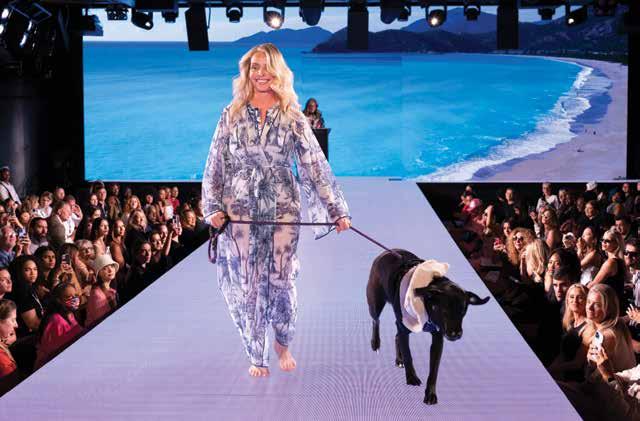
Representing WLS Foundation on the runway, model Reese Connor and Kirk, a wire-haired terrier, wore a design by Ukrainian designer Halynka Shunevych entitled “Protector of the Carpathian Forest.” This creation, inspired by the green hues of the Carpathian Forest and the circular patterns found in nature, symbolizes courage, healing, and resilience. PHOTOGRAPH BY PMC / JARED SISKIN
1 2
• printemps 2025 • l’édition sur les
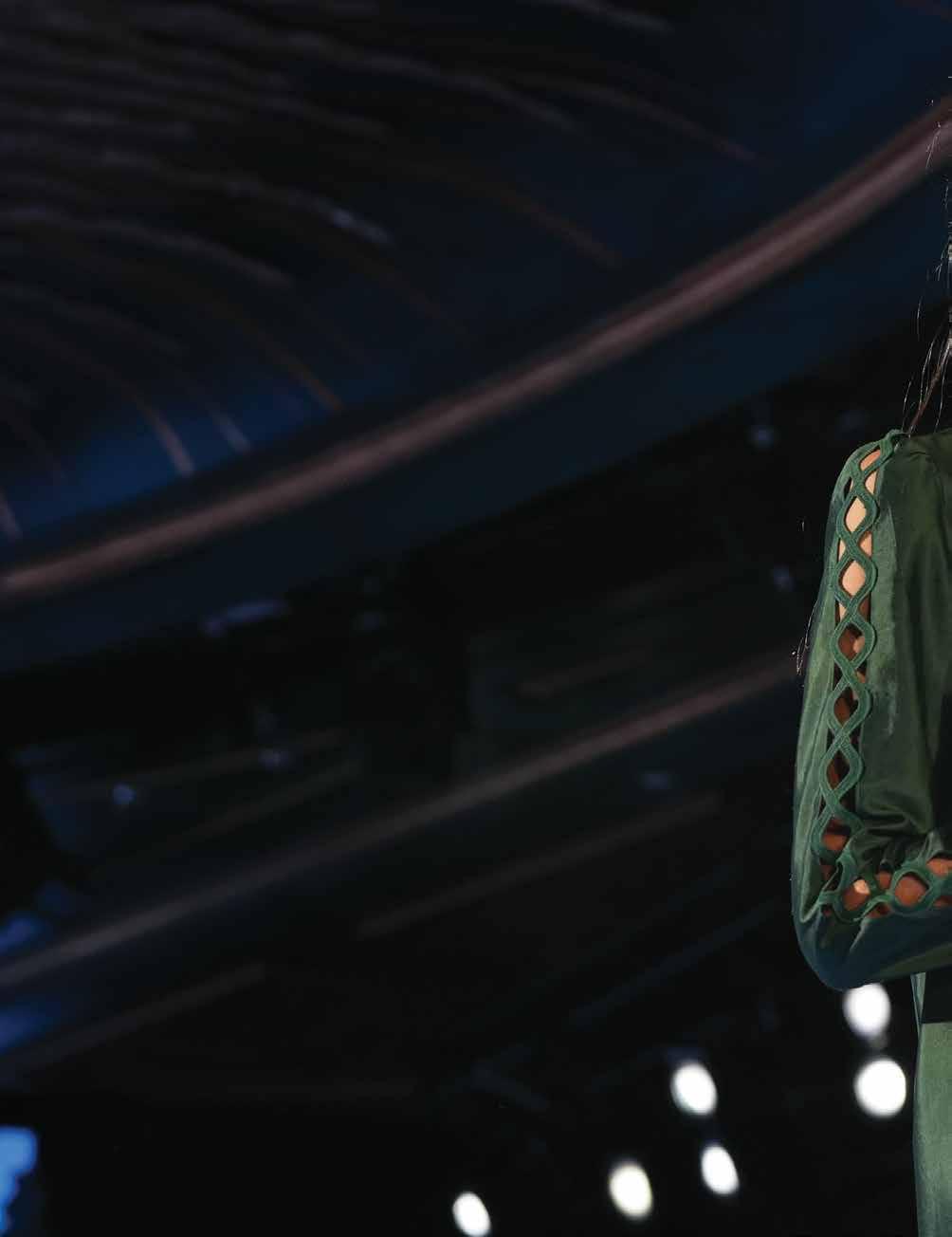
les animaux de compagnie et la philanthropie • readelysian.com
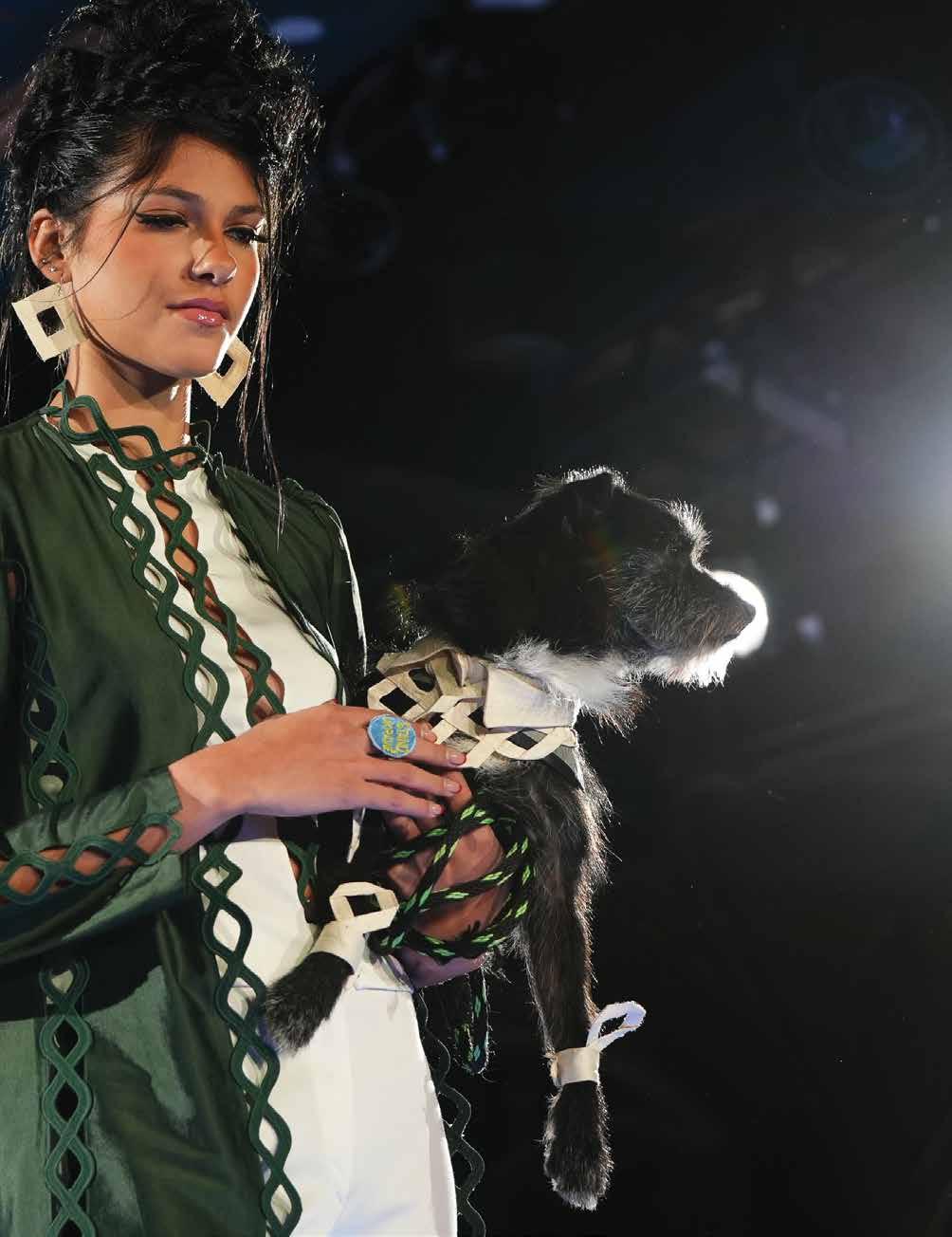

The Center for Family Services was represented by Mary Bryant McCourt and Precious, both dressed in a whimsical Caryna Nina design titled “Princess Dress.” This enchanting look symbolizes the idea that all children should feel like royalty and that all puppies deserve love and care. The cotton halter dress featured a dramatic horsehair hemline, while Precious dazzled in a matching pink tulle tutu adorned with sparkling embellishments. Together, their ensembles conveyed the innocence and joy the center strives to restore in the lives of those they serve. • Opposite page: Representing Original Six Foundation were model Sadie Miller and her Yorkie, Lily. Sadie donned a dazzling ensemble by Any Old Iron titled “Reaching for the Stars.” The matte black-andwhite sequin blazer and fit-and-flare trousers are adorned with a star pattern unique to the brand. This empowering look symbolizes limitless opportunities, reminding us to “reach for the stars” and embrace our boundless potential.
PHOTOGRAPHS BY PMC / JARED SISKIN
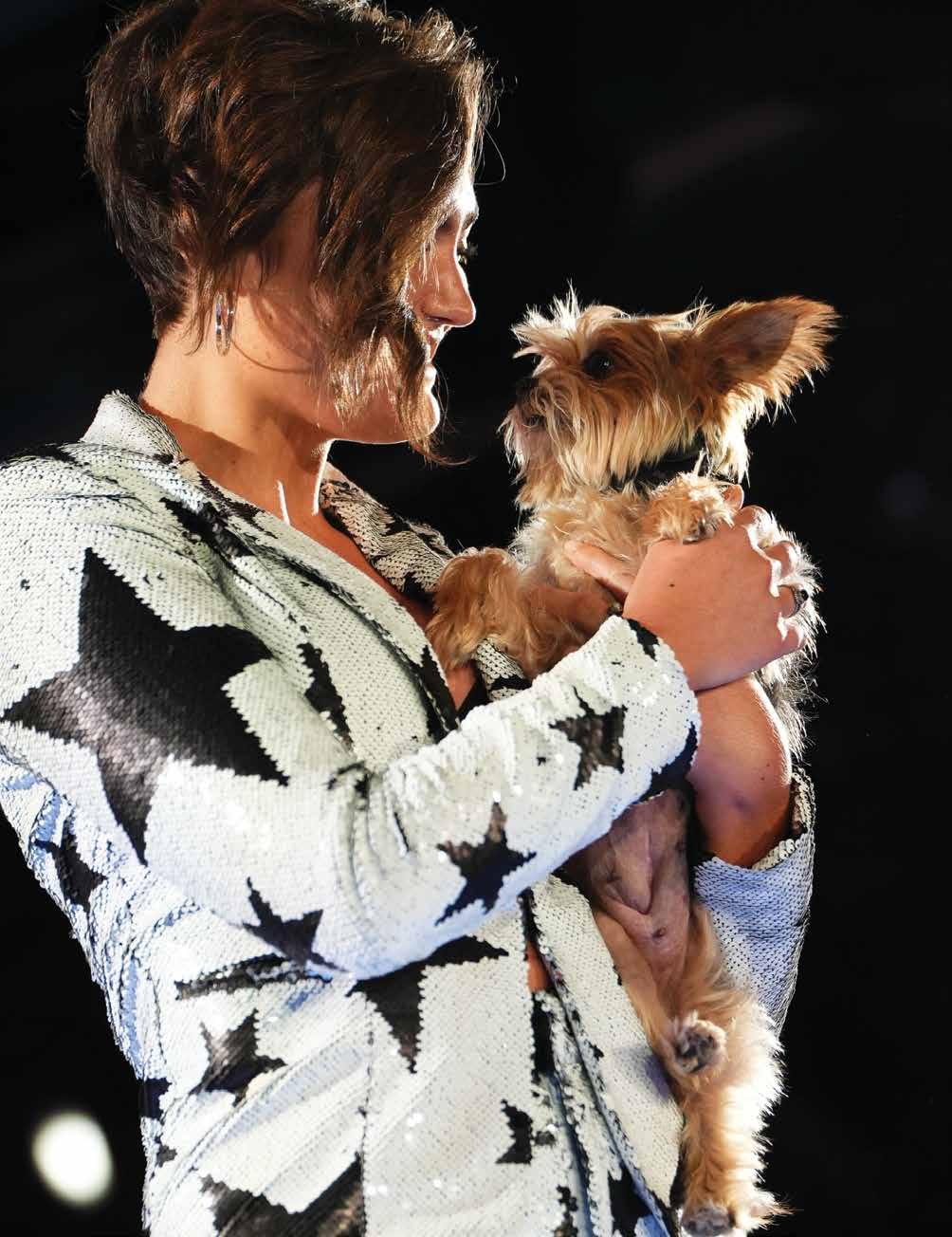
sounds that played as the models graced the stage, CatWalk FurBaby 2024 was full of high energy, high fashion, and high impact.
The slate of designers participating in this year’s event was nothing short of phenomenal. While most fashion shows are for a single designer, CatWalk FurBaby showcased the talent of 21 different fashion houses, from Tommy Hilfiger to Project Runway alum Jonathan Kayne to former incarcerated individual Halim Flowers.
“I love doing CatWalk FurBaby, it’s a lot of fun,” said designer Gina Marie Roberts, founder of Brooke Wilder Atelier. Roberts participates in three or four fashion shows each year and is a two-time CatWalk FurBaby participant.
“What they are doing—bringing fashion into a more philanthropic, relatable mindset—is a wise decision,” she said. “The fashion world has set itself too far apart. This helps bring fashion to a place where people can connect a little bit more, because nothing tugs on heartstrings more than a charity and a dog. And us Americans, we love a good cause.”
The iconic Sony Hall in Midtown Manhattan once again served as CatWalk FurBaby’s venue. Its storied past provided an elegant backdrop for such a forward-looking concept to shine. One fashion line, Merci Dupre Clothiers, uses fashion and innovation to protect its wearer and the environment from harmful toxins.
Merci Dupre showcased 14 looks that embodied a movement toward a healthier future.
“We are here to make global changes,” founder Dr. Christina Rahm said, kicking off the second half of the show. “When there are global issues . . . Think about this: That’s our opportunity to evolve and be more beautiful. And being more beautiful means from the inside out.”
Merci Dupre Clothiers is dedicated to reshaping the fashion industry by integrating healthconscious innovations into its designs. Its mission is to create clothing that not only elevates style but also safeguards the wearer from harmful environmental elements. Ripples, waves, change.
As the winning charities use their prize money to further their own missions, ELYSIAN is hard at work on a new documentary about CatWalk FurBaby 2024—how a small team from Spartanburg, South Carolina, took New York Fashion Week by storm to touch countless lives. All participating charities will have access to the film to use for their own fundraising.
As the event unfolded, Floyd rounded out her message with one final charge: “Let’s make history together.” We did.
And together, we will continue to do so. ■
printemps 2025 • l’édition sur les animaux de compagnie et la philanthropie • readelysian.com •

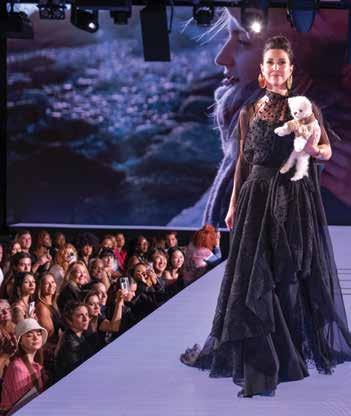
Model Ali Klebous and Vespar, a tan mix, represented Rescue Dogs Rock NYC. Yulia is known for reimagining traditional Ukrainian themes in contemporary designs. Ali’s look embodied the concept of a Nature Queen, a regal figure symbolizing hope, vitality, and resilience. They showcased a Yulia Fashion House ensemble. • Rikki Harris and her dog, Einstein, represented the Rahm Foundation. Rikki wore an elegant Merci Dupre Clothiers design inspired by the natural world. The outfit’s sustainable materials and earthy textures pay homage to the environment, emphasizing the importance of eco-conscious fashion. This design celebrated the planet’s beauty while highlighting the foundation’s dedication to sustainability and environmental preservation. • Opposite page: Nebras Hayek represented her own foundation, Nebras Hayek Foundation, accompanied by Kiki, a Boston terrier mix. Nebras wore a Shernett Swaby design that was fierce, empowering, and transformative. The gown symbolizes the duality of abuse—the visible facade and the unseen pain that lingers beneath.


printemps 2025 • l’édition sur les animaux de
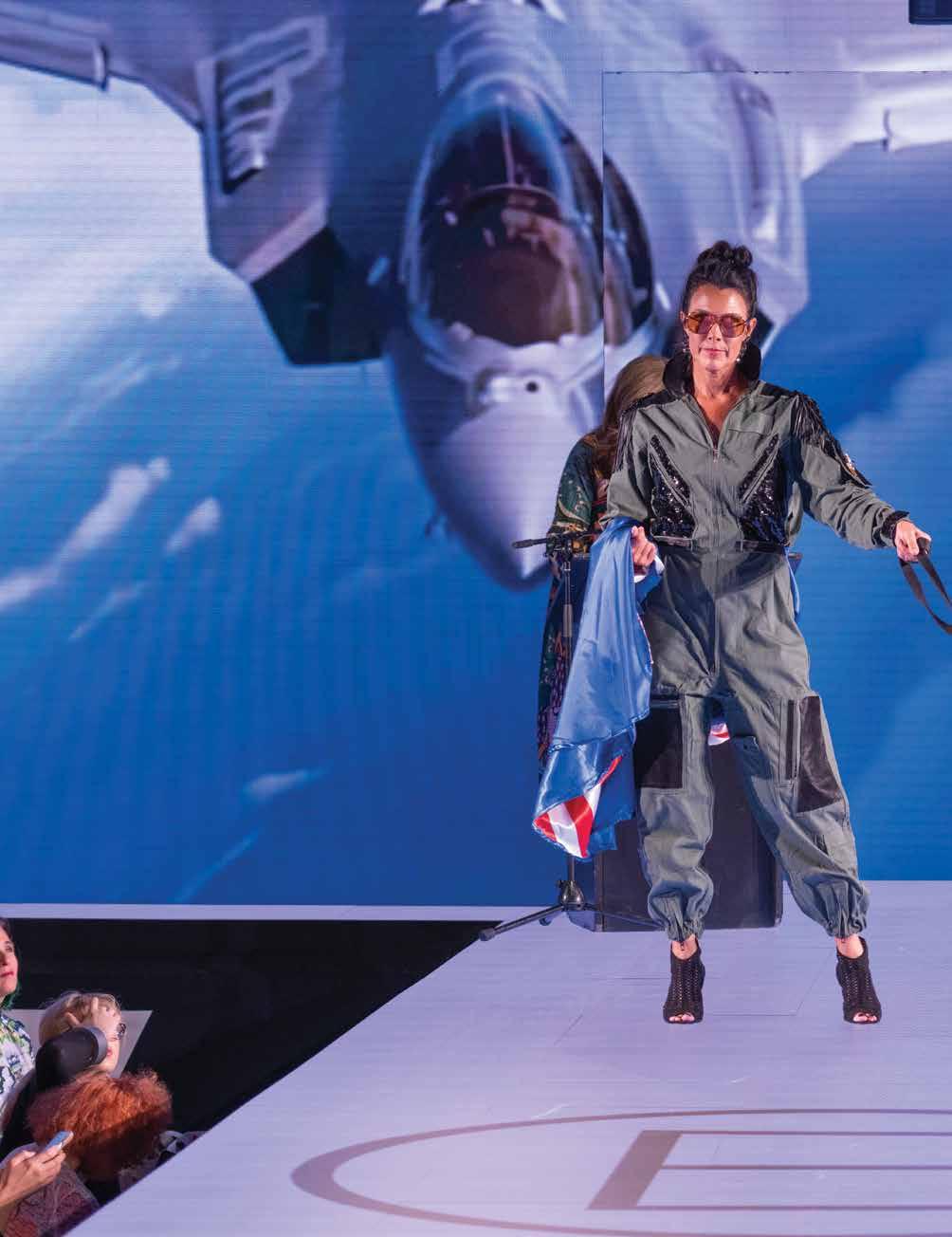
compagnie et la philanthropie • readelysian.com •
1 1 9
Guns Garin was represented by Tanya Ward and Rolo the Rottweiler. Tanya wore a VirSal ensemble titled “A Salute to Service,” a modern interpretation of the iconic military flight suit. This empowering women’s jumper features patriotic accents and symbolizes honor, strength, pride, and duty, paying tribute to the legacy of military aviation and those who serve.
PHOTOGRAPH BY DREAM TEAM CREATIVES

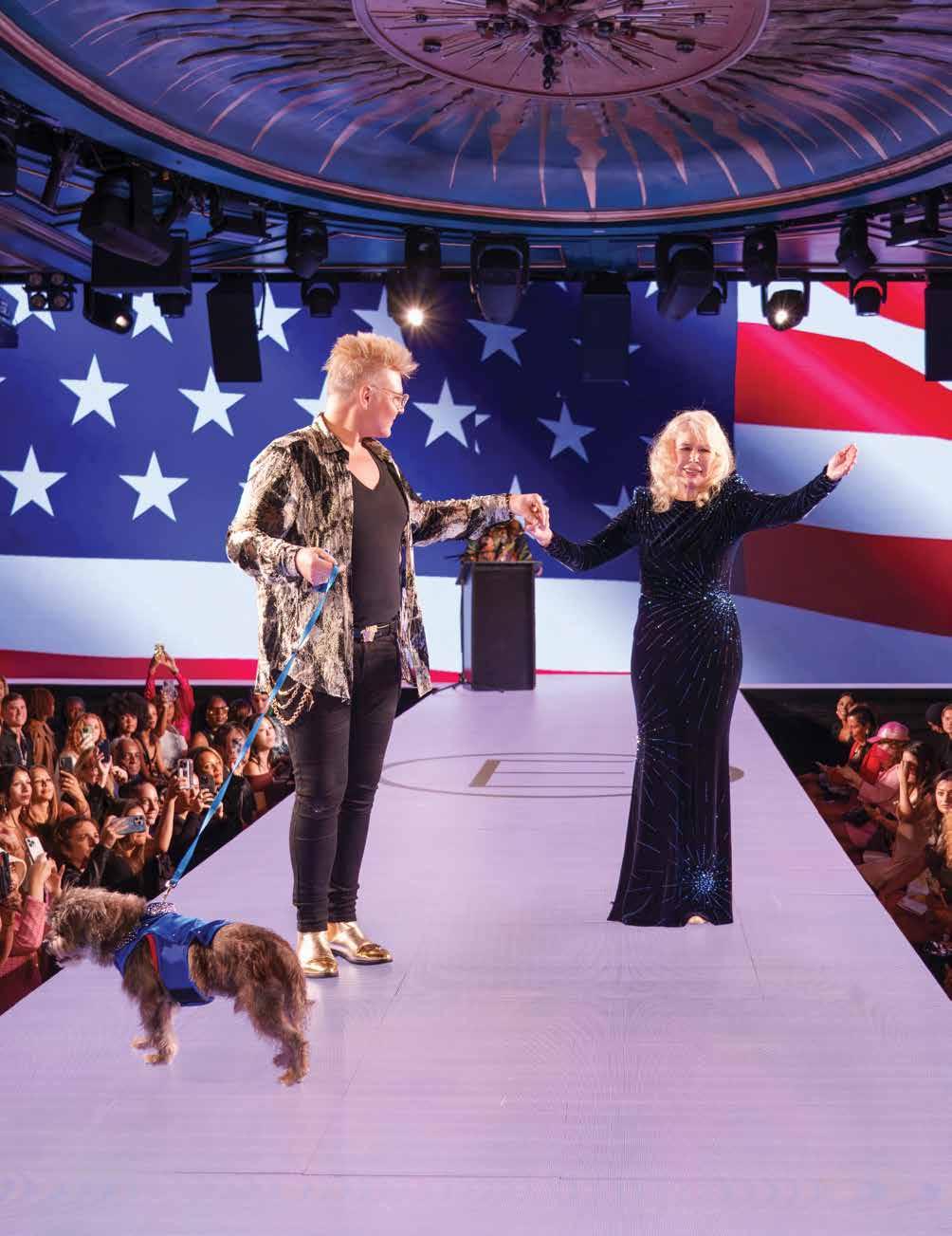
Honoring America’s Veterans was represented by actress Loretta Swit, renowned for her role in MASH (1972–1983), accompanied by Ziggy, a shih tzu-terrier mix. Loretta wore a custom concept by Nashville designer and Project Runway alum Johnathan Kayne titled “Radiant Beauty.” Crafted from navy stretch velvet with matching navy crystals in a fireworks pattern, the ensemble exudes strength and elegance. Inspired by Loretta’s radiant smile and his family’s military ties, Kayne designed the piece to be empowering and celebratory.
PHOTOGRAPH BY
• Opposite page: Designer/Model Jaime Glas Odom and Little Dog, a papillon-chihuahua mix, represented Companion Animal Alliance on the runway. Known as the “Queen of Sparkles” for her vibrant, eye-catching designs, Odom wore her creation, “Diamond in the Ruff,” a colorful, pop-art-inspired ensemble adorned with bright hues and shimmering details.
PHOTOGRAPH BY

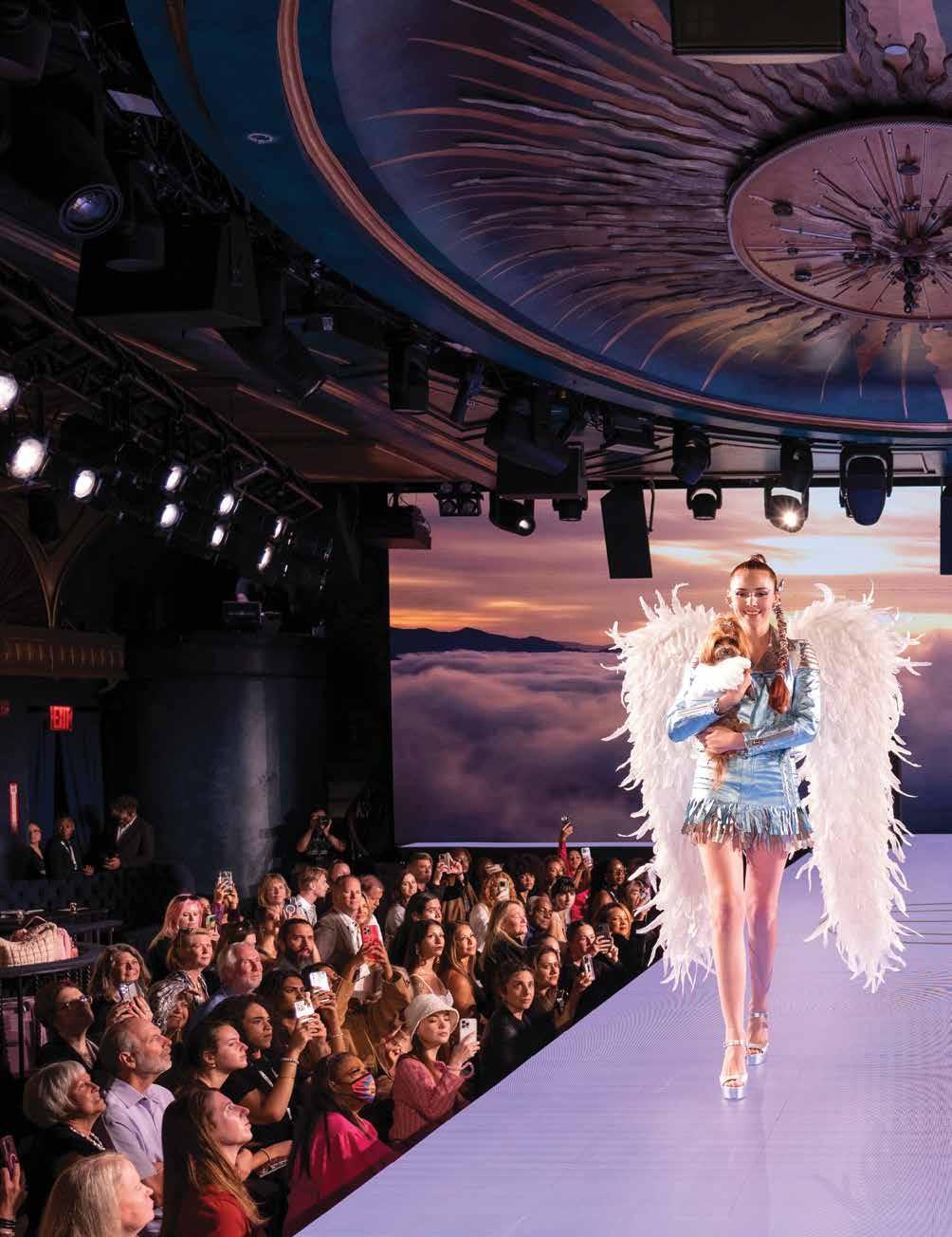


PHOTOGRAPH BY PMC / JARED SISKIN
7 • Right: Model Belle Scott, accompanied by Fiona, a German shepherd mix, wore a Brooke Wilder Atelier concept designed by Gina Marie Roberts called “She is Hope.” This piece, represetnting the American Red Cross, pays tribute to the strength and compassion of women in the Red Cross. The design artfully combines structure and flow, symbolizing resilience and heroism.
PHOTOGRAPH BY
“Diana: Goddess of the Hunt.” This design symbolizes survivorship, grace, and strength, evoking the goddess Diana as a protector of women and a patron saint of survivors.
Left: Representing Silent Tears, Model Cali Nguyen and Fizz, a Pomeranian, graced the runway in a Salacious Fruit ensemble titled
•
• readelysian.com
printemps 2025 • l’édition sur les animaux de compagnie et la philanthropie

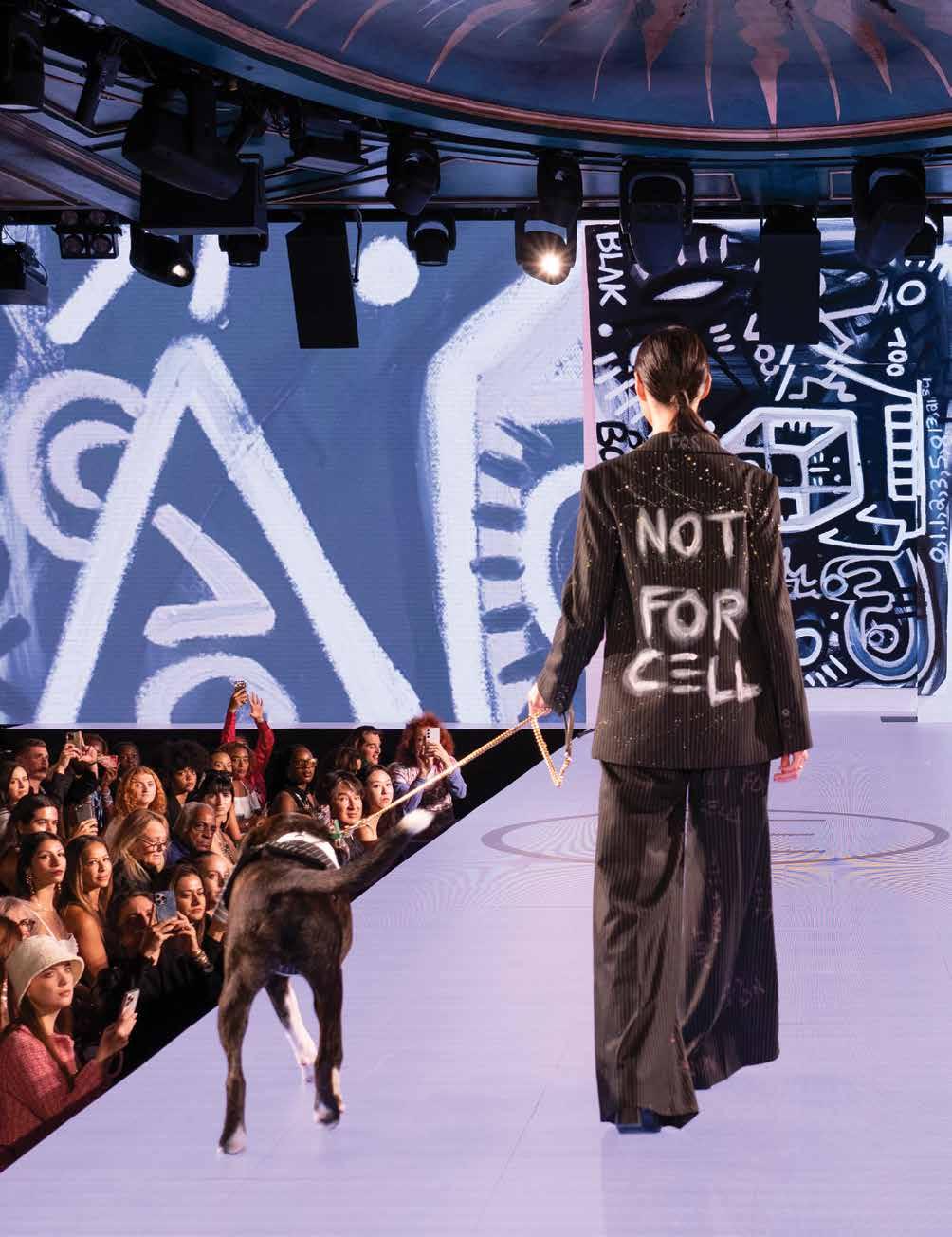
Charleston Alternative to Detention was represented on the runway by model Saskia Lindsey and her brindle companion, Mardi. Saskia wore a striking design by Halim Flowers, a multi-talented artist, designer, writer, activist, and entrepreneur, who was sentenced to life in prison at age 16 and served 22 years before his release. His thought-provoking piece, “Not for Cell,” featured a hand-painted black-andwhite pinstripe suit, symbolizing themes of incarceration, Black Wall Street, love, and the untapped potential of youth.
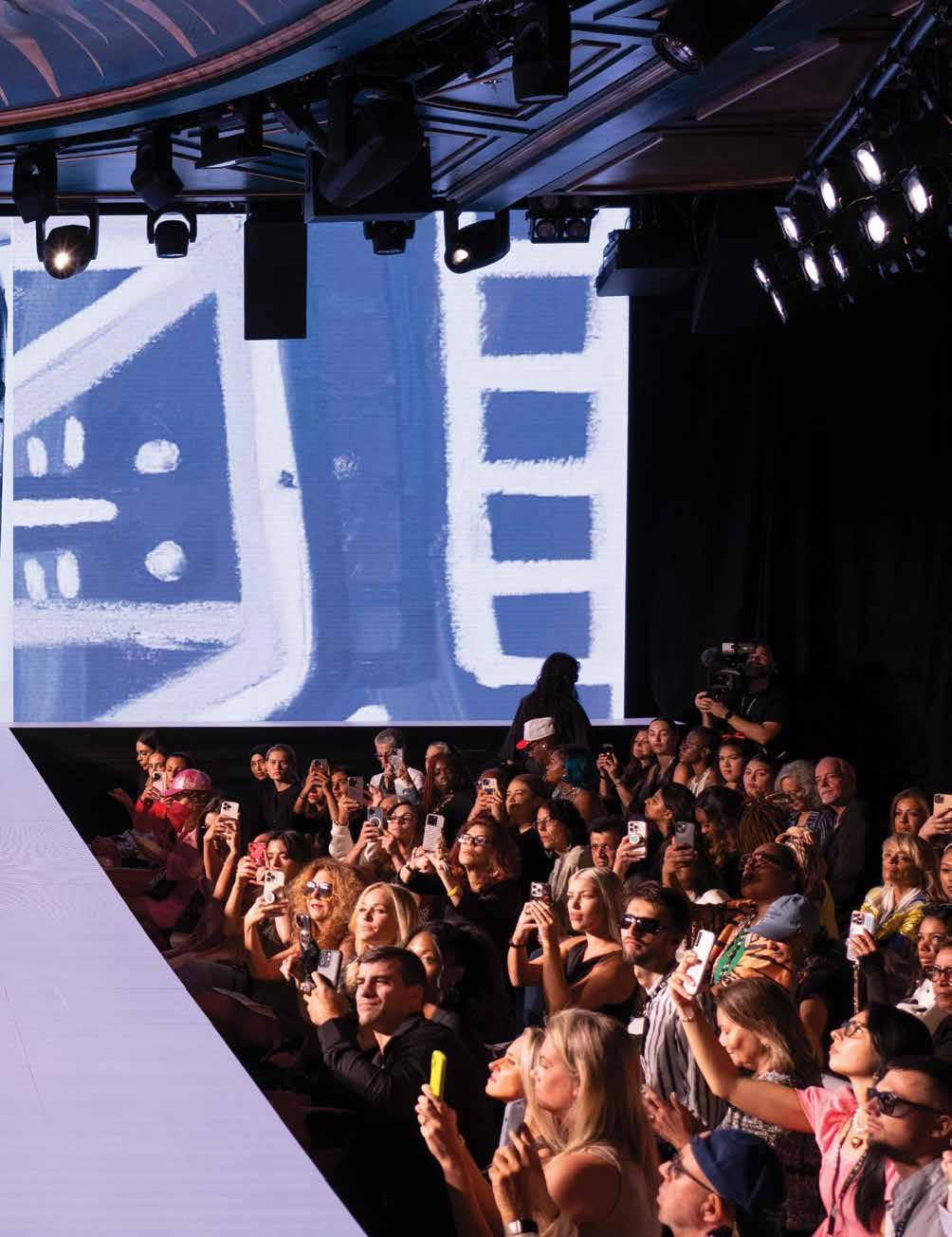


Chloe Jane is a rising star in the dance-pop music scene, known for her bold melodies, vibrant energy, and powerful vocals. She kicked off CatWalk FurBaby 2024 with a performance of her new single, Dance Floor Emergency, which she officially released at midnight. One of the defining features of Chloe Jane’s music is her ability to craft songs that are both radio-friendly and club-ready. Tracks like Let Me In and Bad Boy showcase her knack for producing infectious beats that get listeners moving, while her lyrics explore themes of longing, romance, and personal growth. Her smooth, yet dynamic vocals add a layer of depth to her tracks, allowing them to transcend the typical dance-pop formula. As a songwriter, she takes pride in writing her own music, often using personal experiences to fuel her creative process. With her infectious energy, unique sound, and undeniable talent, Chloe Jane is on her way to becoming a prominent name in the global music scene. Whether she’s topping the charts or energizing the dance floor, she is a force to be reckoned with in the world of modern pop music.
PHOTOGRAPH BY DREAM TEAM CREATIVES
1 2 9
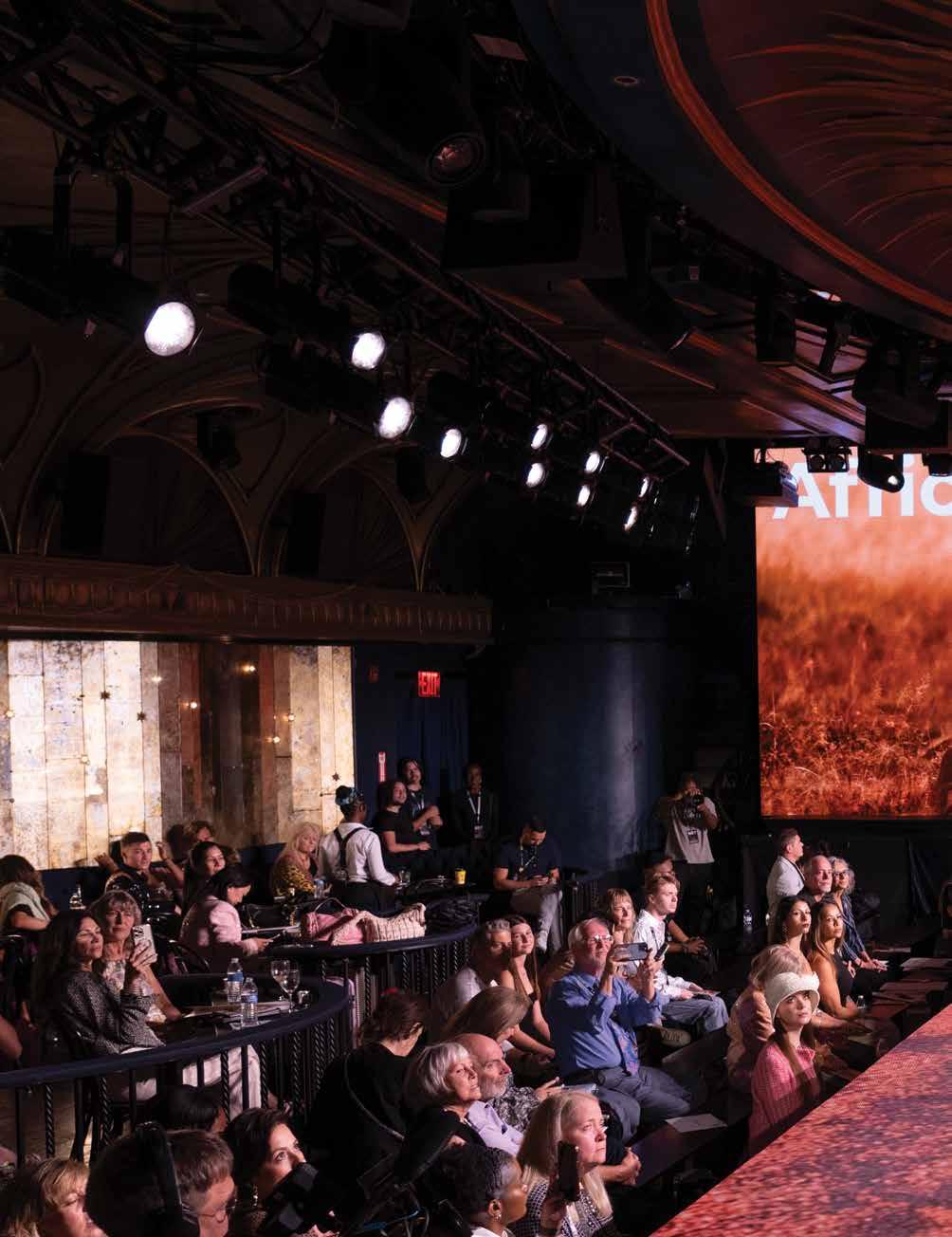
During New York Fashion Week, Merci Dupre Clothiers by Dr. Christina Rahm unveiled its groundbreaking collection. This unique line, known as Enviremware, seamlessly combines cutting-edge fashion with scientific innovation, redefining the boundaries of wearable technology. The Enviremware line features patented, nanobiotech formulas infused into the fabric through a specialized 96-hour process. This advanced technology creates an unbeatable barrier against EMF radiation, heavy metals, viruses, bacteria, parasites, and fungi. Additionally, the clothing supports protection against radio frequency electromagnetic particles from 5G cellular transmission, offering a new level of safety and wellness for the modern wearer. As a pioneering scientist and fashion engineer, Rahm’s vision brings together sustainability, protection, and style, empowering individuals to embrace clothing that not only looks exquisite but also shields them from the environmental toxins of the modern world.

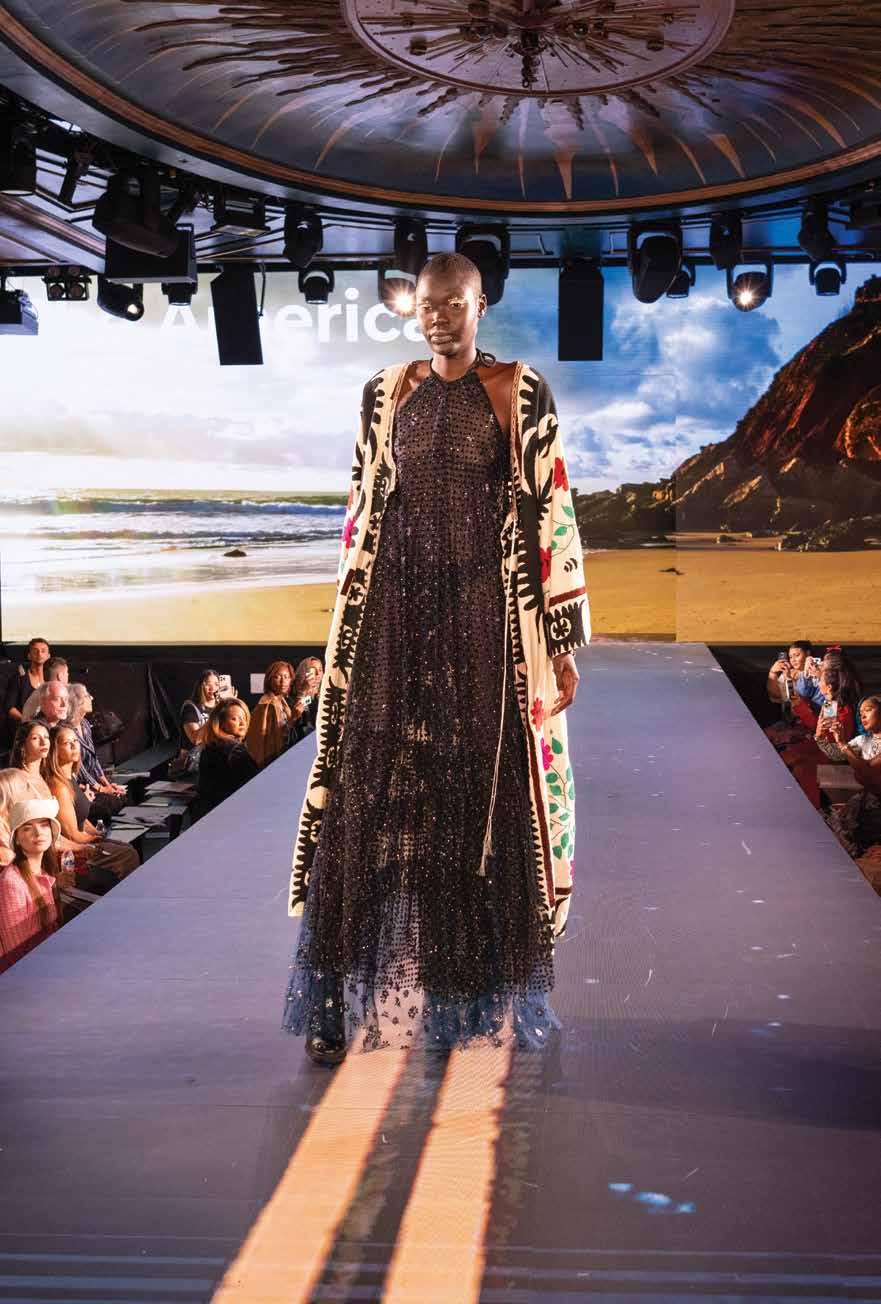


Merci Dupre Clothiers by Dr. Christina Rahm. PHOTOGRAPH BY PMC / JARED SISKIN
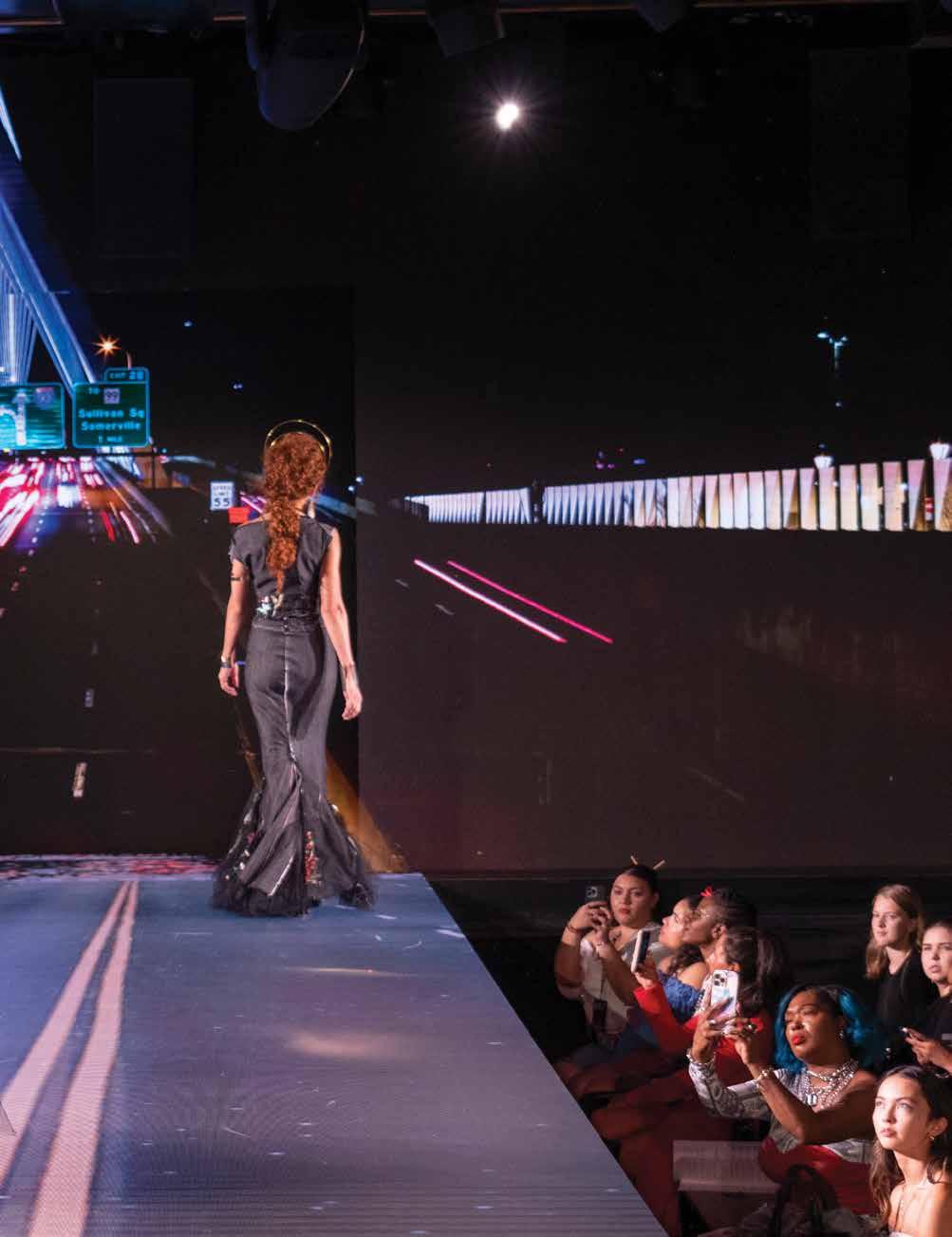

Merci Dupre Clothiers by Dr. Christina Rahm. PHOTOGRAPHS BY PMC / JARED SISKIN

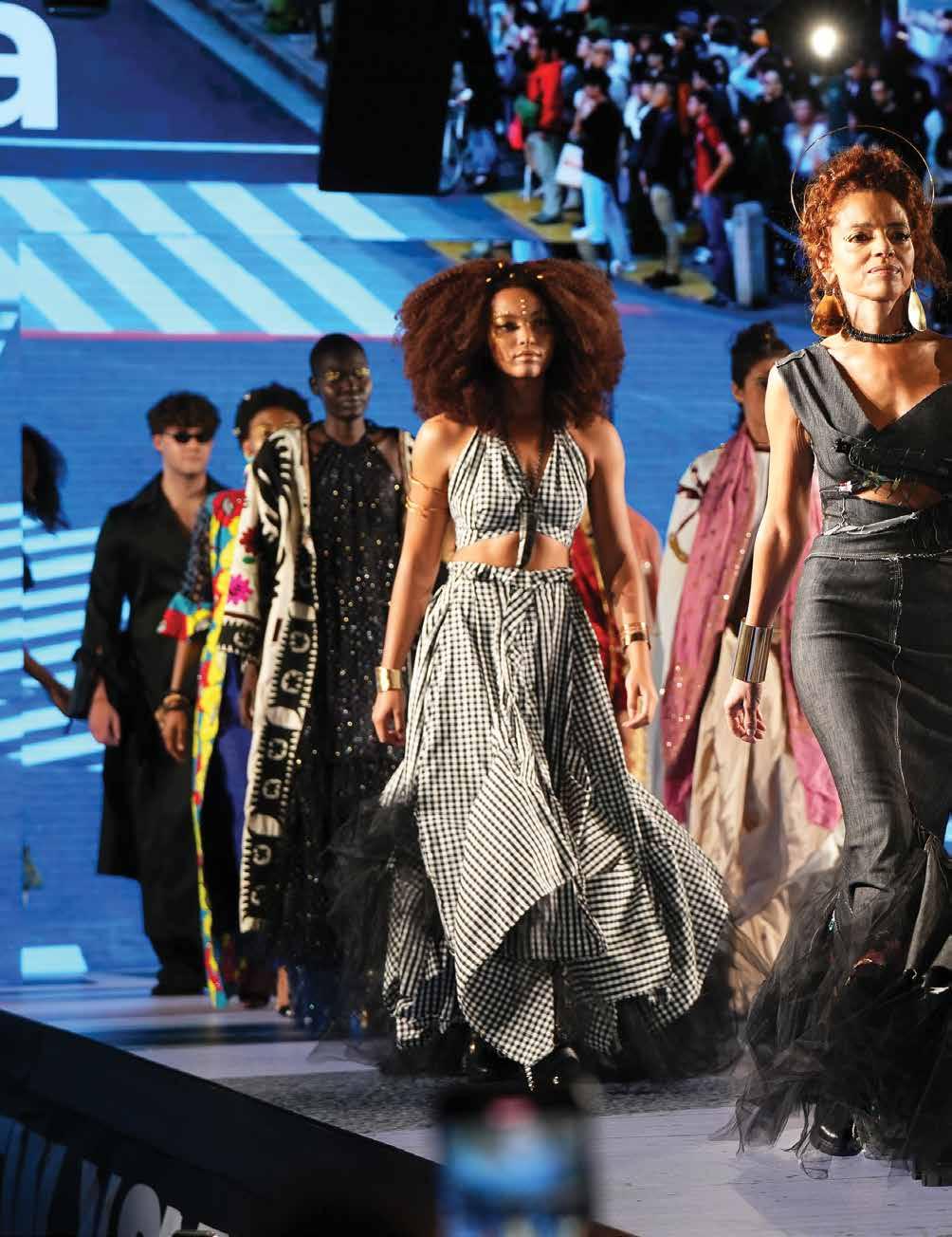
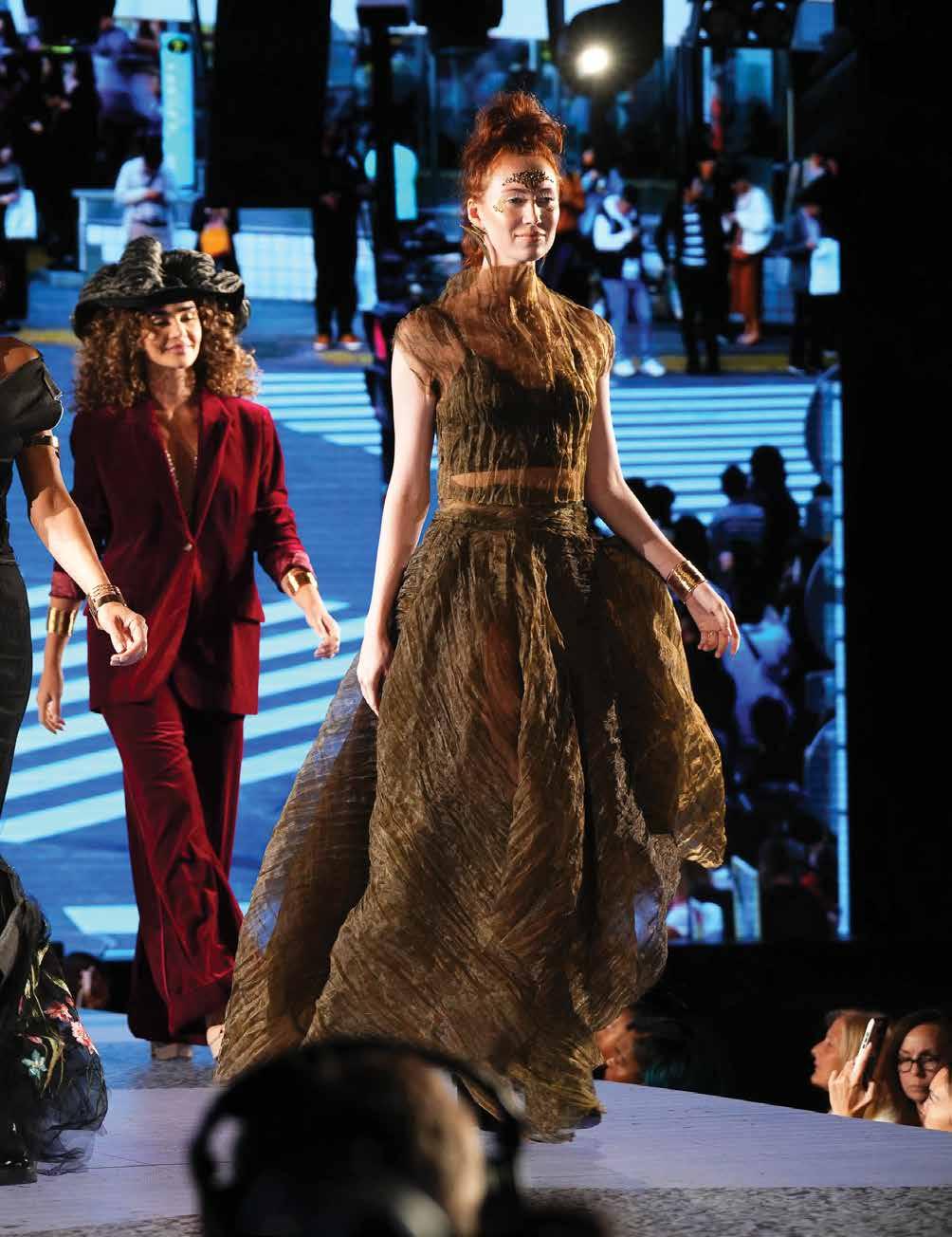
Merci Dupre Clothiers by Dr. Christina Rahm.
PHOTOGRAPH BY PMC / JARED SISKIN

printemps 2025 • l’édition sur les animaux de compagnie et la philanthropie • readelysian.com •
Merci Dupre
Clothiers by Dr.
Christina Rahm.
PHOTOGRAPHS
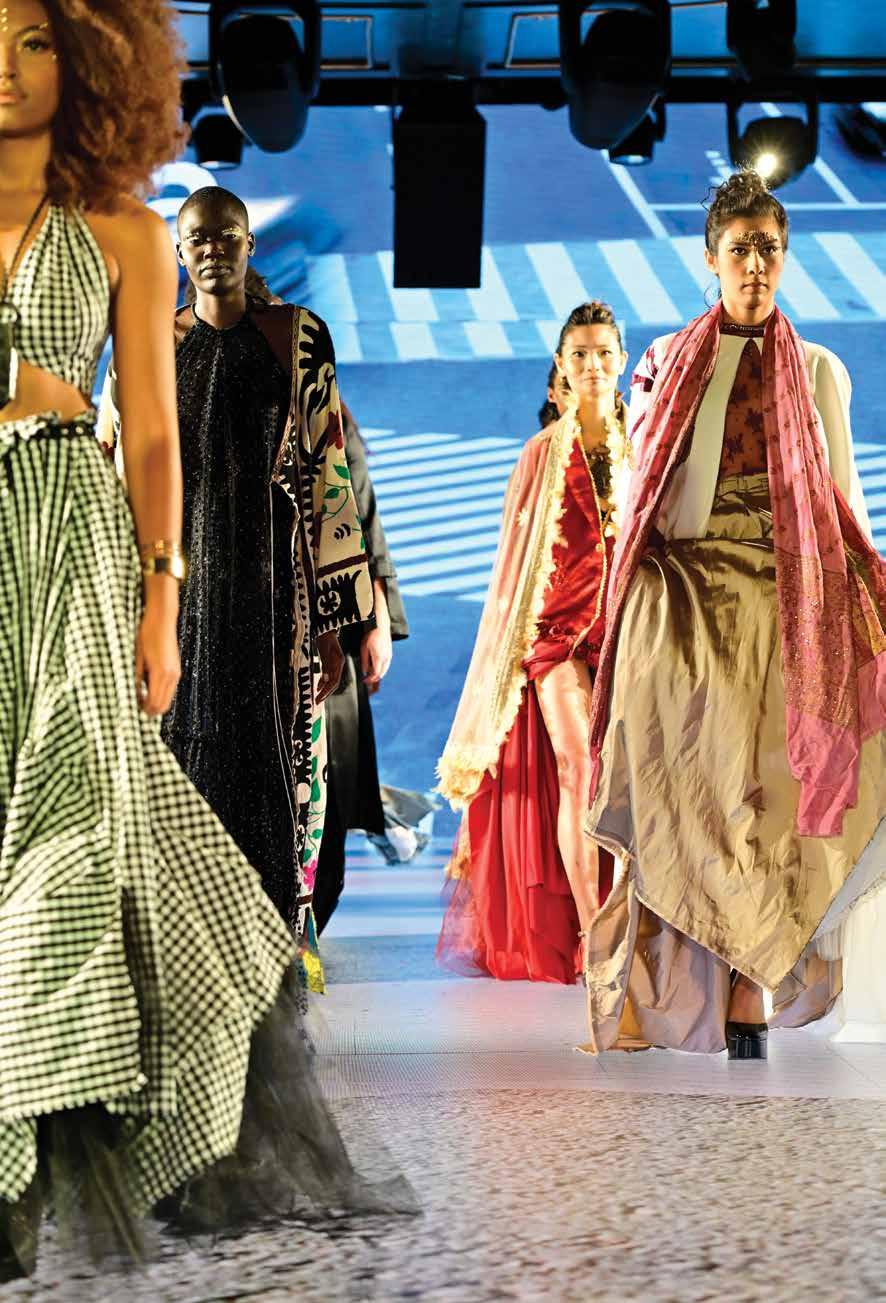
• printemps


2025 • l’édition sur les animaux de compagnie et la philanthropie • readelysian.com
Dr. Christina Rahm addresses the audience at the close of her celebrated unveiling of Merci Dupre Clothiers new Enviremware
PHOTOGRAPH
1 4 4
• printemps 2025 • l’édition sur les animaux de compagnie et la philanthropie

philanthropie • readelysian.com
Eccentricities of a Cat Artist
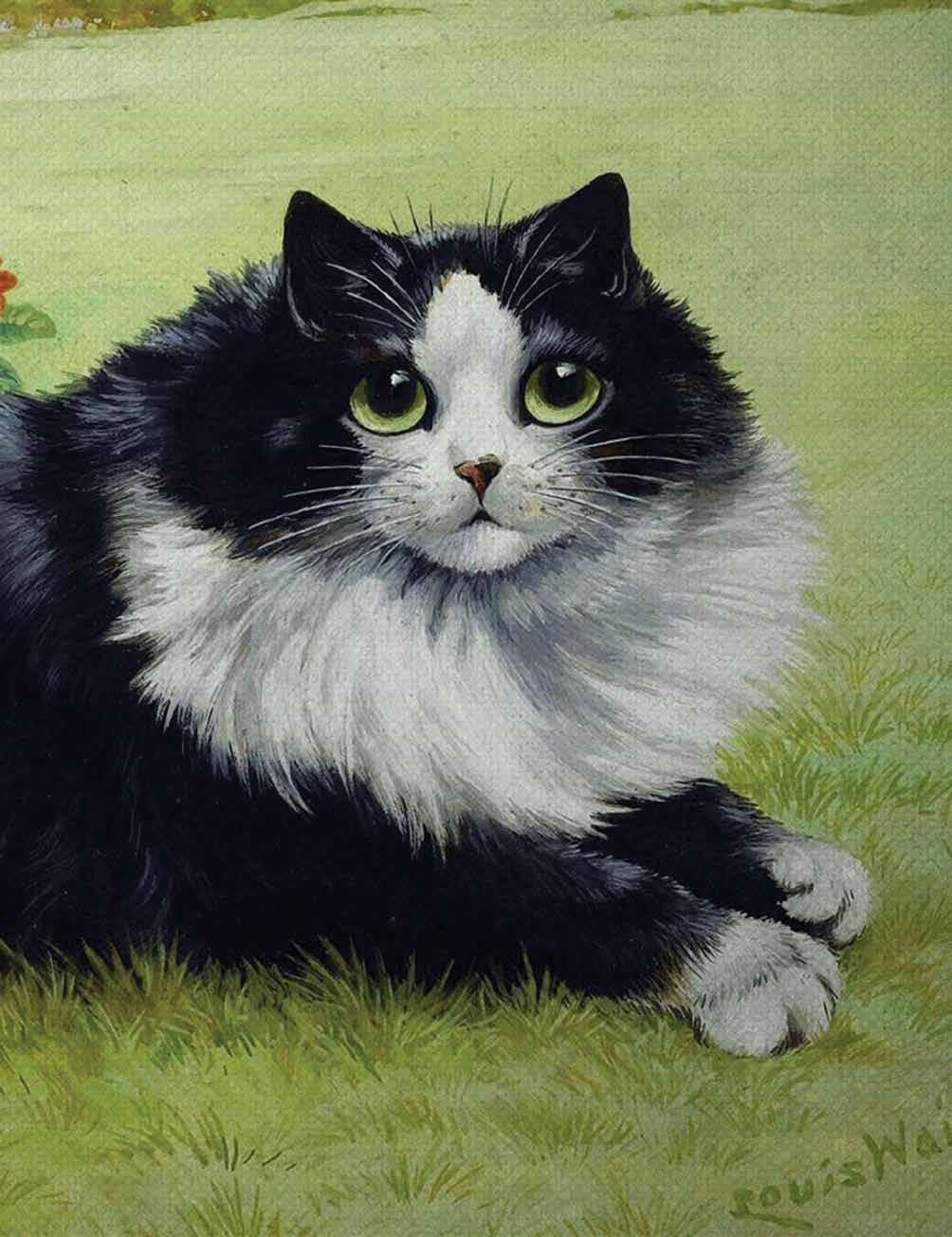
Artist’s muse— Peter, in front of the Louis and Emily’s home by English artist Louis Wain. PHOTOGRAPH BY TCD/PROD.DB / ALAMY STOCK PHOTO
by Marcy Dubroff

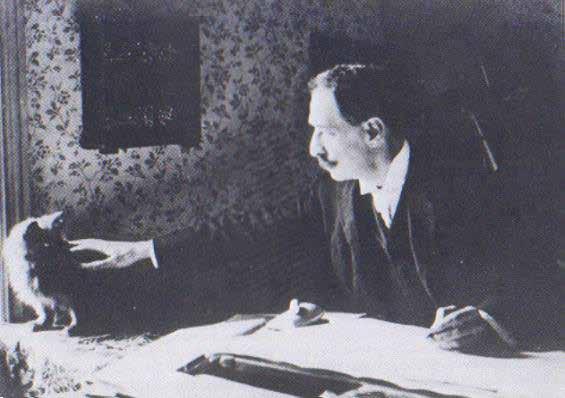
1 L
ouis Wain (1860–1939) is remembered as one of Britain’s most eccentric and beloved artists, best known for his whimsical, anthropomorphic illustrations of cats. His works, vibrant with humor, charm, and an unmistakable sense of personality, captivated audiences during the late 19th and early 20th centuries and continue to hold cultural significance today. His art helped transform public perceptions of cats, elevating them from utilitarian creatures to cherished companions. It also mirrored the complexities of Wain’s personal life—marked by tragedy, mental health struggles, and financial difficulties. Through his art, Wain reshaped the visual landscape of his time and society’s relationship with animals, leaving a legacy that resonates far beyond his era.
Early Life and Artistic Beginnings
Louis William Wain was born on August 5, 1860, in Clerkenwell, London. Wain, the eldest of six children, was raised in a household that faced significant financial struggles after the death of his father, William Matthew Wain, a textile trader. As the primary provider for his mother and siblings, Louis took on a responsibility far beyond his years. Yet, from an early age, he demonstrated a flair for drawing, an interest that was nurtured in a creative environment. His mother, Felicia Marie Boiteux, was of French descent and worked as a seamstress, which may have influenced Louis’s early exposure to design and textiles.
After attending the West London School of Art, Wain briefly became a teacher there before pursuing a freelance career in illustration. His early works were varied, capturing everything from rural landscapes to architectural sketches, but his depictions of animals first gained recognition. Wain’s keen observational skills were evident in his lifelike renderings of creatures, which set the stage for his later, more whimsical and imaginative works.
The Birth of the Cat Art Phenomenon
In 1884, Wain’s life took a significant turn when he married Emily Richardson, his sisters’ governess. Emily was ten years older than Wain and was soon diagnosed with breast cancer, a tragedy that profoundly impacted both their lives. As Emily
Louis Wain at his drawing board, 1890s.
PHOTOGRAPH BY
Opposite: Dark-Eyed Cat by Louis Wain.
PHOTOGRAPH BY ARTGEN


printemps 2025 • l’édition sur les animaux de compagnie et la
philanthropie • readelysian.com •
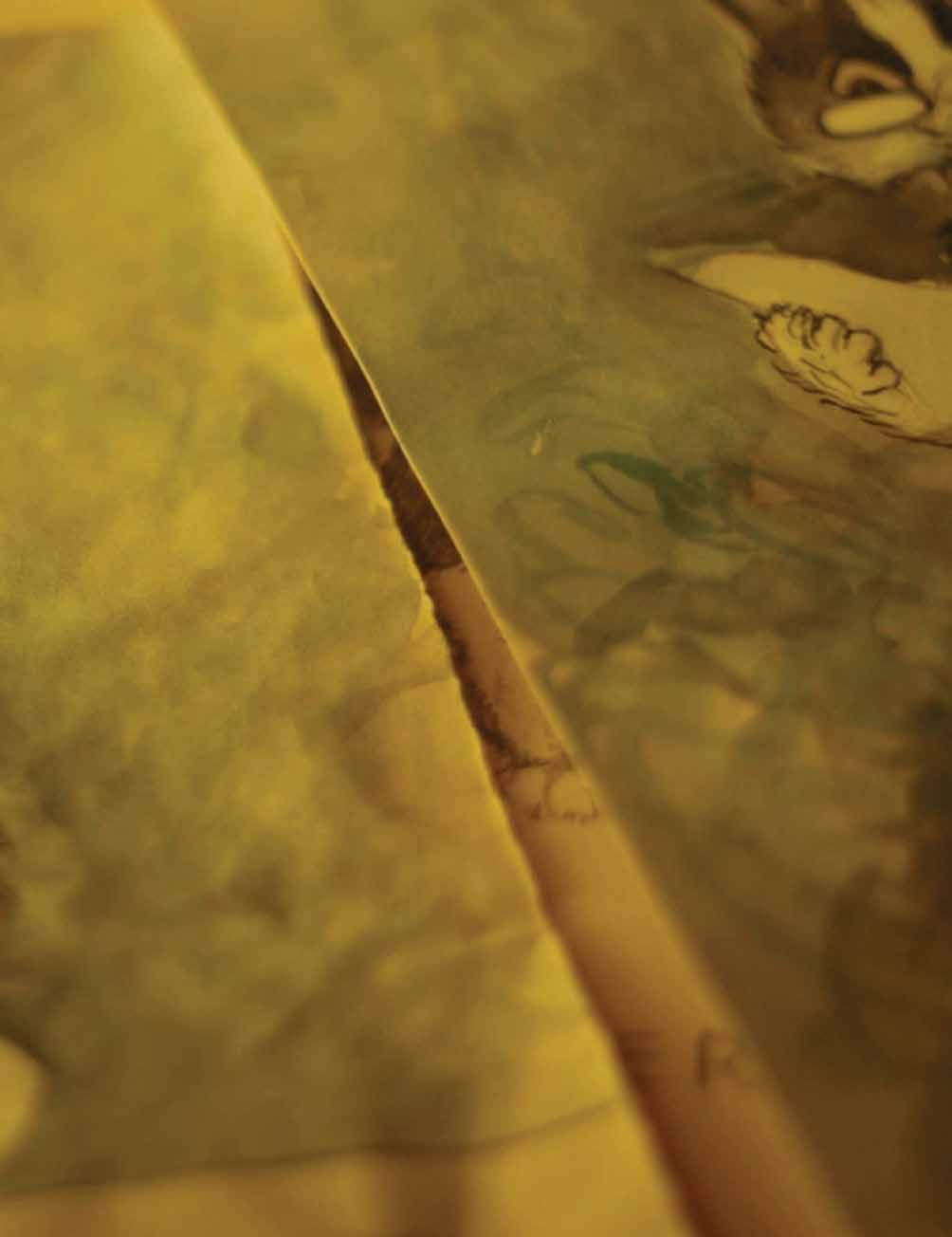
Still of Louis Wain illustrations from the feature film The Electrical Life of Louis Wain, 2021, by Will Sharpe Prod DB © Amazon Studios - Film 4 - Shoebox Films - StudioCanal - SunnyMarch.
PHOTOGRAPH BY TCD/PROD.DB / ALAMY STOCK PHOTO
White Cat and Roses by Louis Wain. Wain produced hundreds of drawings and paintings a year for periodicals and books, including Louis Wain’s Annual which ran from 1901 to 1921. His work also appeared on postcards and advertising, and he made brief ventures into ceramics and animated cartoons. In spite of his popularity and prolific output, Wain did not become wealthy, possibly because he sold his work cheaply and relinquished copyright, and also because he supported his mother and five sisters.
printemps 2025 • l’édition sur les animaux de compagnie et la philanthropie • readelysian.com •
struggled with her illness, the couple adopted a black-and-white kitten named Peter. This kitten became a muse for Wain’s art, a source of comfort for Emily, and ultimately the catalyst for Wain’s iconic series of anthropomorphic cat illustrations.
Wain began drawing Peter in increasingly human-like settings, attributing him with characteristics beyond typical feline behavior—showing him dressed in clothes, playing cards, and participating in social activities. These playful, humanized depictions of cats would become the hallmark of Wain’s career. The public quickly embraced his charming, imaginative works. In 1886, Wain received a major break with a full-page Christmas illustration for The Illustrated London News titled A Kittens’ Christmas Party. In it, 150 cats were shown engaging in various human activities, such as playing games, enjoying a festive meal, and interacting like people at a party. The piece was a tremendous success and helped establish Wain as a household name.
Fame, Advocacy, & the Rise of Wain’s Cats
Throughout the 1890s and early 1900s, Wain’s anthropomorphic cats appeared everywhere— on postcards, in books, and as prints hanging on the walls of middle-class homes. His cats played cricket, attended tea parties, posed for formal portraits, and displayed a full range of human emotions, all of which delighted Victorians and Edwardians alike. The appeal of Wain’s art lay in its ability to imbue cats—traditionally seen as aloof, independent animals—with the social grace and charm of humans. In doing so, Wain elevated the status of cats, shifting them from mere pest controllers to beloved, respected family members.
Wain’s work dovetailed with the growing animal welfare movement in Britain. At a time when cats were often viewed as less respectable than dogs, Wain’s art played a key role in changing perceptions and promoting cats as affectionate companions. He was not only an artist but also a vocal advocate for animal welfare, serving as the chairman of the National Cat Club. Under his leadership, the club promoted responsible pet ownership and organized events like cat shows to celebrate the beauty and intelligence of felines.
Personal Tragedy & Artistic Evolution
Despite his success, Wain’s personal life was marked by hardship. His beloved wife, Emily, died in 1887, three years after their marriage. Stricken with grief, Wain threw himself into his art, creating cat illustrations as a way to honor Emily’s memory. However, personal tragedy was not the only challenge Wain faced. Financial instability plagued him throughout his career. Despite his widespread fame, Wain often found himself exploited by publishers and was rarely compensated adequately for his work. The burden of supporting his family and managing his finances added to his stress and contributed to his mental health struggles.
In the early 20th century, Wain’s mental health began to deteriorate. He exhibited signs of what would later be identified as schizophrenia, a condition that was exacerbated by the pressures of his personal and professional life. Wain’s mental state became increasingly unstable, and his work began to reflect this shift. His earlier, playful depictions of cats gradually gave way to more abstract and surreal pieces. His later works featured kaleidoscopic patterns, vivid colors, and intricate designs, often bordering on the psychedelic. These bold, unconventional artworks were a stark departure from the charming realism of his earlier pieces, and they would later be appreciated as precursors to modern art movements like abstract expressionism and psychedelic art.
Hospitalization & Continued Creativity
As Wain’s mental health continued to decline, he became increasingly erratic in his behavior. In 1924, he was committed to Springfield Mental Hospital in Tooting, where he spent several years. His plight caught the attention of public figures like H.G. Wells and Prime Minister Ramsay MacDonald, who advocated for his transfer to more comfortable accommodations at Bethlem Royal Hospital and, later, Napsbury Hospital. Despite his condition, Wain never stopped creating art. Some of his most vibrant and experimental works were produced during his time in these institutions. His later pieces, often hallucinatory and complex, captured the inner workings of his mind and have since been interpreted as a profound reflection of his struggles with mental illness.
PHOTOGRAPH BY CHRONICLE / ALAMY STOCK PHOTO
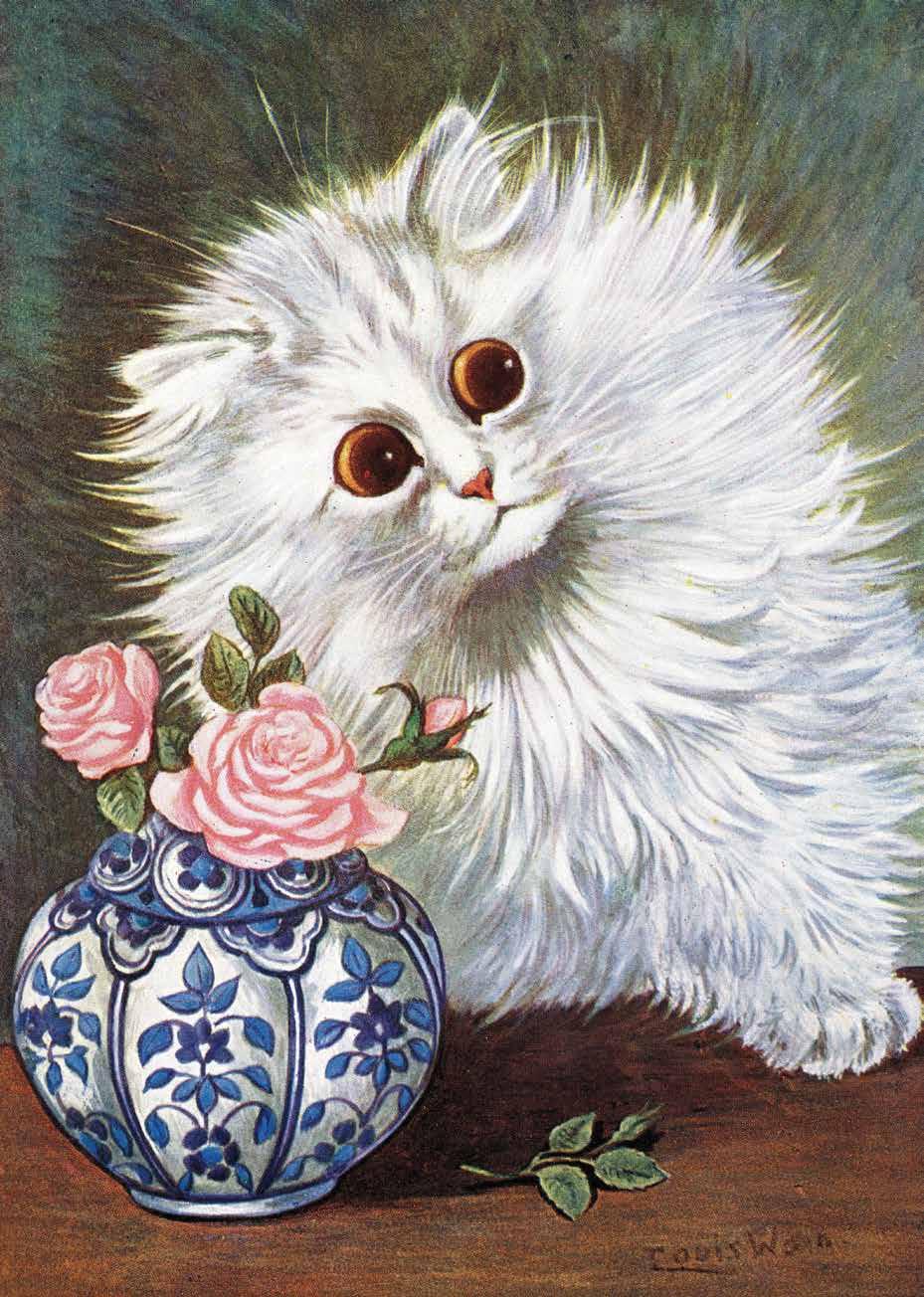
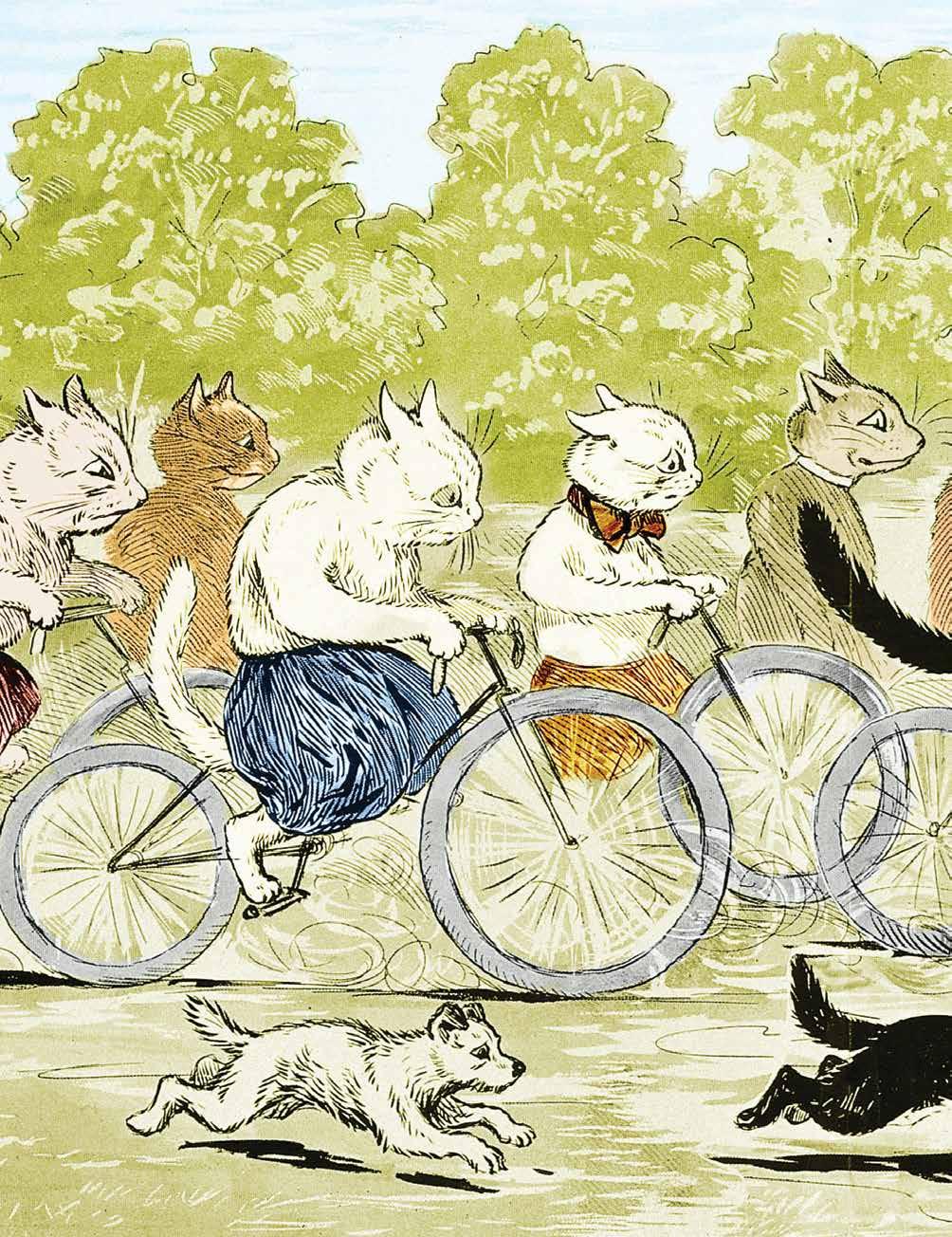
Cats in a Bicycle Race, Hyde Park, 1896.
l’édition sur les animaux de compagnie et la philanthropie • readelysian.com

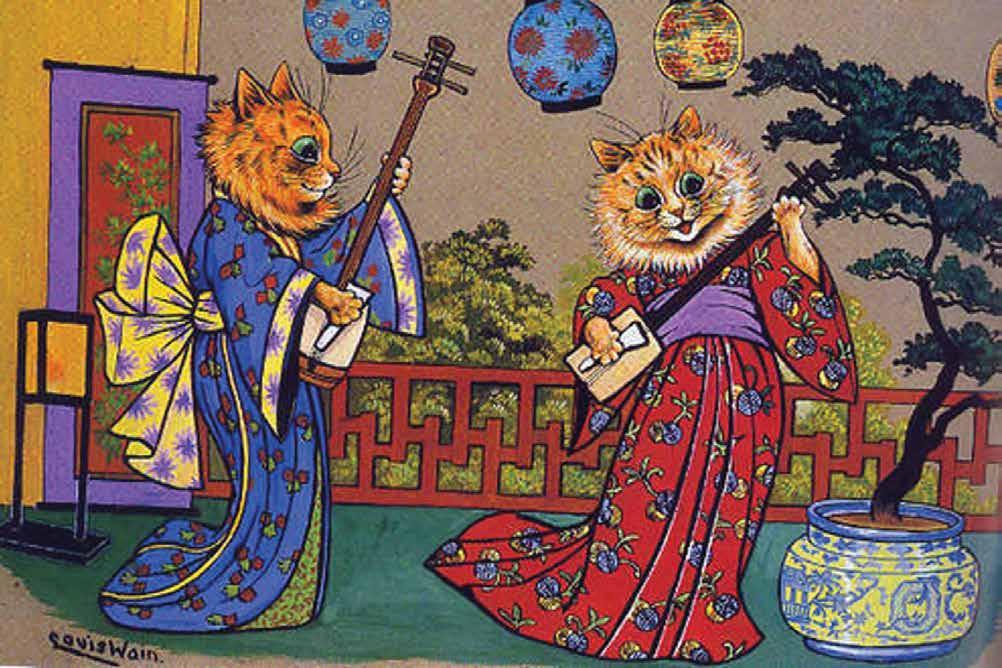
Legacy & Cultural Impact
Louis Wain’s impact on popular culture and art is enduring. His playful, anthropomorphic cats paved the way for modern animated characters and contributed to the acceptance of cats as household pets. His advocacy for animal welfare and his efforts to elevate the status of cats through his art had a lasting effect on British society. His illustrations were not just entertaining; they were a gentle critique of Victorian social norms, using humor and imagination to bridge the gap between humans and animals.
With their bold use of color and abstraction, Wain’s later works have attracted renewed attention in the 20th and 21st centuries. Art historians and modern audiences have revisited his works, recognizing them not only as a reflection of his psychological state but also as groundbreaking contributions to the world of abstract art. While Wain did not belong to any of the major avant-garde movements of his time, his innovative use of color and form has made him a key figure in art history.
In 2021, the film The Electrical Life of Louis Wain , starring Benedict Cumberbatch, brought Wain’s story to a new generation. The film highlighted his artistic achievements and personal struggles, shedding light on a man whose creative brilliance was often overshadowed by his mental health challenges. Today, Wain is celebrated for his whimsical illustrations of cats and as a symbol of resilience and creativity in the face of adversity.
Louis Wain’s life and work offer a poignant reminder of the transformative power of art. Through his groundbreaking illustrations, he redefined the role of animals in domestic life, elevating the humble cat to a beloved, cherished companion. At the same time, his personal struggles with mental illness and financial instability provide a striking counterpoint to his artistic success. Despite his hardships, Wain’s work continues to inspire and delight audiences today, a testament to the enduring power of creativity and the human spirit. His art remains a symbol of joy, empathy, and the profound connection between humans and animals. ■
printemps 2025 • l’édition sur les animaux de compagnie et la philanthropie • readelysian.com • Untitled and Opposite: Electric Blue Cat With Yellow Eyes—Purr-fect by Louis Wain. Wain’s work was a reflection of his eccentricities, varrying from classic, to anthropomorphic illustrative and stretching the creative boundaries into borderline psychedelic. Wain was seen as a leading authority on cats, becoming president and chairman of the National Cat Club and serving as a judge in cat shows. He was also in demand by the growing number of organisations devoted to animal welfare.
BY

printemps 2025 • l’édition sur les animaux de
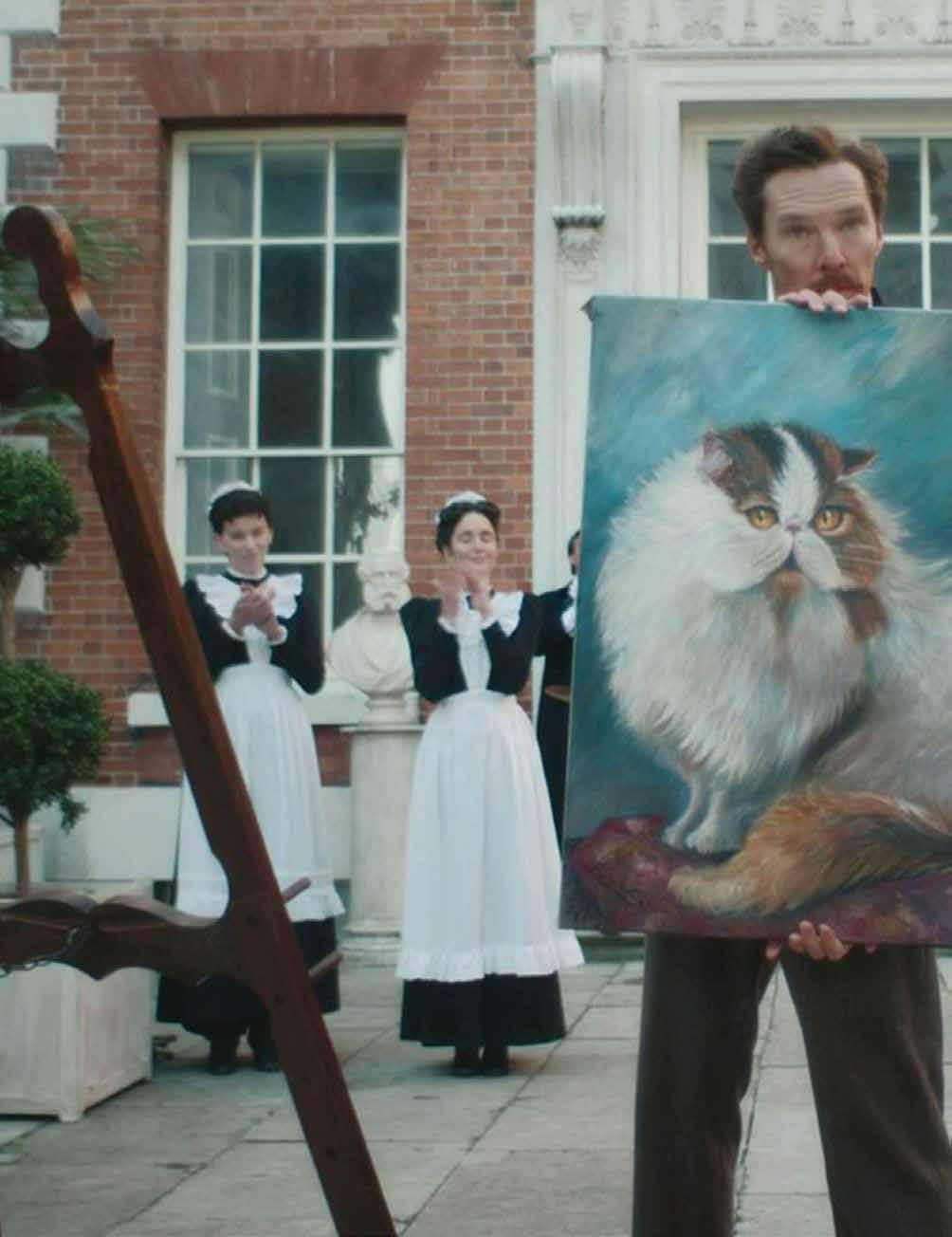
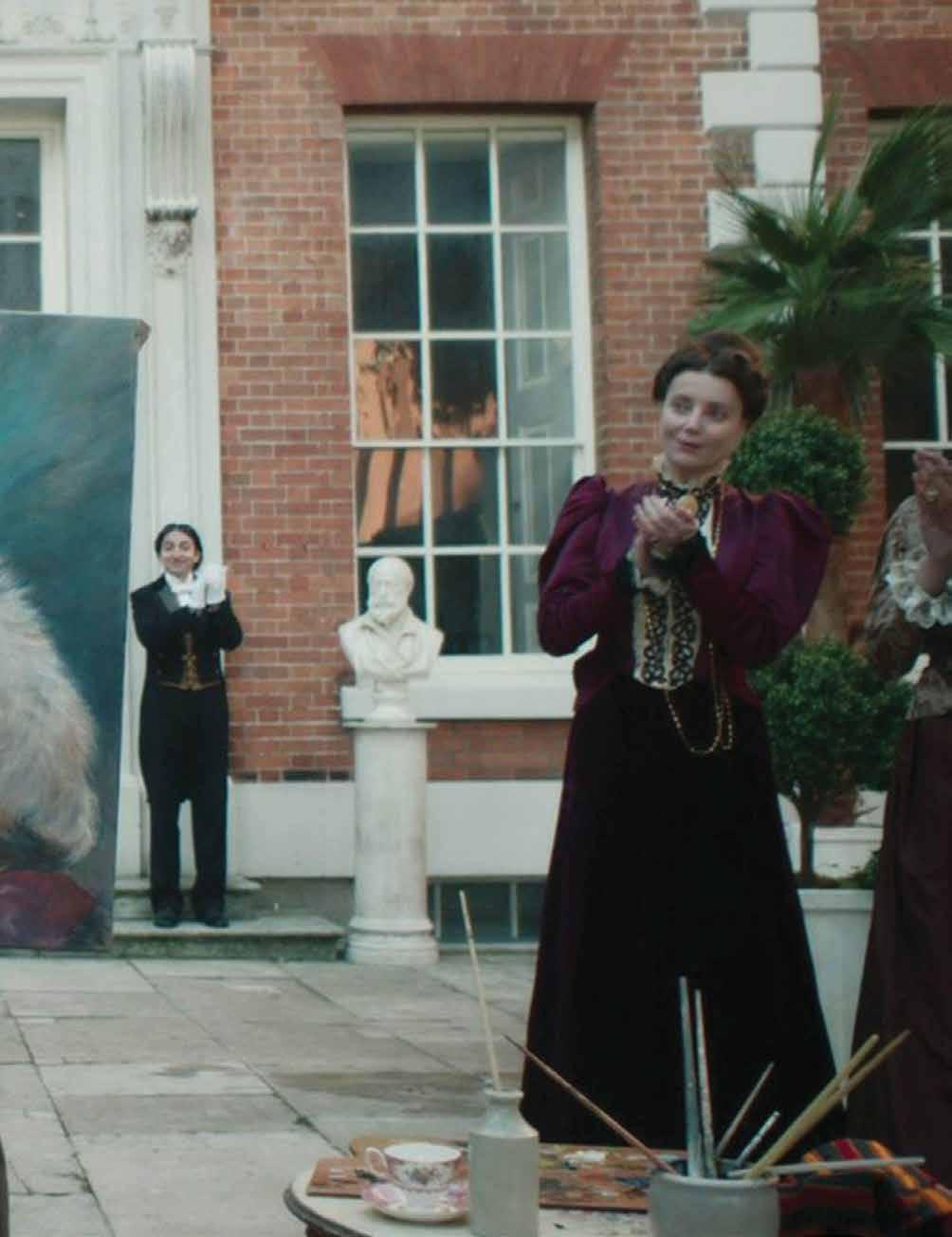
THE WOMEN WHO INSPIRE US
INTERVIEWS
BY KAREN FLOYD





Women Inspiring Women . . .
ELYSIAN was the result of Karen Floyd’s personal quest to tell and listen to stories about exceptional women. From her early twenties as a young prosecutor . . . to the women she has interviewed over the past eight years as ELYSIAN’s publisher and editor, Floyd shares insights that are intended to encourage and move our readers.
On the surface, Floyd’s interviews are about women succeeding, overcoming, persevering, and enduring. As the number of years and interviews have grown, Floyd no longer asks, “Is it timing, virtue, luck, funding, perseverance, faith, endurance or passion?”
Instead, she concludes, “While there is no one roadmap to achievement, these remarkable women have similar attributes. At some point, each woman ‘went against the grain’ and as a result they share qualities like courage, passion, steadfast persistence, hard work, un-deterring focus, strong loyalty, self-awareness, and independence. Though some led . . . others built, created, and changed the world. Their interviews reveal a sense of self and a belief in something greater, many call faith.”
With the thousands of interviews, Floyd emphasizes, “Their journey was often lonely, but their hardships created inner strength, enlightenment, and ultimately an intention to uplift others.”
It is that purposeful determination that Floyd mirrors in the women she interviews as she shares their inspiring stories.
* Copy edited for length and clarity.
* Interview videos are available to watch at elysianwomen.com
Interview Date: December 18th, 2024
kelly
KELLY CASTELLANI, the Director of Philanthropy for Silent Tears, is a philanthropist and advocate for women and children in South Carolina. She is systematically addressing the pervasive and complex issues associated with domestic abuse and sexual assault. The Castellani family has donated over twenty million dollars to the thirty-four facilities represented by SCCADVASA, South Carolina Coalition Against Domestic Violence and Sexual Assault, and SCNCAC, South Carolina Network of Children’s Advocacy Centers.
Kelly shares her personal domestic violence survival story by collaborating with individuals and organizations to give hope and a face to so many victims and survivors of interpersonal violence. Kelly’s work spans from increasing housing, furnishing automobiles, assisting in renovations, developing programs, and supplying financial aid for legal fees and personal assistance for survivors. She has also been involved with Miracle Hill, SASSGO, and Generations Home.
Kelly’s background and degree in finance, as well as a Clemson MBA, have been vital in her understanding of allocating funds most efficiently across state facilities and organizations.
When not working, Kelly enjoys her family time. She is active in fitness and health-related learning. Kelly is a certified health coach through the Institute for Integrative Nutrition.
printemps 2025 • l’édition sur les animaux de compagnie et la philanthropie •

Of all the homes I have visited in the Southeast, your home is one of my favorites. The renovations are stunning. What is your process for deciding design updates and renovations?
The structure of this home is fabulous and has so much character. It was my husband’s brainchild. I stripped away what I was not fond of and started with the bones of the house, which had a European feel but was not snooty. I wanted our home to be comfortable, so I looked at the places that we enjoyed and spent the most time. I tried to make them as relaxing as possible. I think it is very important for a home to be livable but also beautiful.
Growing up, there were periods when my mom enjoyed the “fancier things” like using our fine china. But there were also times in my life when we had nothing.
I think when you have beautiful things, whatever is “beautiful” to you, that is what you should enjoy . . . art, fabric, texture . . . how something looks and feels. Everyone has a distinct perspective on what they love. You should go with what makes you feel good inside, what you think is inviting to others.
When we started the decoration process, I started with one piece of art. It grew from there and went a little bit crazy. I wanted our home to reflect love and beauty and then incorporate all the things in South Carolina that I believe are represented in the people here. It is eclectic but not quirky, if that makes sense. There are three exceptional design elements that you were drawn to: texture, color, and art. Talk to me about your choice of textures.
I do love textures that are soft, plush, and comfortable. My aunt is a decorator and when she finds interesting fabrics, she will show me. I love all types of texture, from nubbiness to coarseness. Over time, I came to understand what I loved. My mom was also an interior designer, so I grew up looking at fabrics, the way different fabrics can complement each other but not match. Fabric is much like people, mixing and matching. The textures of fabrics are to interior design, what the bones are to the house.
I love the muted color palate in this home.
Originally, this house was “huntsy,” very Ralph Lauren, masculine and horse-like. Which I think is great. But for me, I am a little more feminine. I tried to mix up the feeling with the textures. I think there is something to a fluffy blanket and sofa . . . with pillows having different characteristics. A lot of people shy away from “mixing it up.” I think you should follow what brings you joy, not what you think “a look” is supposed to be.
Let me tell you a story about these fabrics, which tickles me. So, my aunt found the fabric for those pillows over there (points) from France. We sprinkled the fabric throughout this room and then used it for a couple of balloon shades. It was where we started, with all the light blues and the green hues. The colors are very natural, but there is also a fanciness to it with the little animals. We try to find items that will stand the test of time but are also different and unique. I am not drawn to what is trending. If someone said, “This is so popular, we sold a hundred of these,” I stay away because I don’t want what everyone has. I also like a “mix.” There are fabrics that my aunt cherishes that can sit alongside something from Havertys. The result is unexpected, which I think is fun.
What makes your house so unique is that the specific style represents you. It is a style I have never seen before, but it works. Your home was redesigned with artwork. Why?
A new friend of mine is an art curator. Before I knew her, I thought of art as something on the wall, not so much as a living creation, like I do now. In the beginning, we met with artists, and I heard their stories, why they painted, how they put themselves through school, why they used certain methods . . .
Then, they would show me the phases of their life born out in their work. For instance, someone would go through a divorce and their paintings would get dark. Eventually, the artwork
would change as they went to a happier spot. From their stories, personalities, and struggles, I started collecting their artwork. A couple of people passed, and I have their artwork. I talked to their children and other family members . . . I heard stories about their families and their love stories. It was interesting to me how they poured their hearts out on these canvases… then they sold the art and never saw it again.
A lot of earlier art I collected was “couple art,” a boy and a girl, or “his and her,” stories about a couple in love. We noticed the themes were always romantic, and I think it was because the art I chose represented my life. I was, and I still am, in love. You weave a lot of what you are going through into your decor. Their love will always speak to me. I see the faces of the artists when I am home and remember their stories.
I started with one piece of art, but today, we have 250 pieces from 90 artists. We held an event for artists whose work we acquired to facilitate connections with their mentors, other artists, and friends.
There are pictures of Leo Twigs downstairs. He is 92 and lives with his wife in Orangeburg. He innovated a style of painting based on the batik process. And so, when artists see his work, they comment, “‘Wow, we studied him.” It is a great way to honor the talent in South Carolina, which I do not think receives its due recognition. I enjoy standing there looking at the pieces and hope that anyone who comes to our home feels the same. It is just a neat way to give back.
There are two themes that I want to explore. The first is your mother, who was a designer. You told me once that I reminded you of your mom.
You remind me a lot of my mother when she was young. She was blonde, blue-eyed, beautiful, fair-skinned, just a very elegant woman. She was a decorator, but before that, she tried to go to medical school and became a nurse. She went to Furman and received an art degree. She became an interior designer, so I grew up with architects and design materials everywhere. My mom loved life. But her life was not so great all the time. She died a couple of years ago after she developed a mental illness which she battled for a long time.
She never lost her sense of spunkiness and funniness, even when she did not have any money. She was homeless and lived in the weekly hotels for years. I would pick her up sometimes, and she would be fascinated by some “find” she received from Goodwill. She never lost her sense of beauty and enjoyment, no matter the situation. Collecting art is a homage to my mother.
I have had a hard life, and really bad things have happened to me. But through it all, I also found beauty in something to help pull me through. Where I am today is a much better place than my mother. She would have loved it here. I think she would have loved the fabrics, textures, and artwork. And I can hear her voice laughing at how beautiful everything is, which makes me happy. It is really hard because I have gotten everything she didn’t get, but she would love it.
My mom was the only one who loved me unconditionally. She did not abuse, mistreat, or abandon me; she just loved me.
Do you think that people who have mental health issues do so because they give unconditional love and they cannot understand the evil of humanity?
I think so. My mom was extremely smart and thought she could outwit, figure things out . . . and outcraft the situation. I think she suffered traumatic childhood damage that she chased her entire life. Some people have chemical imbalances, but I think mental illness can be self-exacerbated if a person does not deal with the demons within.
Kelly with Jill Alper picking out frames for two works of art by talented painter Talon Grace.

I think she is here with you, Kelly, and she knows where you are. I think she reached her peace through you.
She called me Kelly Belly and was always saying, “Kelly Belly, you just outshine them.” She always said that.
I have tried to read the little snippets she wrote, but I cannot understand them or decipher her handwriting. The little bit that I can read is scratching in the Bible. I saw that she would not leave the house because she was waiting for a call from an attorney to sue my dad. I mean, it was always something to do with my dad.
I had conversations with my mom before she died. I think she was happy and seemed grateful. She did have a stint of life that was beautiful. And then she just went off a cliff.
Would you say the last 10 to 15 years of her life were really difficult?
Probably the last 30 years. She had a hard life. She met a man who was abusive, and bad things happened. I wrote down everything that floated in my head so that I could remember my mother. I remember the way her hands looked when she rotated her ring, her laugh, wearing curlers in the car, and then spraying her hair as we choked in the backseat. I remember her telling me she was a race car driver. I have so many memories, so much laughter. I know she also had a lot of pain; she thought I would carry her life forward. Her joy was going to be through me, and she was fine with that.
You were her “everything,” weren’t you? What a huge, huge burden. I had to cut her off for six years, and that was extremely painful. I was forced to choose between my children and my mother at that time. It was a lot. But she forgave me, I think she knew.
Of course, she knew. We all know.
She would have done it for me. But I think she is happy now and at peace. She was miserable.
You have abundant blessings juxtaposed with tremendous sorrow and pain. Is that why you are drawn to philanthropy and giving back?
Yes. I look at everybody as human beings. I do not look at appearance, money, or education. We are all human beings, and unfortunately, some are put in tragic situations. I am the same human being today, living in a massive house, as I was when my mom had no money and we heated the house with the oven.
The same holds true for people in politics and celebrities. They are just human beings “in positions.” They are no better than you or I.
For twenty years, I was in a very heavy stage of life, with a lot of loneliness. You can be very alone but be amongst people. I was teaching Sunday school and talking about love while sheltering two kids in a painful world at home filled with darkness and depression. I tried to shoulder so much alone. It was before the internet, and there was no way to understand what was happening
to me because my mother brought me up ignoring abuse. She was such a happy-hearted, carefree spirit.
I didn’t understand the magnitude of evil. I thought if you just buckled down, you could love abusers and get through it. I always saw the best in people and kept praying, believing that love would win. It is not so because there is evil. There is injustice in the world that will bring you to your knees. There are people who will destroy the young and vulnerable; they have no limit. I did not understand that, and I still don’t know if I had to go through that journey to understand the evils of the world fully. I do now. I felt very alone for a long time. I had a mother who was mentally ill and a father who I did not want to burden.
YOU HAVE ABUNDANT BLESSINGS JUXTAPOSED WITH TREMENDOUS SORROW AND PAIN. IS THAT WHY YOU ARE DRAWN TO PHILANTHROPY AND GIVING BACK?
Publisher
ELYSIAN
interviews ELYSIAN “Inspiring Woman” Kelly Castellani at her home in Simpsonville, South Carolina.
. Q.

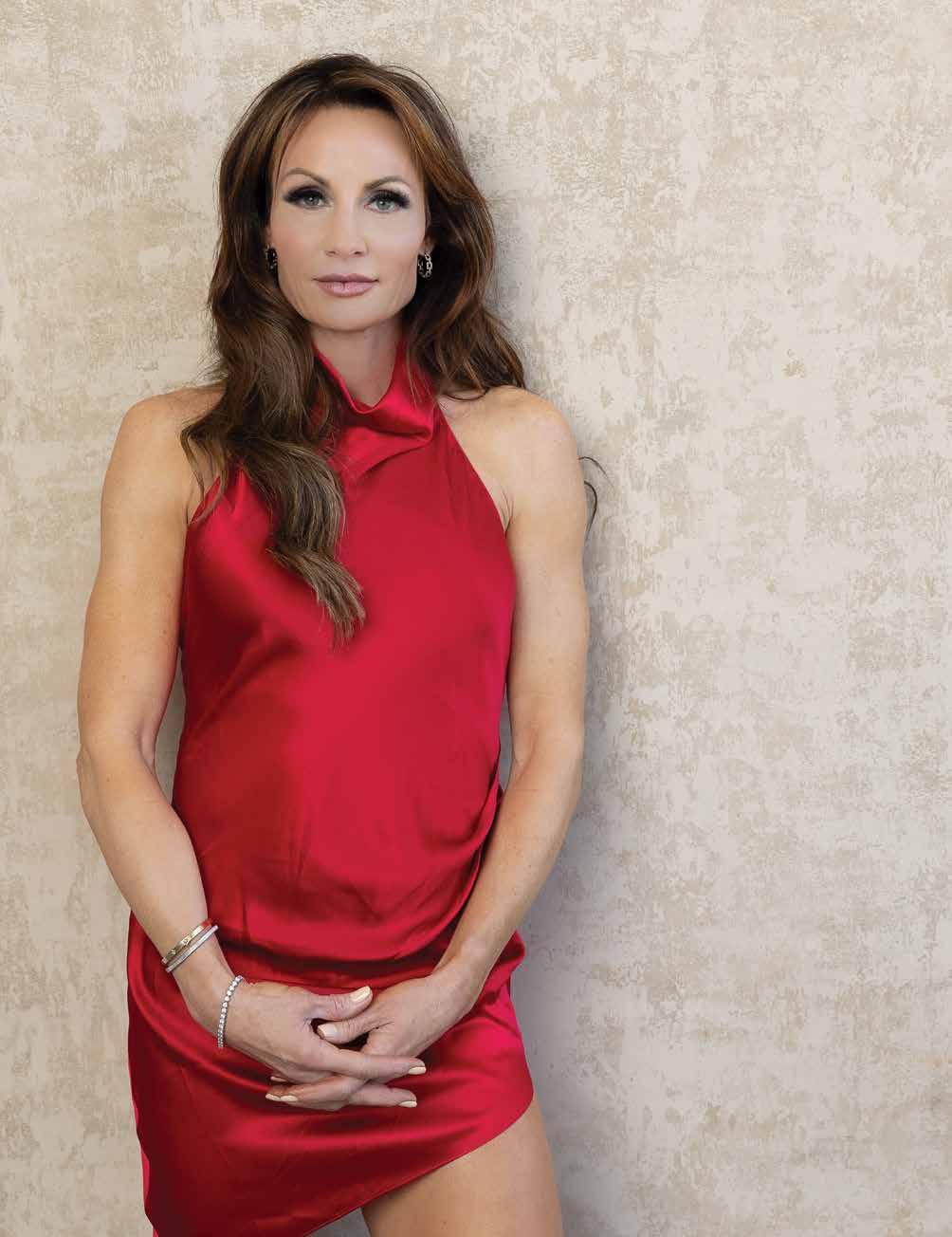

YES. I LOOK AT EVERYBODY AS HUMAN BEINGS. I DO NOT LOOK AT APPEARANCE, MONEY, OR EDUCATION. WE ARE ALL HUMAN BEINGS, AND UNFORTUNATELY, SOME ARE PUT IN TRAGIC SITUATIONS. I AM THE SAME HUMAN BEING TODAY, LIVING IN A MASSIVE HOUSE, AS I WAS WHEN MY MOM HAD NO MONEY AND WE HEATED THE HOUSE WITH THE OVEN.
My husband isolated me from every person that I had ever known. When I made new friends, I did not want to share what I was going through, so I shouldered it all. I had two young boys, and I tried to make a fantasy world for them because I did not want them to know what I was enduring. Eventually, physical abuse takes its toll. I think a lot of my physical problems are from decades of shouldering everything.
But during that time, I met lovely people who tried to help. I carried a fear of being “found out.” I read a lot. I learned a lot. I gravitated to those I could share a little bit of what I was going through at a time and then moved on. But God weaves people into our lives to keep us going, so it was bearable. But my life was nothing you want to live, either. What sustained me were my prayer journals and biblically based movies.
And so, it is particularly important for me to let women know that they are not alone; they are seen and that they have value. What is Silent Tears?
When Bob asked me to help with Silent Tears, I had just ended an abusive relationship. I was beginning to learn about the severity of trauma and how the whole system works with women and children who are abused in South Carolina. I traveled to every domestic violence and children’s shelter in our state. There are thirty-two individual organizations represented. I tried to learn about the gaps in the system. This happened right before Covid. These organizations serve women and children who have experienced domestic violence, neglect, and abuse.
Yes, and sexual assault. When I met people in the system and told them my story, it resonated because I was part of their network;
I had sought help from Safe Harbor. I am just in a different stage of life, the same human being, just in a different scenario. It was interesting because, through my story, they found hope.
Because they saw that you were able to . . .
Get through. I think people who are in that hole, in that darkness, need hope and light, something to motivate them to take the next step, to get out of bed. There is so much darkness when you feel there is no hope. I want to give people hope. I did not think I would ever meet a human being again after my marriage. I thought men were going to be nasty, old, and gross, and I would be single and lonely for the rest of my life. I had resigned to that . . . so to find the love of my life was completely unexpected.
I want to show victims that they can start over, go back to school, get a new job, and find a new home. People will love you and treat you with respect because everyone deserves that.
The philanthropy part is simple: I am so unbelievably grateful for where I am in life. To know the unconditional love that Bob gives me, I did not think it existed other than from my mother. To know that there are people who love and give without wanting anything in return was something I had not experienced before.
What are the biggest impediments or the biggest challenges the state faces?
Our state laws were set up by men, for men. I am not bashing men because I think men are great… but our state laws need to change. The role of women is different now, and our laws need updating. We are the only state in the nation where a woman cannot get a Temporary Order of Protection.
What does that mean exactly?
Say you and I are married, and we are getting a divorce. I can

get a Restraining Order for stalking, but that is not an Order of Protection, which sets the “ground rules” for women to survive, like money, access to assets, picking up children, etc. It sets parameters. But in South Carolina, you cannot get a Temporary Order of Protection until you have a hearing.
Therefore, all the mechanics needed to have an actual separation cannot happen in South Carolina unless you go through a judicial proceeding. And this is a lengthy period.
Yes, so the time lag allows people to play with checking accounts, children’s custody is undefined, and assets like cars can be bugged because they are marital property. The list is unending.
The laws need to get serious about protecting women and children (sometimes the men) during the one-year of separation. As it stands currently, women are often isolated, threatened, and harassed, and there is nothing a woman can do until the Order of Protection is awarded.
Silent Tears has given more than 13 million dollars to programs countering violence against women and children. Where did that money go?
A large part of our donations went to building the Center for Safe Harbor, a space to give dignity to the residents. We also traveled to thirty-two individual centers statewide, and though we are progressing as a state, we are not where we need to be. I think the state needs to take ownership of underserved centers, particularly those along the Corridor of Shame and/or where people are uneducated and geographically isolated, and where travel is almost impossible without a car.
To level the playing fields throughout the state has been a big part of what we try to do. We have shifted our focus from boots on the ground to literally changing the laws. I personally try to bring hope and dignity to this world, because people who endure these things are just as important as people who do not.
I called you one day to invite Silent Tears to participate in CatWalk FurBaby. Do you remember what I said?
Do you want to do a fashion show in New York to raise awareness for Silent Tears and compete for prize money with designers, models, and animals? It will be fun; it will be easy. It was incredibly fun, and it was fast.
It was really fast.
It was something so different and so nice to see . . . not just South Carolina participating, but the world giving to charities worldwide. There is something infectious about giving back and helping other people. I think it excites people to see what they can do with their talents while simultaneously giving back.
You had Silent Tears, the charity . . .but how did you decide on a theme, model, and designer?
The year before, you had talked to me about CatWalk FurBaby, and I thought that it was a big deal, but it was so far out of reach for me that I did not pay much attention to it. A friend of mine from Greenville, South Carolina, has a daughter who models. She sent me a video talking about a designer that she had in New York. So, when you mentioned CatWalk FurBaby, I knew both a girl who could model, and a designer.
Tell me about the model.
Cali Vu is 21 years old, spunky, beautiful, and very elegant. She said she would love to help raise awareness and money for Silent Tears. In everything I do, I try to see how many people I can incorporate into the project who would enjoy it, too.
Tell me about Cali’s family.
Cali’s mom does my nails. She is very fun, and I love her to death. She has three children. Cali is very mature because she
worked alongside her mother through high school. She was very appreciative, with a “big dreamer” mentality.
What does she want to do?
I think she would love to be a model.
Who was the designer?
The designer was Alex Foxworth, who also has Southern roots. She knew where I lived, and she knew Cali. All the pieces fit together. She was delighted to design for CatWalk FurBaby, which shocked me. I showed her concepts, and we collaborated back and forth.
What was your theme for your charity, Silent Tears, and why did you select it?
I wanted the theme to be about the power of women. I also wanted it to represent strength, beauty, and grace. When I spoke with Alex, I asked her to create for a strong woman, but I also wanted the design to have sensuality and beauty. I think women can be sensual and still be strong. We tried to incorporate the ethos of Silent Tears: the quietness and the loneliness of pain juxtaposed with beauty, strength, and sensuality. She did a fabulous job. But our dog refused to wear the hat that matched the outfit. I think that is why we did not place; we lost because of the dog.
How did you tie Silent Tears into animal welfare?
A mother is the central figure in the family unit. With domestic violence, those who are raised in that environment are affected. So, human abuse trickles down into animal abuse. People who grow up in abusive homes can easily become abusive adults who abuse other people and animals. As a result, I focus on mothers and children in abusive situations because that is the most rudimentary way to protect and stop the generational curses. It is so important that we are realistic about the cycle of abuse, we acknowledge it, and then we face it head-on with all our resources.
Where does change start?
South Carolina can be a leader instead of ranking in the top five worst states in the nation for domestic violence. We must change the mindsets of our state. So, we need to change South Carolina’s laws to make victims’ paths brighter. It is an expensive and arduous process for victims, with therapy, lawyers, and relocation (to name a few). And our state’s legal system does not make it easy for them either when thought leaders have the capacity to move the needle with simple legislative changes. When I talk to people about our antiquated laws, they ask, “Now why would we do that?” I respond, “Maybe those laws worked 200 years ago or a hundred years ago, but they do not work now.”
Is there hope for change in South Carolina?
I am very hopeful because of what I have witnessed first-hand. I cannot tell you how life literally “comes back” to abused women who are out of the cycle. They often dedicate themselves to “giving back.” A couple of girls who are survivors of domestic violence are in school today to become occupational therapists so that they can go into the school system and help children who are in abusive situations. They want to be the school resource for a child of abuse.
I have watched traumatized women, hardened by their experiences, become un-hard. I have seen people who want to give up and get the help they need for a year or two, and come back to me and say, “I cannot believe I did not know that life could be this good.”
I want people to have hope, because if you do not have hope, you really do not have anything. So, for me, Silent Tears is being a friend in the silence, the person next to a victim saying, “You can do this, and I will help you.” ■
Kelly with Jill Alper and artwork by Rey Alfonso.

Interview Date: December 14th, 2024
Kimberly
DR. KIMBERLY WORD has a PhD in Clinical Psychology. As a private practice clinician, she provided individual, couples, and family therapy while serving as a superior court forensic expert and a prison system consultant. Her work spanned cognitive evaluations, therapeutic guidance, and justice system advocacy.
Drawn to the deeper nature of human existence, Dr. Word has spent years studying quantum physics, brain behavior, and relationship dynamics. Her unique ability to bridge science with spirituality is the foundation of her newest business venture, emphasizing empowerment, upliftment, and divine alignment.
Dr. Word enjoys a blissful soulmate relationship with her husband, who wholeheartedly supports her mission. Beyond her professional pursuits, Dr. Word advocates for animal welfare. Her charitable spirit shines through her active involvement in numerous philanthropic organizations within her community, where she was honored with a nomination for the Leukemia Society’s Woman of the Year in recognition of her outstanding fundraising efforts.
As a thought leader and trailblazer, Dr. Word’s goal is to inspire the world to recognize the God force within and to create lasting change through conscious alignment. Her life’s work is a testament to the transformative power of love, spiritual clarity, and the unwavering belief in the divine potential of every soul.
• printemps 2025 • l’édition sur les animaux de compagnie et la philanthropie

Your home is beautiful. How many years have you been under construction in your renovations?
Remodeling has been going on for four and a half years straight and will continue until its completion. I wish I had an end date, but I don’t because it is a labor of love. The house is the brainchild of Michael Smith, who is reputed as one of the top interior designers in the world. It honestly is his masterpiece, and we are very privileged and very grateful to be the recipient of his expertise. My husband and I travel extensively, so whenever we come home, we walk into this house and feel unbelievably grateful, humbled, and thrilled that we live here and this is our home. It is truly incredible.
Michael Smith is known for implementing the visions of his clients. Which means simply that your home represents your dream. Thank you. I would love to believe so. I know that we love our home, but I do credit him with design and aesthetics, though we did provide our input. We love traditional European antiques with history . . . I love wondering who owned this piece and what life was like for the owner. We blend antiques with beautiful contemporary art, an eclectic mix. This has been an extraordinary journey. We entertained throughout the entire remodel—in the midst of complete construction and chaos. We are good with that because we love entertaining, and people have witnessed the transformation. On the other hand, I can’t wait for it
to be done because it is exhausting. Our son jokes that it is like living in a hotel under constant construction.
You have helped others navigate and find a constructive way through their pain points with chaos. Can you explain that process?
Chaos is an inherent part of life. There is no escape from chaos. But how you handle chaos is within your control. Blissfully Living focuses on empowering people to understand how they can become resilient and strengthen what we like to call a “bliss muscle.” People tend to ignore mental fitness. They tend to focus on physical health in many ways, but not mental health. By strengthening your bliss muscle, you experience emotional resiliency and the ability to deal with chaos and respond to it, while simultaneously finding a place of feeling calm and centered more quickly. It is okay to be human, to freak out, and to melt down, and all those emotional outpourings. The bliss muscle allows you to quickly recover and get back to a state of ease, tranquility, and calm that you can achieve after stress, after a chaotic moment.
You are touted as an expert in the mental wellness space. Your practice evolved over years and years of education and clinical practice. I want our readers to understand the breadth of your background, so can you share your education track?
I am a clinical psychologist and became one because my passion is helping people. I am a natural uplifter and way-shower. I love helping people, which is why I pursued
ELYSIAN Publisher Karen interviews “Inspiring Woman” Dr. Kimberly Word at her beautiful home in Newport Beach, California. PHOTOGRAPH

a PhD in clinical psychology. I completed a pre-doctoral internship in neuropsychology at UC Davis Medical Center, as well as a post doctoral fellowship in pain management. While my educational background is more science-based, I have practiced in a multitude of areas over the years, including individual therapy, couples therapy, and family therapy. I worked in a prison as a consultant and in the superior court as an expert in forensic psychology. Those professional experiences provided a fantastically fascinating exploration of the human mind. I later became very involved in spirituality. So now I meld the two—my scientific background with spirituality.
How important is spirituality in mental calibration?
It’s incredibly important because spirituality helps ground you. It gives you a sense of greater purpose than just this immediate moment or incarnation. Spirituality is the ultimate anchoring force because it provides purpose to your life.
What is your purpose?
My purpose is to uplift and help others . . . to show people how they can find tremendous alignment, joy, satisfaction, and bliss in this life, right here, right now, in the present moment.
And how do they do that?
There are different techniques. We encourage people to savor their lives in ways they are not accustomed to. People tend to be very past-oriented. I learned through my practice
Qthat, for some, the utility of classically trained psychology can be limiting because it emphasizes childhood trauma and past traumas. People get very married to their past and adopt a victim’s identity, which is inherently problematic because they cannot move beyond their past.
Why?
Often, people feel validated by going through the traditional therapeutic process; however, in some cases, talking about past trauma can also inhibit the person from moving forward. They become locked in a “victim mentality,” and some never can change the thought habits that create positive thinking. They stay married to their past.
Almost a self-fulfilling prophecy.
Absolutely. The Law of Attraction keeps you focused and magnetized into your future. Energetically, you are attracted to what you focus on. So, if you focus on the previous trauma, you attract more of it into your future.
But it is also important to understand that the Law of Attraction is not solely magnetized into your future, but it teaches you to become more present-focused and “in the now.” Visualizing your future is just one technique that will help you to manifest your intentions—what you are seeking.
So, you are basically saying that people can propel themselves forward in life with positive thought habits?
Yes, absolutely, they can, with certain habits that they acquire by the practice of the Law of Attraction.
WHY
Karen Floyd Woman” beautiful California.
How do you realign the “inner talk track,” so to speak?
Neuroplasticity is a fancy term for the brain’s capacity to change. When people have bad thoughts or behavioral habits, they think negatively and anticipate negativity in the future, which in turn carves out neural pathways. Our focus is to help people shift their thinking in a more positive direction. So, they effectively carve out the neural pathways for positive thinking, optimism, and hope for the future.
I am reminded of the book The Secret. Have you ever read it?
Absolutely. I love The Secret and have read the book and watched the movie numerous times. The methodology behind The Secret is based largely on Abraham Hicks’ teachings, and the teachings are the foundation of my
work. To put it simply, I am a devoted follower of Abraham Hicks, who offers profound guidance on aligning with our higher selves, raising our vibration, and manifesting a life of joy, abundance, and purpose.
What is beautiful about the Law of Attraction is that you can become whatever you perceive for yourself. That is the net of it, right?
Yes, absolutely. I think we are all capable of good and of greatness.
Can a program that teaches people how to change their life trajectory and outcome with the right tools change the world?
Unequivocally, certainly, yes. Because collective energy has a transformative effect and influences the world. Scientific studies indicate meditation and prayer have helped to alleviate violence.
PHILANTHROPY HELPS ON SO MANY DIFFERENT LEVELS. GIVING BACK RAISES YOUR PERSONAL VIBRATION.
THE FEELING FROM GIVING IS SO DEEPLY SATISFYING . . . THE HUMAN RACE NEEDS TO GIVE TO ONE ANOTHER TO ENSURE THAT WE SURVIVE AS A SPECIES. WE DO NOT LIVE IN ISOLATION. WE NEED TO GIVE BACK, AND IT ENERGETICALLY CONTRIBUTES IN SUCH A BEAUTIFUL WAY TO THE ENERGETICS OF THE PLANET.
a.


PHOTOGRAPH
The Law of Attraction implies a disciplined mind?
Absolutely. An unmanaged mind can become a problem, yet we all have an unmanaged mind, which is okay because we are all human, and sometimes it is hard to manage our thoughts. We are caught up in a negative loop of thoughts and expectations. Through my teachings, I help people reverse that to work on developing their bliss muscles so that they can direct their thoughts in a more positive direction.
Tell me about the bliss muscle.
People tend to ignore mental fitness and focus on health, diet, nutrition, and physical exercise. Imagine a muscle that you would use, like a bicep. To make it stronger, you might do bicep curls, which is analogous to my program. If you want to strengthen your bliss muscle, which is your ability to call in a positive, tranquil, uplifted emotional state, you want to strengthen, cultivate, and repeat positive thinking and practice it regularly so you have a strong bliss muscle.
When you encounter the normal vicissitudes of life— we all have chaos, stress, disappointments, trauma—you’re more resilient emotionally, and you are able to recover that much quicker. Yes, it is okay to feel pain, grief, and sorrow and to lean into and process them so you are more resilient and able to recover more easily because your bliss muscles are stronger. Exercising your Bliss muscle strengthens neural pathways by consistently directing your focus toward joy and positive emotions, rewiring the brain for happiness and resilience.
How do you make sustainable, long-term positive changes?
You find a distraction that allows you to reconnect with your bliss muscle. My friends and I call one technique “lovies.” We gently, in a non-sexual way, softly touch someone’s hair or scratch their back with our nails. These simple techniques bring someone quickly into a Zen place. Put yourself into a solitary environment, anywhere alone, even in a pantry, just for three minutes. Sit, close your eyes, relax. Get on your phone and turn on a meditation playlist, a relaxation playlist, or a sound bath healing, or get out in nature and leave your environment. Take a fast walk down the street, admire a tree, look at the beautiful foliage or the patterns of the sky, or anything like that. Literally, those three minutes can recenter you. Changing your current environment can give you a mental shift that triggers your bliss muscle.
What role does anger play in the Law of Attraction?
Anger is a normal human emotion. To shift from a state of anger or frustration, you begin with slow shifts until you can get to a place of appreciation and gratitude for the things that are right in your life. It’s normal to have anger. But to change, first try to isolate the thought causing you to feel angry.
Are there gender differences in the Law of Attraction?
Sometimes, it becomes more difficult for women because we are socialized to put ourselves last.
Why do women do that?
Women are socialized to be nurturers and caretakers. We are taught to sacrifice our own needs. Unfortunately, we can become a boiling cauldron of resentment because our basic needs are unmet. As mothers, we give, give, and give. We are told that to be anything other than self-sacrificing is selfish, which creates toxic shame. Unprocessed and unexpressed anger can come out in passive-aggressive ways.
Can you forgive yourself for not being perfect but also strive
for excellence?
Yes, through your visualization process or bliss rituals, whatever methodology you employ and incorporate in your life, remember they don’t have to be that lengthy. Positive emotion is more powerful than negative. So even if you spend several hours a day worrying about something, if you can have 15 good minutes of positive, elated, happy emotions or of visualizing, you can create change. You really don’t even necessarily have to visualize; you can just recall something from your past that makes you extremely happy, like a nice memory, or even focus on whatever it is that brings you happiness. If you absolutely love trees, then go out in nature and sit with the trees, and you will become exulted and incredibly happy. This is extremely powerful energetically and can override the lowerfrequency emotions of anxiety and frustration. You just need those nice chunks, those doses of happy moments. It can be any thought . . . some future anticipated event that brings you anticipatory joy, excitement, and passion, or focusing on something in the present that you love, like a Christmas tree that you admire with its beautiful ornaments . . . focus on whatever it is that takes you into that elated place even if only for small chunks of time. That intense, happy emotional state can carry you a long distance, and it will override those frustrating, lower-level emotions that get in the way.
What is the first step to begin embarking on the Law of Attraction?
I would say the first step is to try to isolate and identify some of your negative thoughts because if you can challenge those thoughts and shift your emotional state into something more positive, you begin to head in the right direction.
How do you deal with negative relationships?
I have learned to set better boundaries. If I feel someone is not contributing energetically in a good way in my life, I will still love them, but from a distance. I will keep that influence in my life on a regular basis. So, I hold the space for them and keep them in a loving energy field that I can bestow upon them with my thoughts and vibration. I am definitely better about boundaries now.
Is that an age thing, being more boundary-centric to protect oneself so we can be healthier?
Boundary setting is a healthy and good thing, but I’m not sure if it is age-dependent with life experience or just something that is more part of our common culture right now. Having clear boundaries is healthy. You can still love someone from afar. You can still send them wonderful, positive energy, even if you’re not interacting with them regularly. Sometimes, you can have the best intentions, but life has to be their teacher, not you, so letting that go frees up extra energy to do activities with your kids or spouse.
Do you think your son understands the Law of Attraction?
He does understand it. It is interesting because by managing your anxiety, you envelop your children in calm and tranquility. I try to share my experiences in learned spiritual principles, but sometimes it’s challenging.
Do you believe in God?
Absolutely. Because we are all a God force, and I’m all a God force. There is a mistaken notion that spirituality and materialism need to be separate and that if you are truly spiritual, you disavow or repudiate any kind of nice material possessions. But that is not true because a God force is all divine. There is nothing unspiritual about beautiful things.
How do you maintain positive energy?
I have definitely cultivated a practice over time because I can be very, very, very frustrated. So, what I do is retreat mentally, even though I’m still physically present, and go to my tranquil place.
I teach clients that if someone is driving you crazy, you have to wrap yourself up in a little bubble of energetic protection. I have clients with “Bulldog” spouses, which puts them into very shaky places, vibrationally. I encourage them to retreat, get into their protective, energetic bubble, and imagine everything in their life that is working in their favor, to take attention away from what is upsetting them. I teach people to focus and to place attention on things that are uplifting. This practice centers them so they are able to remain calm in the midst of this storm.
Distraction with gratitude?
Yes, absolutely, and redirection.
It is a mental discipline.
It is. If you can’t find your vibrational footing, take a nap. Get out of a situation, retreat.
This is an obtuse question, but I’m curious: how much sleep do you need?
It depends on how vibrationally aligned I am because the better place I am in energetically, the less sleep I need. So, if I allow things to bother me, my energy goes down, and I require more sleep.
Shame: shame is a way of controlling. What is the anecdote for women feeling they must do certain things because of societally imposed shame?
There is an emotional scale, and shame is measured very low. It is one of the worst things. When you beat yourself up and shame yourself, it is a very damaging emotion. So, you need to get to the genesis of what it is you think you should feel ashamed about, and then you need to shift that thought in a positive direction.
We shame ourselves for things that are entirely inappropriate. We’re human. It is okay to make mistakes. You have to forgive yourself and move forward, not stay stuck in a shame cycle. When hurt, your energy is potentially damaging to those around you.
It is really important to try to make those energy shifts into more positive directions and change your energy so that you are providing beneficial exchanges with everyone in your world. Because when you are in a state of shame and self-loathing, you disservice everyone in your sphere.
Forgiveness is a big part of what you teach. How did you learn that forgiveness was such an important component of all this—self-forgiveness?
Self-forgiveness is critical because if you cannot forgive yourself, you really will not move forward emotionally. It is a cycle to continue coming back and reminding yourself that it’s okay to be human and okay to screw up. We are doing the best we can with the tools we have in that moment.
A lot of people blame their parents and live their lives with a victim script. I blamed my parents, and I really immersed myself in that for a period of time. Now I look back, and I think they did the best they could with the tools that they had. And God bless them because they tried their best and lost their way. I now know we all lose our way, and that is okay. Forgive yourself. Forgive them.
Forgiveness. Gratitude. Self-awareness. Talk to me about that.
I think self-awareness is critically important because you can shift if you can identify your internal dialog and what you say to yourself. When you pay close attention to your internal dialog and your internal critic, you can
really see how often you are being mean and unsupportive to yourself. You would never talk to a friend the way you talk to yourself.
And where does that come from?
It comes from early childhood, being shamed and told that we are not good enough.
Is self-talk something that, with time and mental discipline, you can overcome?
Yes, but you need to challenge and dispute the beliefs that result in you thinking you need to shame yourself or beat yourself up. Ask yourself, “Do I really deserve to be shamed? Did I really do something so heinous?” And even if you did, can you find it within yourself to forgive yourself because you did the best you could at that moment?”
Why are you so philanthropic?
I love giving back. My personality is exceptionally generous, and I have been that way my whole life. It stems from my mom, who was very generous too. I love giving back with no expectation of receiving anything in return. My favorite charities are animal rescues because they are innocent. Animals bring so much love and happiness to our lives.
Which is your favorite Animal Rescue and why?
While I give to different animal charities, the charity I have given the most to recently is the Humane Society of Imperial County. I prefer giving to charities located in impoverished areas because traditional fundraising can be more challenging.
The Humane Society of Imperial County is located on the border of Mexico in a disadvantaged area. The actual facility is in a dangerous neighborhood where people are struggling, so there are significant needs. The employees of the Humane Society of Imperial County have hearts of gold and often use their personal funds and volunteer their time to save these wonderful animals. I am drawn to grassroots charities, who are in the trenches and focused on helping animals. Those are the causes I want to support. I can make a huge difference, with a combination of Amazon or Costco shipments in conjunction with cash donations. I would rather give to charities that are passionate about animal welfare, struggling, and who are in real need. That is where my heart goes.
Tell me about the cosmic value of philanthropy.
Philanthropy helps on so many different levels. Giving back raises your personal vibration. The feeling from giving is so deeply satisfying. Giving a gift to someone who is appreciative is one of the most satisfying feelings that you can generate in yourself. When you give back, you are aligned with abundance.
Philanthropy is also important because, as a collective, the human race needs to give to one another to ensure that we survive as a species. We do not live in isolation. We need to give back, and it energetically contributes in such a beautiful way to the energetics of the planet.
When you have abundance consciousness, you know you will always be replenished. And the more you give, the more you receive back, which is not why we give. We give because it feels good. Because it is the right thing to do. Because we love helping other people. People who are greedy suffer from a scarcity-consciousness mindset, which is problematic.
You are more of a giver than a receiver?
Definitely. The state of divine receivership is very difficult, especially for many women. Receiving has been a real journey for me, personally. I am an expert at giving because it is so fulfilling. Love it, love it, love it.
And that is the Law of Attraction. Thank you Kimberly. ■
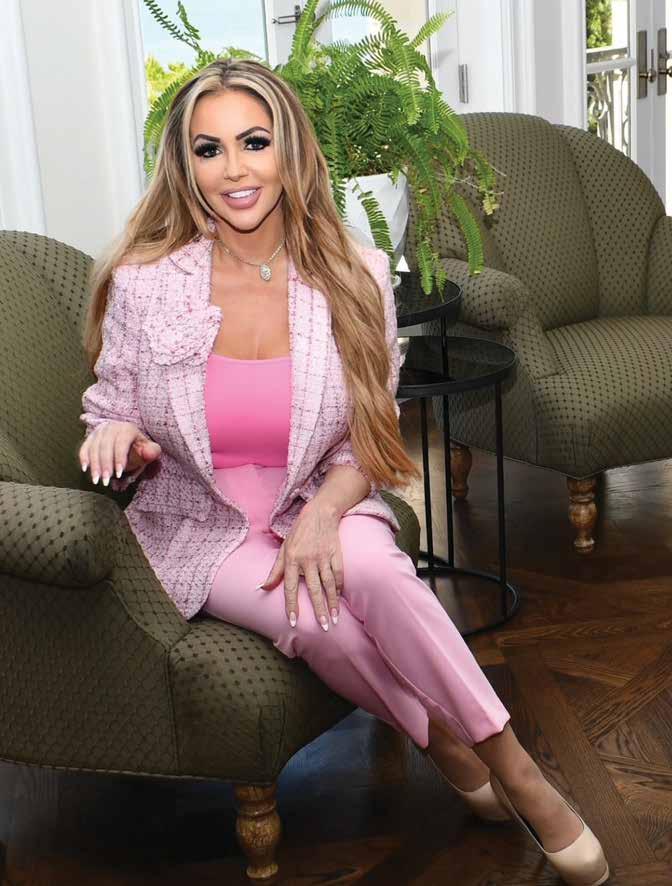


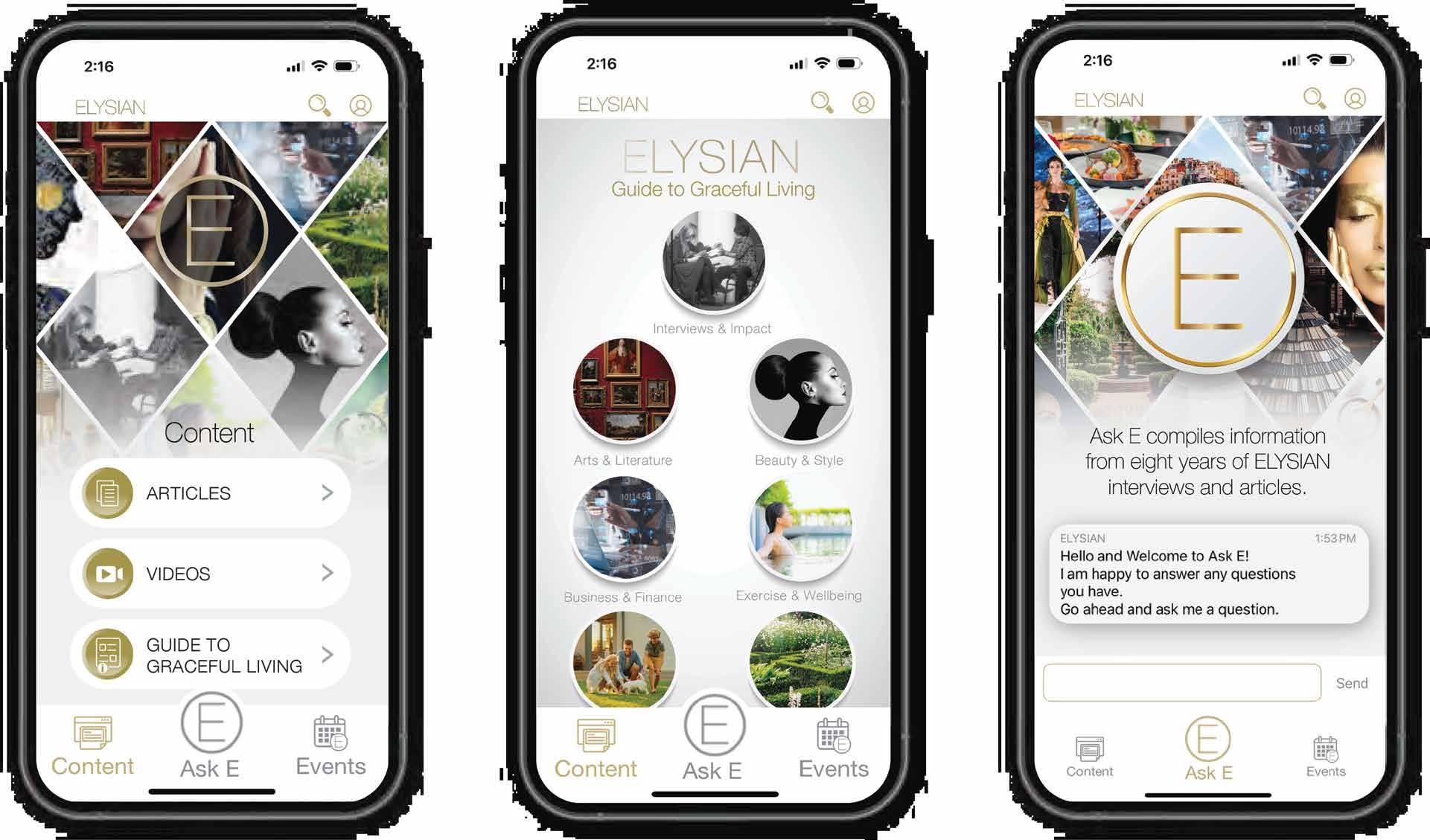
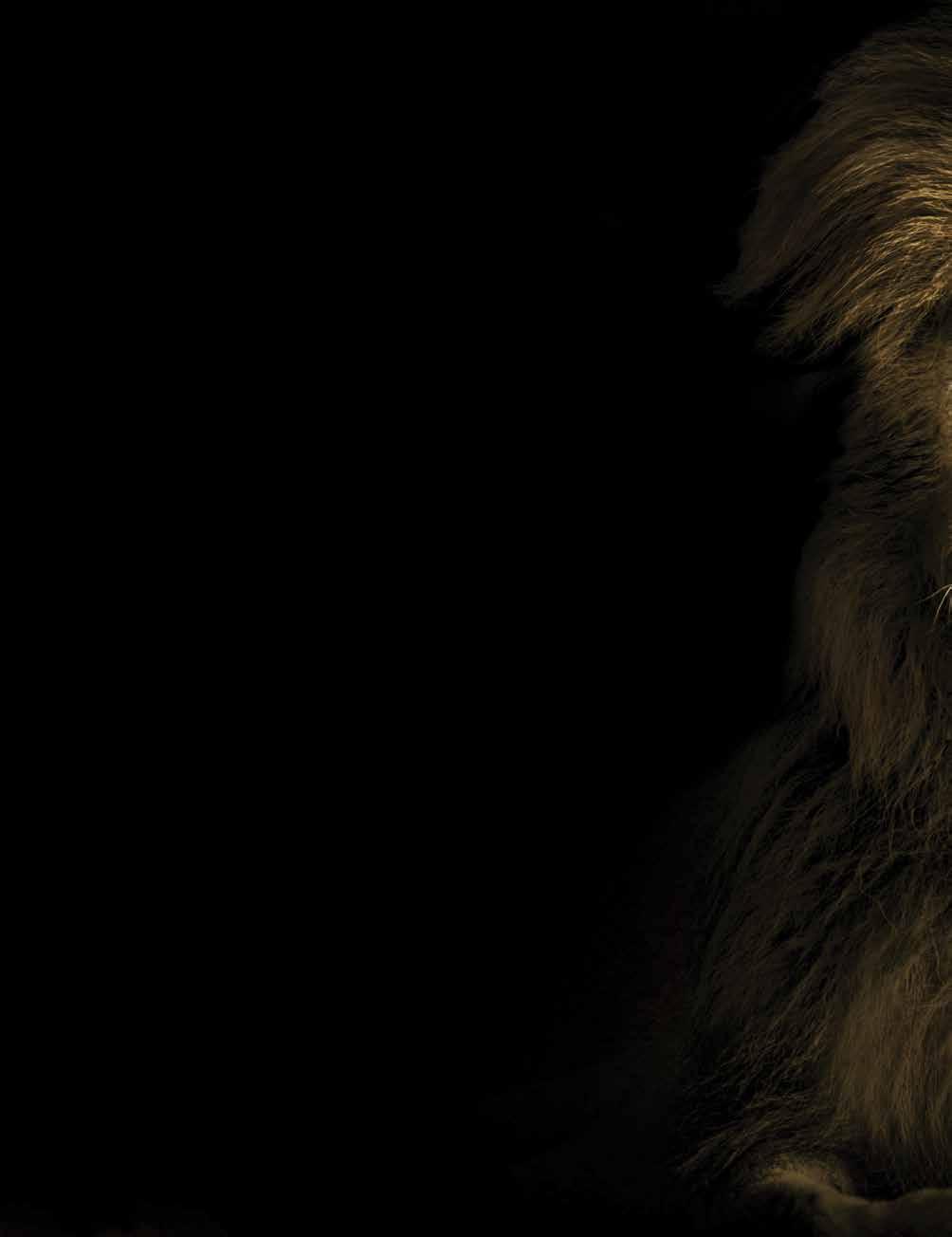
A Fearless Connection with Wildness
BY TOBY MAXWELL
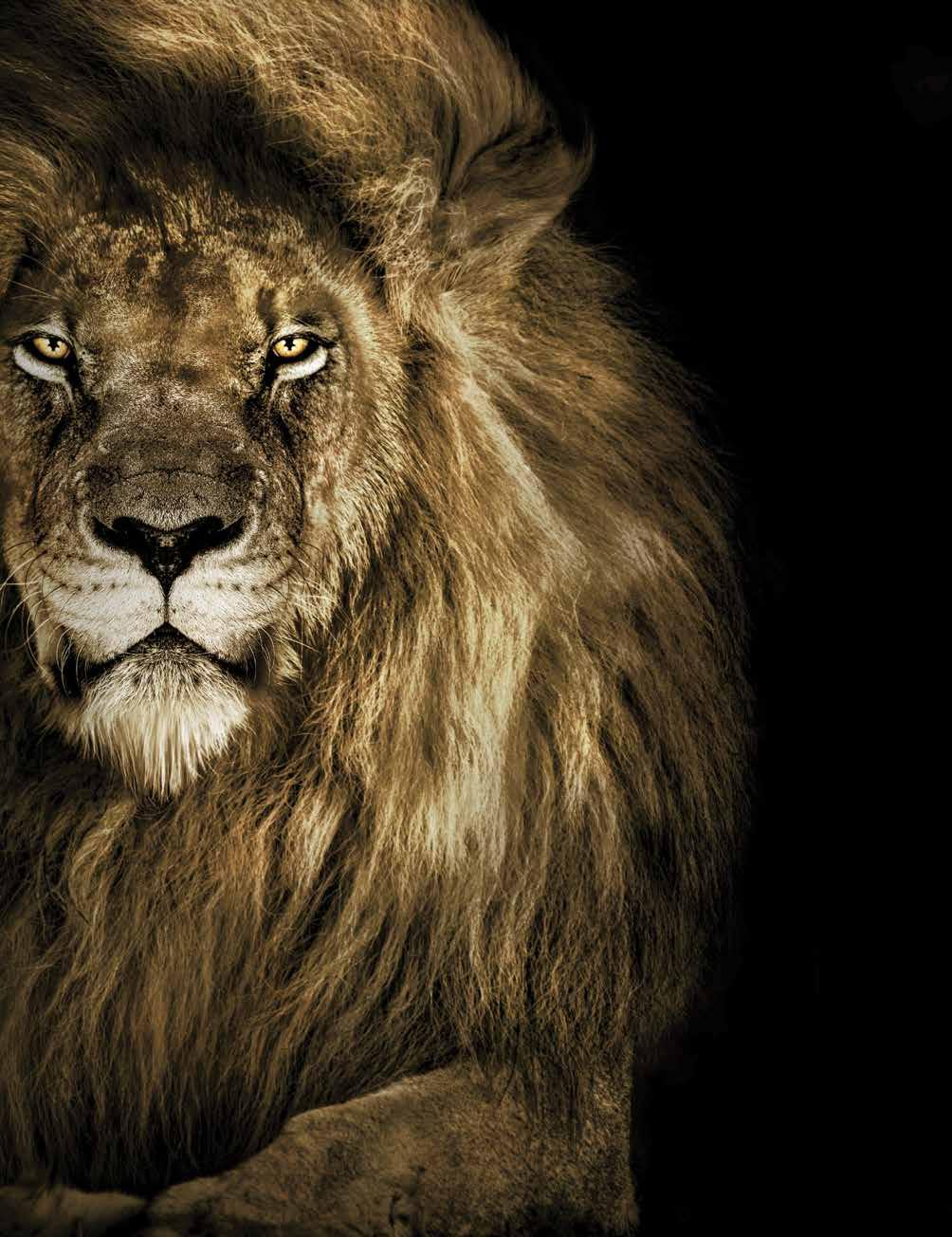
readelysian.com
Nathalie Kay “Tippi” Hedren, initially a fashion model, appearing on the front covers of Life and Glamour magazines (among others), she became an actress after being discovered by director Alfred Hitchcock while appearing on a television commercial in 1961. She would go on to appear in over fourteen major motion pictures, and her contributions to world cinema have been honored with Life Achievement awards in France at The Beauvais Film Festival Cinemalia 1994, and in Spain by The Fundacion Municipal De Cine in 1995. Today, Tippi Hedren, best known for her role in Alfred Hitchcock’s, The Birds, keeps herself busy running her animal reserve, Shambala, in Acton.
n actress synonymous with poise and sophistication, Tippi Hedren, first captured the public imagination as the star of Alfred Hitchcock’s 1963 thriller The Birds However, her life beyond the screen is a story of audacious love for big cats—a passion that drove her to navigate life-threatening situations, reshape public attitudes toward animal welfare, and establish a sanctuary for exotic creatures. In the 1970s, Hedren became a pioneer in conservation, dedicating herself to protecting lions, tigers, and other predators. Her extraordinary relationship with these wild animals is a testament to courage, compassion, and a life driven by purpose.
A Spark of Fascination
Hedren’s connection to wildlife began with admiration and evolved into advocacy. While working on Satan’s Harvest (1970) in Africa, she encountered big cats in their natural habitat, sparking a fascination that would later define her life. This experience, according to Britannica, marked her first meaningful exposure to the majesty and vulnerability of predators like lions and cheetahs. Later, in 1970, Hedren was approached by a film producer, Martin Brandt, about an ambitious project: Roar. The film would depict a family’s life alongside big cats, aiming to celebrate their beauty while shedding light on conservation issues. Inspired by her African experiences, Hedren embraced the idea. However, what began as an artistic endeavor soon became a personal mission.
Roar: Chaos & Courage Behind the Camera
The making of Roar is as legendary as its premise. Shot primarily on Hedren
PHOTOGRAPH BY MYUNG J. CHUN/LOS ANGELES TIMES VIA GETTY IMAGES


IN MOST STATES, IT’S MORE DIFFICULT TO GET A LICENSE FOR YOUR DOG THAN IT IS TO BUY A BIG CAT. RIGHT NOW, THERE ARE MORE TIGERS IN THE STATE OF TEXAS THAN IN ALL OF INDIA.
—TIPPI HEDREN
and her husband’s California property, the film used live, untrained big cats, including lions, tigers, cheetahs, and leopards. At its peak, the set housed more than 100 animals, many roaming freely during filming.
The film’s production became notorious for the dangers it posed to the cast and crew. Injuries were frequent and severe. Hedren suffered a fractured leg and a scalp wound from a lion bite that exposed her skull. Her daughter, actress Melanie Griffith, required facial reconstructive surgery after being mauled, while cinematographer Jan de Bont endured more than 220 stitches after a lion attacked him.
Despite these incidents, Hedren remained undeterred. Her injuries were a small price to pay, she believed, for a film that would showcase the animals’ raw, untamed beauty. “The line between film set and real life blurred,” Hedren admitted in interviews. Yet, despite the chaos, she maintained a profound respect for the cats’ instincts, understanding that their behavior reflected their natural wildness rather than malice.
Although Roar became a cult classic celebrated for its daring concept, its real impact was raising awareness about big cats’ plight. As W Magazine noted, Hedren’s fearless dedication during the film exemplified her commitment to preserving these magnificent creatures and sharing their untamed power with the world.
Shambala Preserve a Sanctuary
The conclusion of Roar marked the beginning of another chapter in Hedren’s life. The big cats used in the film could not be safely rehomed, so Hedren and her husband, Noel Marshall, founded the Shambala Preserve in 1972. In Acton, California, Shambala became a sanctuary for these and many other exotic animals rescued from neglect, abuse, or exploitation in circuses and private ownership.
Shambala’s mission extended beyond care to education and advocacy. Hedren believed she could inspire change by introducing people to the reality of big cats’ lives in captivity. She hosted educational tours and spoke passionately about the dangers of the exotic pet trade. The sanctuary became a beacon for those seeking a deeper understanding of wildlife conservation.
Hedren named the preserve after the mythical kingdom of peace and harmony—a fitting tribute to her vision of coexistence. Over the years, Shambala housed dozens of big cats, including lions, tigers, leopards, and cheetahs. Each animal had a unique story of survival, often rescued from lives of misery. “Shambala is about giving them a safe space to be what they are—wild animals,” Hedren explained during a public appearance in the 1980s.
The Financial & Ethical Challenges
Operating Shambala was no small feat. The costs of housing, feeding, and caring for big cats were immense, with expenses running into millions annually. Hedren relied on fundraising efforts, donations, and her resources to keep the sanctuary afloat. As noted by Britannica, she never wavered in her commitment, even as financial strain mounted.
Hedren also faced resistance from those who didn’t always understand her mission. Many people viewed exotic animals as status symbols or entertainment commodities, and Hedren’s advocacy against private ownership often met skepticism. She became a vocal critic of the exotic pet trade, emphasizing the dangers posed to animals and humans.
Renowned Hitchcokian actress Tippi Hedren, beside a tiger standing on its hind legs, at the window in the kitchen of Hedren’s home at the Shambala Preserve, in Acton, California, 1982. Hedren founded the animal sanctuary to ‘educate the public about the dangers of private ownership of exotic animals.’
PHOTOGRAPH BY MICHAEL OCHS ARCHIVES/GETTY IMAGES
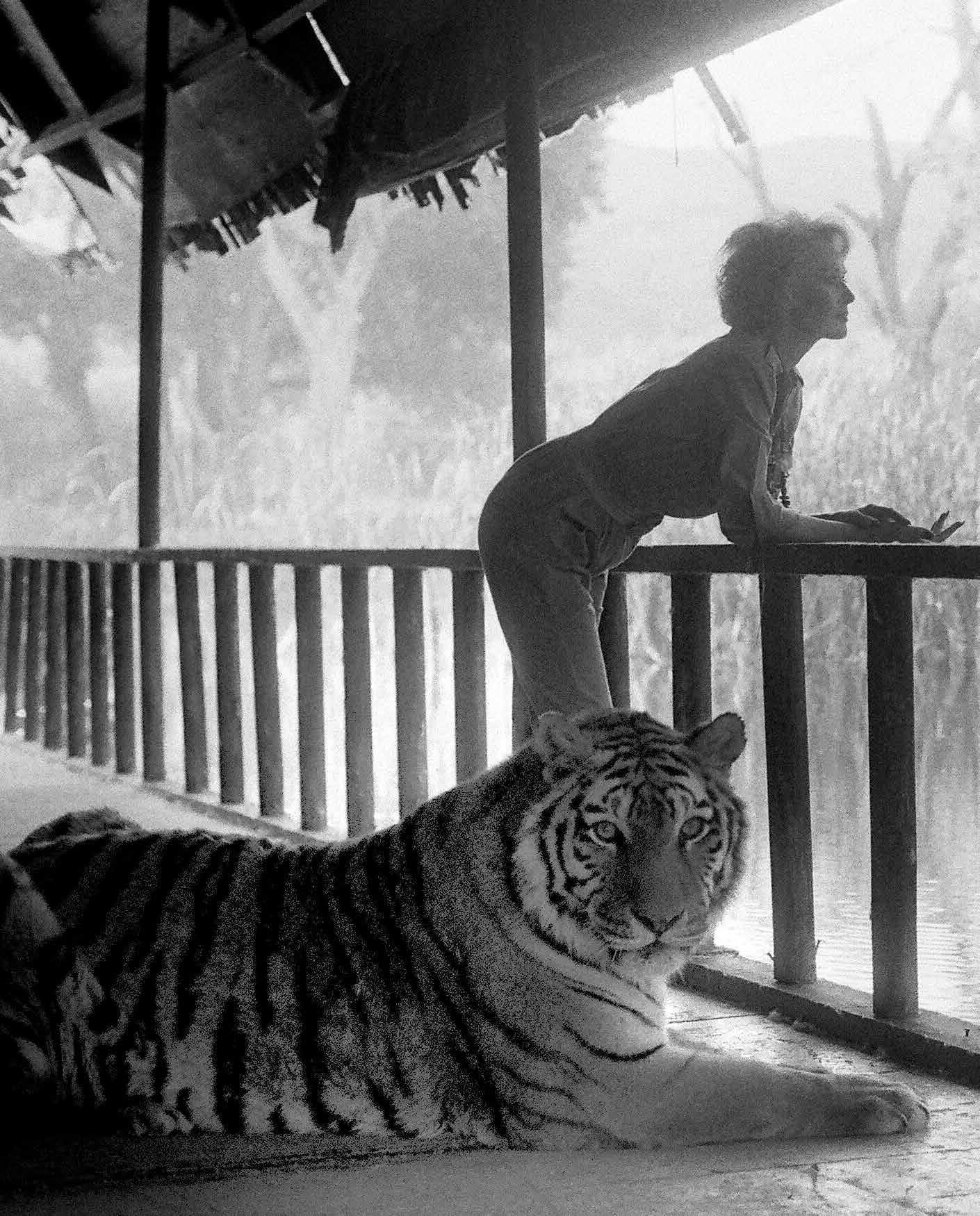

Hedren poses with a tiger during a photo shoot held in 1991 at her Shambala Preserve a refuge for big cats in Acton, Northern California. PHOTOGRAPH BY MICHAEL TIGHE/DONALDSON COLLECTION/GETTY IMAGES

UNTIL ONE HAS LOVED AN ANIMAL, A PART OF ONE’S SOUL REMAINS UNAWAKENED.”
—ANATOLE FRANCE FRENCH POET, JOURNALIST & NOVELIST
Her work was pivotal in shifting public perceptions, challenging the idea that wild animals could be domesticated. Additionally, Hedren campaigned for stricter legislation to regulate the breeding and sale of big cats. Her efforts contributed to the passage of the Captive Wildlife Safety Act in 2003, which restricted interstate sales of big cats as pets.
Living with Lions
For Hedren, life with cats was as challenging as it was rewarding. Unlike domesticated pets, lions and tigers retained their primal instincts, making them unpredictable. Hedren described her relationship with them as a delicate balance of trust and respect. “You never lose sight of the fact that they are wild,” she once said.
Yet, Hedren also formed profound bonds with the animals under her care. She recounted moments of tenderness—a lion resting its head in her lap or a tiger greeting her with a low, affectionate rumble. These interactions underscored the complexity of the animals’ nature: fierce and untamed, yet capable of connection. However, Hedren was careful to discourage romanticized notions of cohabiting with predators. She consistently warned against keeping big cats as pets, citing their complex needs and potential for danger. Her experiences were a powerful reminder that wild animals belong in the wild, not in captivity.
A Lasting Legacy
Tippi Hedren’s dedication to big cats transcended her work at Shambala. Her advocacy reshaped the conversation around wildlife conservation, inspiring legislation and influencing cultural attitudes. Through tireless efforts, she brought attention to the ethical issues surrounding animal captivity and the importance of preserving natural habitats.
The sanctuary became a model for ethical animal care, demonstrating that even predators could live peacefully when given proper respect and care. As W Magazine observed, Hedren’s work was revolutionary during a time when animal welfare was still a nascent movement.
Hedren’s influence extended into Hollywood, inspiring filmmakers and actors to rethink their portrayal of animals. Her courage during the making of Roar and her commitment to ethical treatment earned her admiration within the industry.
A Fearless Advocate
Even in her later years, Hedren continued to speak out for animal rights. She attended events, gave lectures, and collaborated with organizations focused on conservation. In interviews, she emphasized the urgency of protecting wildlife for future generations.
Her message was clear: humanity’s responsibility is to respect and preserve the natural world. Hedren once stated, “These animals remind us of what we’ve lost, but also what we can still save.”
Tippi Hedren’s journey with big cats is a story of resilience, love, and an unwavering commitment to protecting the wild. From Roar’s chaos to the tranquil landscapes of Shambala, her life exemplifies the transformative power of compassion. She proved that one person’s determination could spark change, challenging societal norms and inspiring others to rethink their relationship with nature.
Hedren’s legacy endures through Shambala and the lives of the animals she saved. Her fearless bond with big cats remains a powerful reminder of the beauty and value of the untamed. In her words, “To love the wild is to understand its freedom and to fight for its survival.” ■
Tippi Hedren with a leopard at her San Fernando Valley compound, 1982.
PHOTOGRAPH BY SANDERSON, EDDIE/MIRRORPIX/GETTY IMAGES

WELLNESS: the BILL and COO
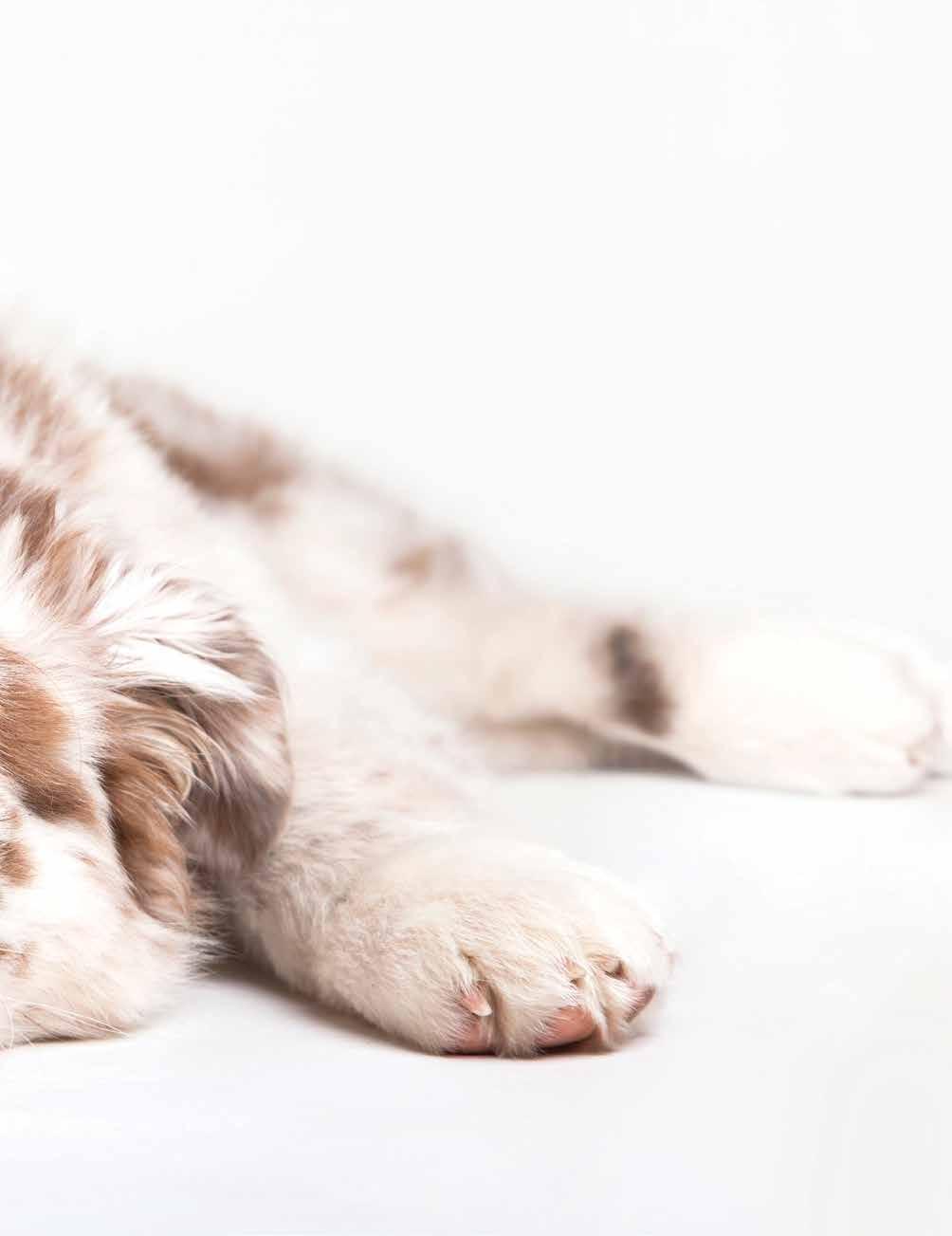
BY SONIA HENRY
enowned scientist, entrepreneur, and humanitarian Dr. Christina Rahm is celebrated for her innovative approach to improving the health and well-being of people and the planet. A passionate advocate for animal welfare, Dr. Rahm also believes that pets deserve the same level of care and attention as humans. This belief led her to create Bill and Coo, a pet wellness brand that blends her expertise in health sciences and biotechnology with a commitment to sustainability. Inspired by the common struggles of pet owners watching their furry companions suffer from ailments conventional medicine can’t seem to treat, Dr. Rahm developed human-grade nutraceuticals made from the highest quality natural ingredients, backed by scientific research, to promote optimal health in animals.
Beyond her work with Bill and Coo, Dr. Rahm manages 22 companies across 89 countries as CEO of DRC Ventures and Chief Science Formulator at The ROOT Brands. She is also deeply involved in philanthropy through The Rahm Foundation, which partners with nonprofits to create global change. Her vision for Bill and Coo extends her lifelong love for animals, aiming to offer them the same care and innovation available to humans. She noted in a recent article, “As a scientific formulator of health products for humans and a lifelong pet owner, I wanted to ensure my pets received the nutrients they needed for better health and longevity while helping them rid themselves of unhealthy toxins.” At its core, Bill and Coo is more than a pet product brand; it’s a movement to elevate how society perceives and cares for animals, rooted in compassion, innovation, and responsibility. This philosophy resonates with actor and animal advocate James

Coato, just one of the many medicinal treatments within the luxury pet brand, Bill and Coo, that is dedicated to providing pet owners and their furry friends with the best possible nutraceutical products. This innovative spray developed by scientist, Dr. Christina Rahm, with the intention of safeguarding your beloved pet from harmful substances in the environment. Coato is uniquely designed to provide a layer of defense against 5G Technology, EMF Radiation, heavy metals, viruses, bacteria, parasites, and fungi. The exclusive combination of natural components acts swiftly and effectively to shield your pet’s fur while promoting a healthier appearance and texture.
PHOTOGRAPH COURTESY BILL AND COO
Cromwell’s belief that “pets are humanizing,” reminding us of our obligation to nurture and care for all life.
What Bill and Coo Does
Bill and Coo is revolutionizing pet care by combining a love for animals and their health with scientifically developed wellness products. Its offerings cater to the physical and emotional needs of pets and their owners, emphasizing quality, innovation, and eco-consciousness. Rahm wrote, “Because of my lifelong love for animals, and my belief that they should be happy and healthy, with much longevity, I created an animal nutraceutical line …that primarily helps protect pets from aging and disease, improves skeletal, digestive, and metabolic health, while utilizing trace minerals and nutrition (including all ingredients listed above) to maintain DNA integrity for proper cell function.” The products include:
1. Animal Nutraceuticals: Bill and Coo’s scientifically crafted supplements address a variety of pet health concerns, including digestion, immunity, and joint care. These products are made with human-grade ingredients and reflect the brand’s commitment to safety and efficacy. One of these supplements, Pure Clean Pets, utilizes concentrated minerals, Vitamin C as ascorbic acid, and a proprietary blend of orthosilicic acid to safely remove environmental toxins and heavy metals from pets’ systems.
2. Protective Health Solutions: Products like “Coato,” an innovative spray that shields pets from environmental toxins and harmful microorganisms, highlight the brand’s forwardthinking approach to pet wellness. Coato is uniquely designed to provide a layer of defense against 5G Technology, EMF Radiation, heavy metals, viruses, bacteria, parasites, and fungi, and is formulated from a combination of natural components that act swiftly and effectively to shield a pet’s fur while promoting a healthier appearance and texture.
The brand also adheres to its founder’s guiding principles of sustainability and fostering an environment that values community and education. Using sustainably sourced materials and eco-friendly packaging to minimize its environmental footprint, Bill and Coo reinforces its commitment to nurturing pets and the planet. “Sustainability is more than a buzzword,” says Rahm. “It’s a necessary shift in how we live and care for our planet. Our health is intricately connected to the earth, from the water we drink to the air we breathe. In my product formulations, I’m committed to sustainable, eco-friendly practices that respect people and the planet. Together, through conscious choices, we can ensure a healthier world for future generations and ourselves. Whether it’s reducing single-use plastics or choosing eco-friendly brands, every choice counts.”
Bill and Coo also serves as a resource hub for the animalloving community, educating pet owners on holistic animal health and fostering an environment dedicated to better care for all pets. With a variety of blogs and videos featured on its
website, Bill and Coo ensures that pet owners are up to date on animal diseases such as diabetes or peritonitis, pet safety issues, such as keeping your furry friends safe on Halloween, or general well-being issues, such as avoiding obesity and enhancing the life of elderly pets. These offerings meet consumer demand for high-quality pet products and champion a deeper understanding of animal health and wellness.
Mission and Cultural Impact
Bill and Coo reflects the evolving role of pets in modern society, where they are valued not just as companions but as integral members of the family. By merging luxury with wellness, the brand addresses the growing demand for products that enhance the lives of pets while strengthening the bond between pets and their owners. And Dr. Rahm’s leadership ensures that the brand remains grounded in integrity and science. Through her work, she has positioned Bill and Coo as a pioneer in the pet care industry, emphasizing that compassion and innovation can coexist.
Including sustainable practices and community-driven initiatives underscores the brand’s holistic mission. It’s not just about offering premium products—it’s about contributing to a larger movement that advocates for animal welfare, environmental preservation, and ethical responsibility.
A Science-Driven Approach
Dr. Rahm’s extensive background in healthcare and biotechnology is evident in every aspect of Bill and Coo’s product development. With rigorous attention to detail and a focus on evidence-based solutions, she ensures that the brand’s offerings meet the highest standards of quality and innovation. This scientific foundation sets Bill and Coo apart in a market often dominated by trends over substance.
As Bill and Coo grows, its future remains rooted in innovation, sustainability, and compassion. Dr. Rahm envisions the brand as a platform that redefines how society approaches animal care. By focusing on holistic wellness, ethical practices, and community engagement, Bill and Coo is poised to make a lasting impact on pets and their families worldwide.
It is clear that Bill and Coo is more than a brand—it’s a testament to the transformative power of care, science, and a deep and abiding love for our animal companions. Guided by the wisdom that pets are integral to humanizing and nurturing our world, the company exemplifies a harmonious blend of compassion and innovation, and with Dr. Christina Rahm at its helm, Bill and Coo continues to inspire a world where all life is valued and cherished. ■
Editor’s note: To learn more, visit their website at https://www. billandcoobydrc.com or watch their story on YouTube at https:// www.youtube.com/watch?v=QYrEewr08Xc.
Founder of Bill and Coo, Dr. Christina Ralm, with beloved family pet Goldendoodle, Tilly, the inspiration behind the Bill and Coo logo. PHOTOGRAPH COURTESY BILL AND COO
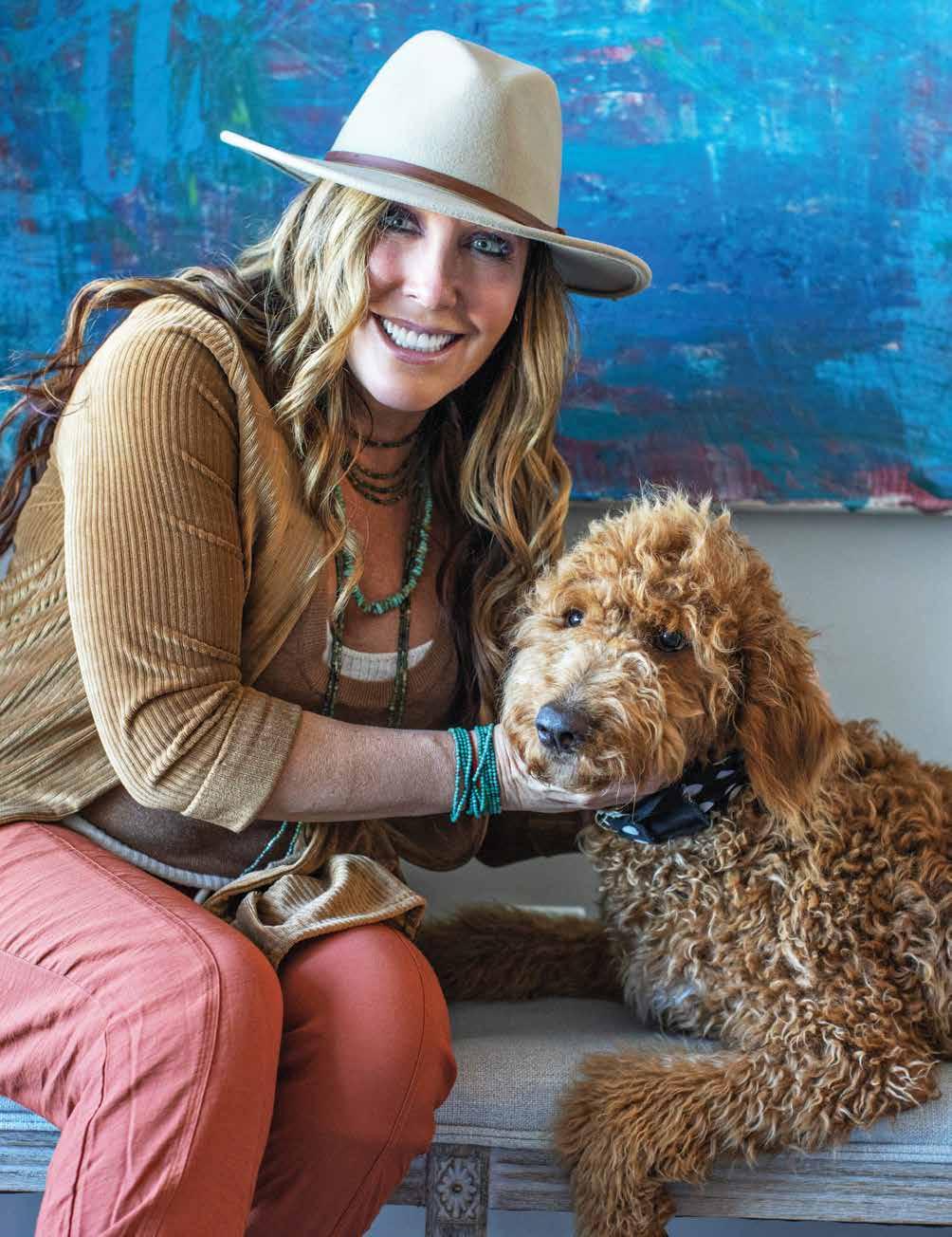


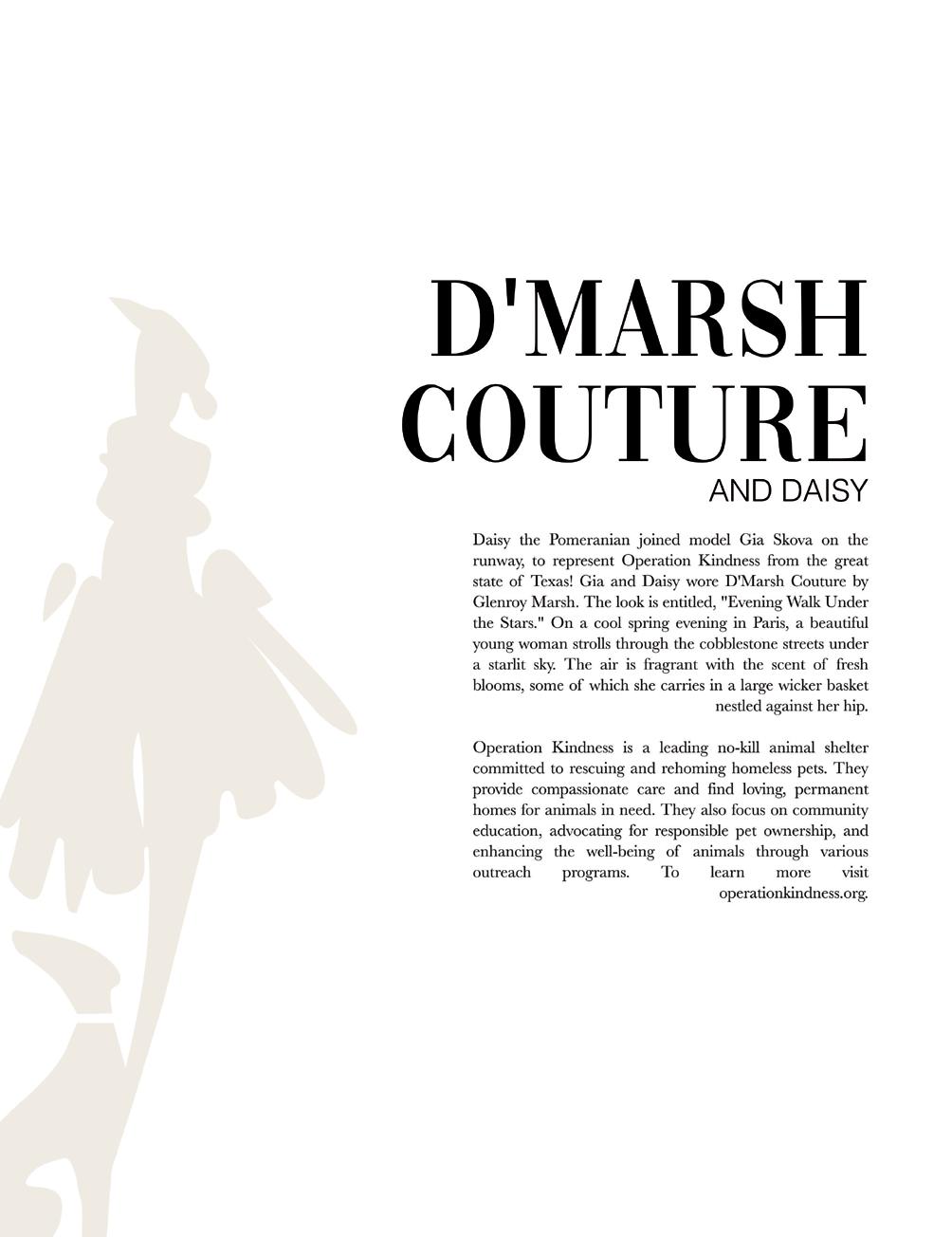
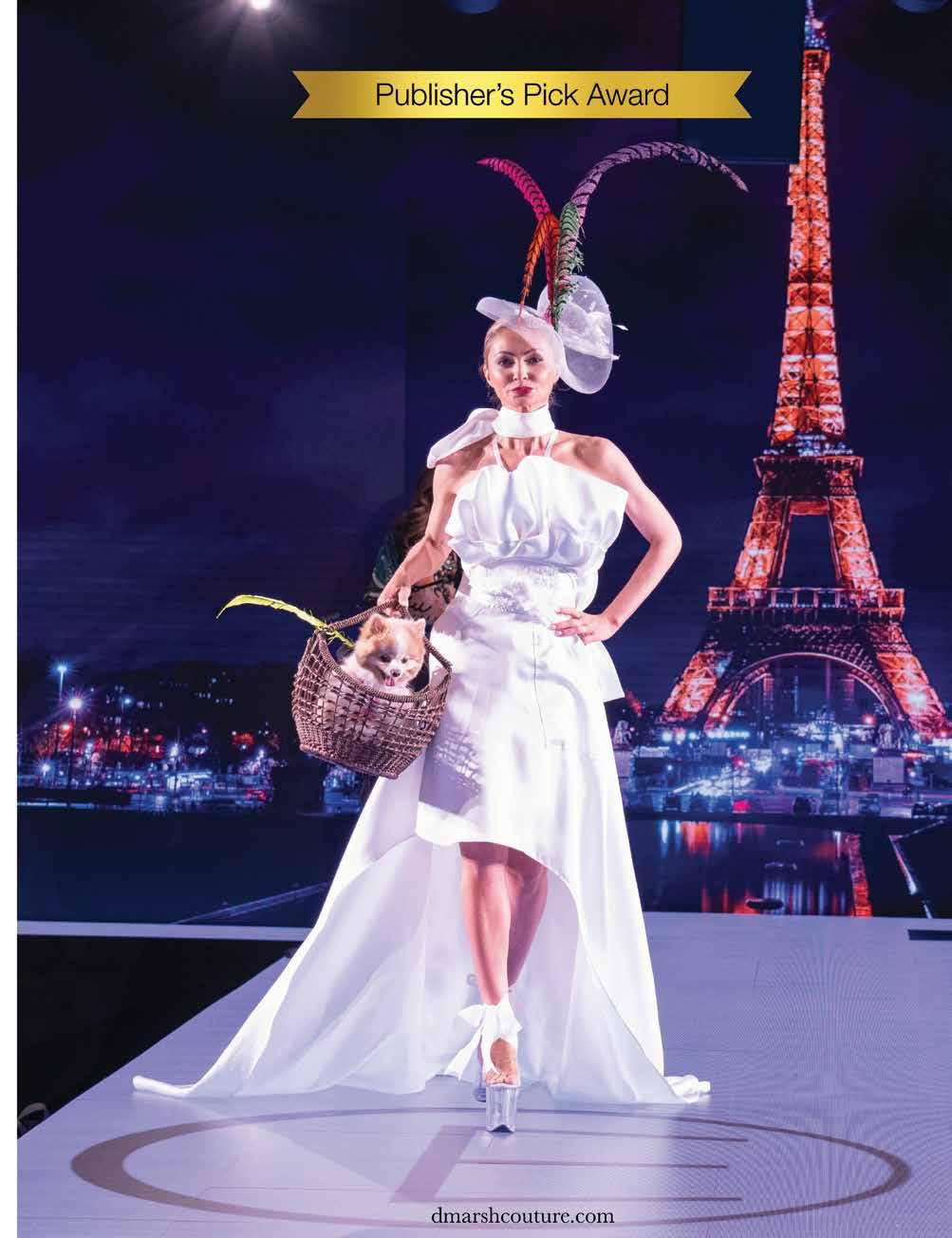


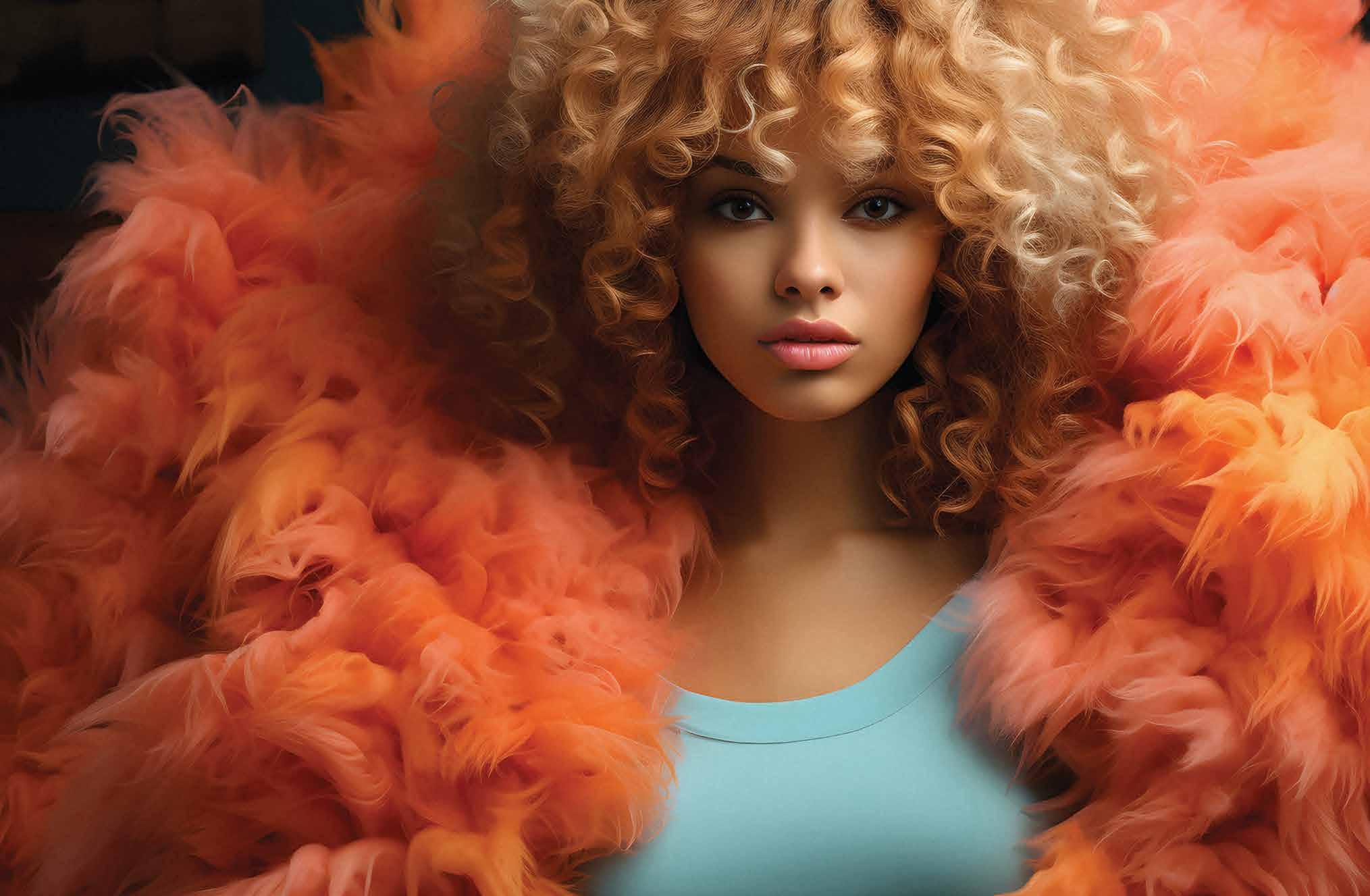

The Unapologetic Woman’s Tequila
Fierce women from coast to coast are slamming the door on wine and toasting life’s occasions with a bold new spirit. Artfully crafted with attitude, a pinch of sweetness, and packed with personality, BIATCH premium tequilas make a grand statement. Cheers, darling. BIATCH.COM
BIATCH is women-owned and committed to women’s empowerment.






LIMITED EDITION BOTTLE ROSA TEQUILA









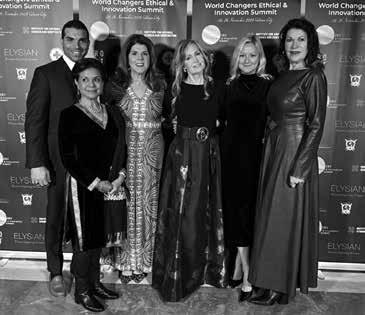


Inthe eternal city of Rome, where history and humanity converge, ELYSIAN unveiled its 2024/25 Winter “Peace on Earth” issue honoring St. Mother Teresa of Calcutta and hosted a private screening of the documentary Ukraine: For the Children. Against the majestic backdrop of Vatican City’s Pontifical Residences, the World Changers Summit brought together thought leaders and innovators to redefine social responsibility and celebrate the transformative power of love over power in the pursuit of global peace. ■

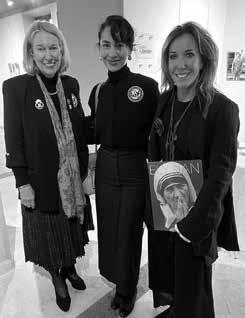

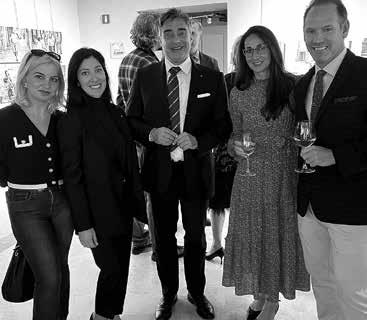
beautiful view of Vatican City,
Italy, the site of
BY ACKAB PHOTOGRAPHY /S HUTTERSTOCK.COM • Row two – 1st image: Clayton Thomas of DRC Ventures and The Root Brands, speaks with guest attending the event. 2nd image: Karen Floyd debuts the Winter issue of ELYSIAN. 3rd image: Karen Floyd with ELYSIAN Winter “Inspiring Woman” Chitra Narayanan, ELYSIAN Digital Innovatior Joey Iannetta. 4th image: Alda Gashi, Chitra Narayanan, Mary Beth Jacoby, ELYSIAN Social Media Manager Michelle Young. • Row three – 1st image: Joey Iannetta, Chitra Narayanan, Michelle Young, Karen Floyd, ELYSIAN Special Events Director Sara Smith, Mary Beth Jacoby. 2nd image: Karen Floyd, Sir Gabriele Pao-Pei Andreoli, Alda Gashi. 3rd image: Bonnie, Carroll, Fatma Megrahi, Dr. Christina Rahm. 4th imaage: Arta Feta, Alda Gashi, Sir Gabriele Pao-Pei Andreoli, Denise Montagnino, Jesse Montagnino.
A
Rome,
ELYSIAN’s Winter 2024/25 “Peace On Earth” issue launch. PHOTOGRAPH



